CELEBRATING 25 YEARS OF A HOME FOR BUTTERFLIES
This is a chronological pictorial account of the project, that initially began as an ambitious hobby in July # 1997, but over the years has grown to be a significant conservation exercise with astounding results.
1997
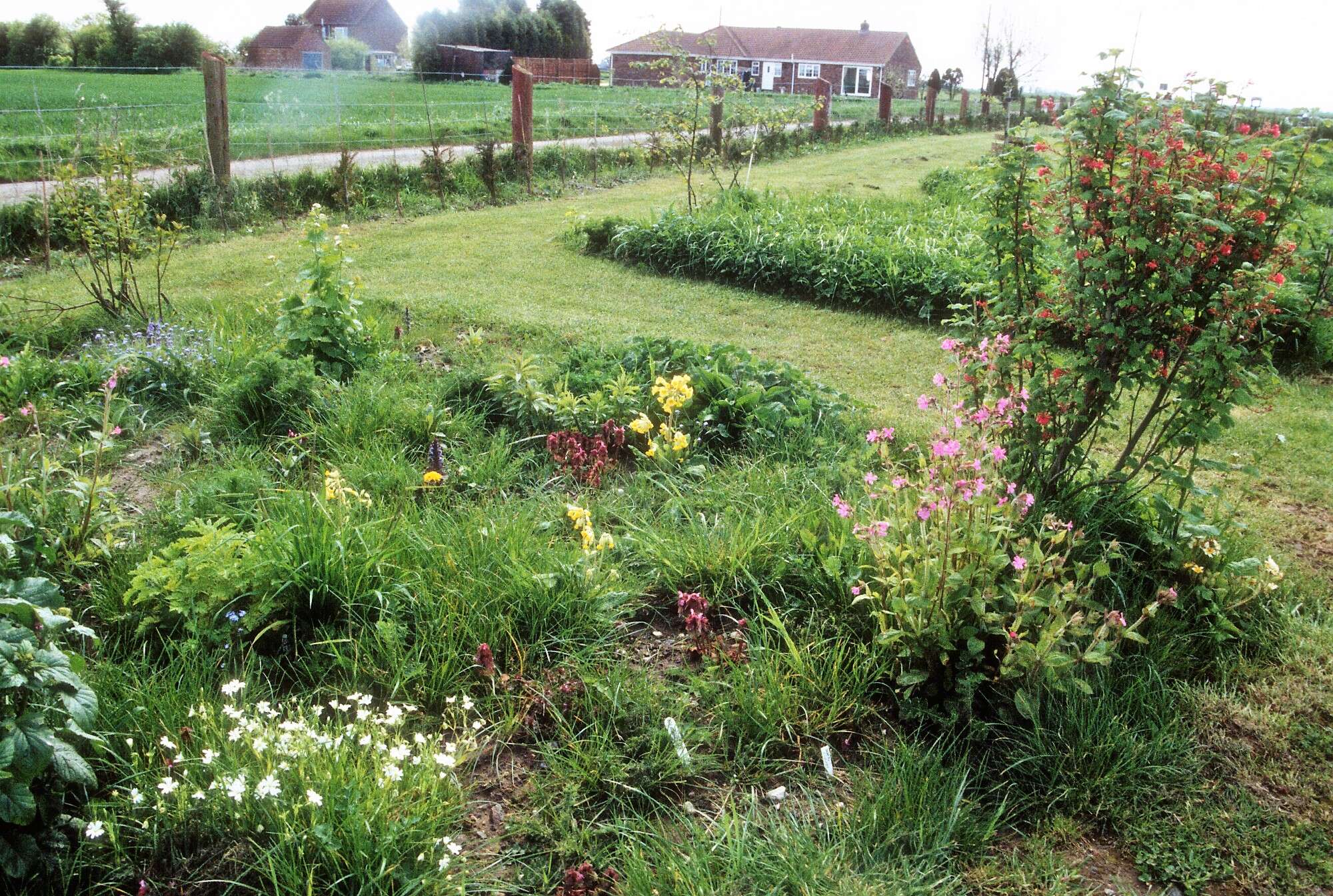 The major job from the very beginning was to provide a wealth of larval and nectar plants throughout.
The major job from the very beginning was to provide a wealth of larval and nectar plants throughout.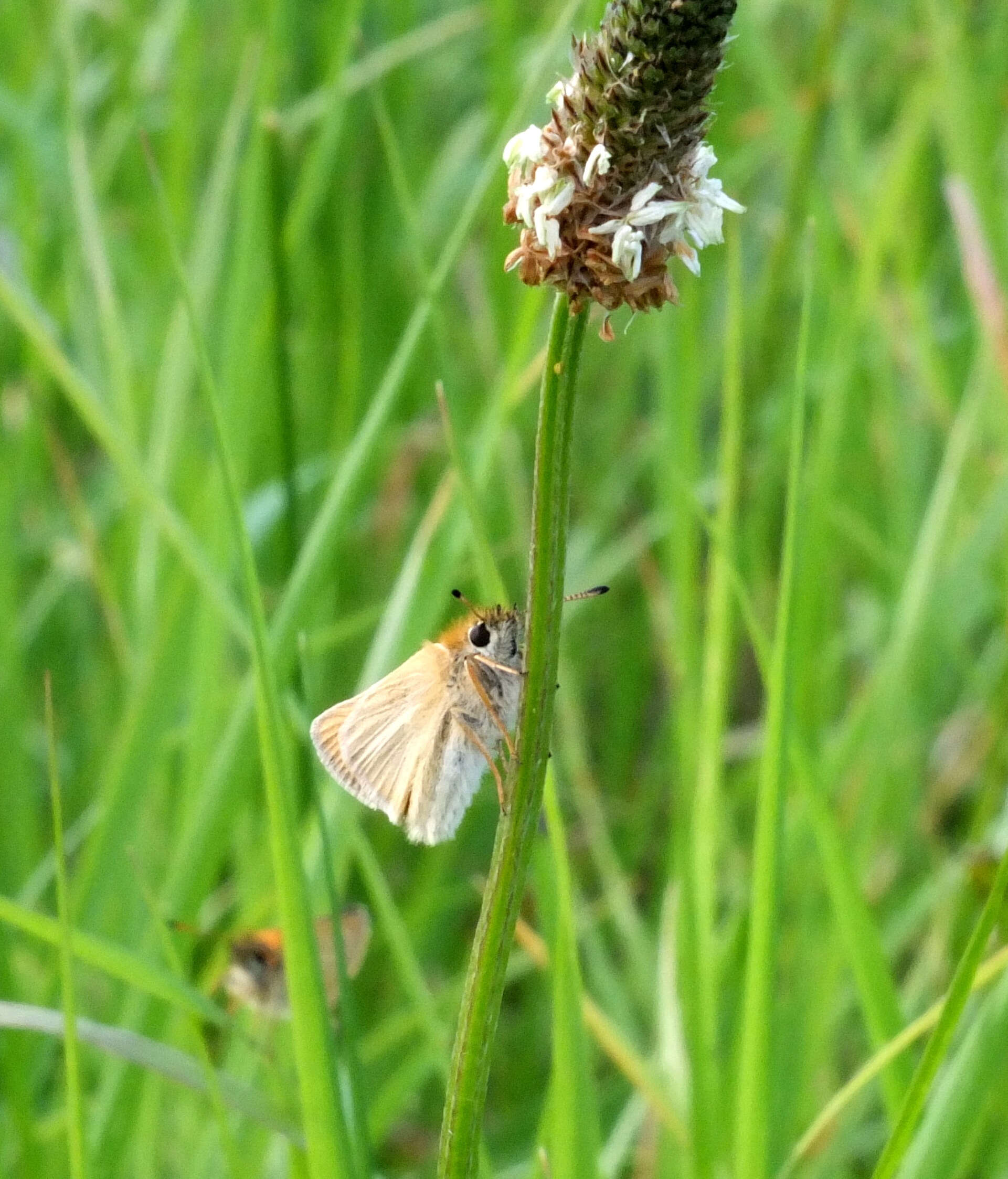 From the word go there was a healthy colony of Essex Skipper centred on the flowery dyke banks.
From the word go there was a healthy colony of Essex Skipper centred on the flowery dyke banks.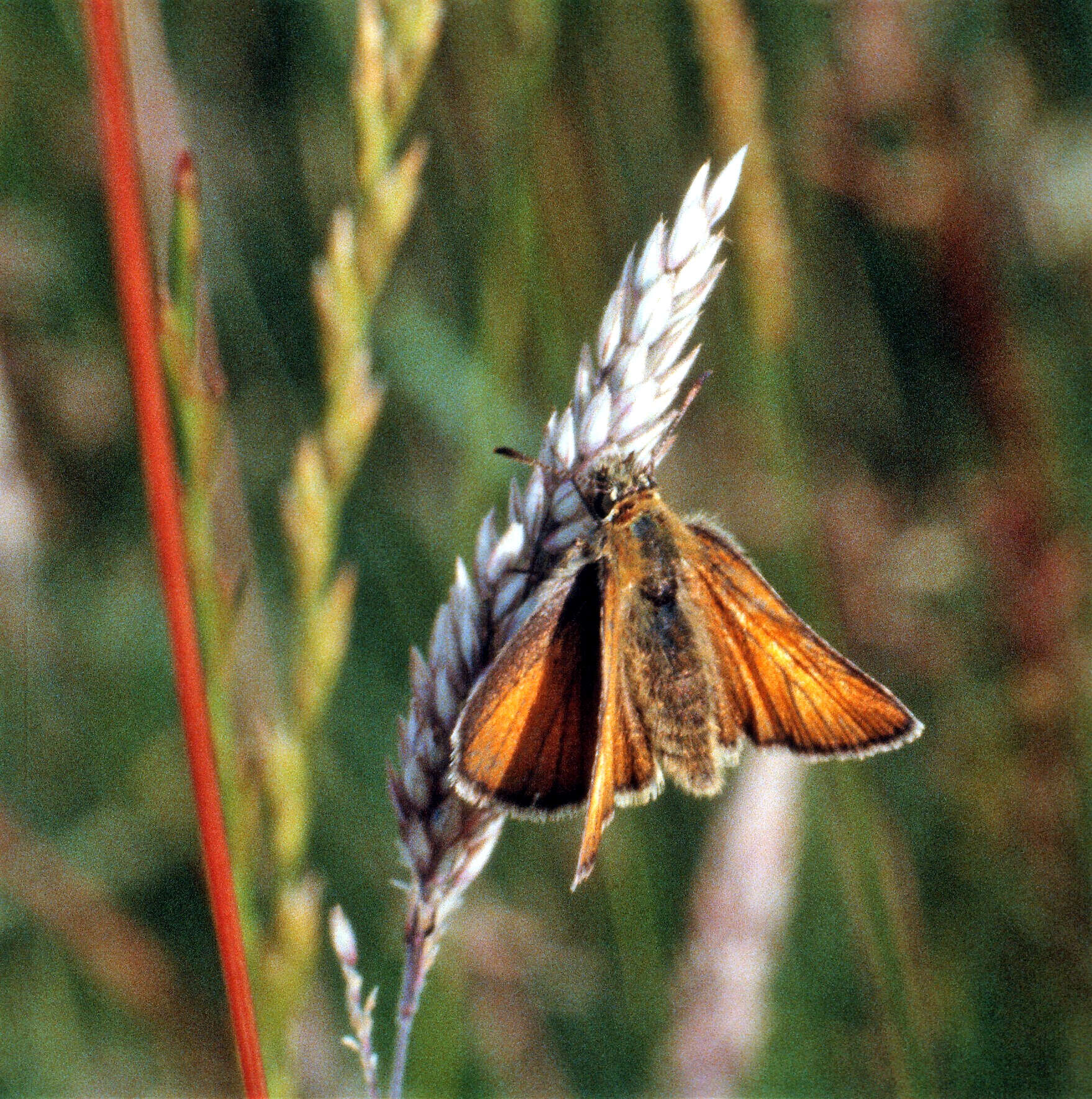 To this day the Small Skipper remains a rare sighting, despite its foodplant Yorkshire Fog grass being plentiful. A mystery.
To this day the Small Skipper remains a rare sighting, despite its foodplant Yorkshire Fog grass being plentiful. A mystery.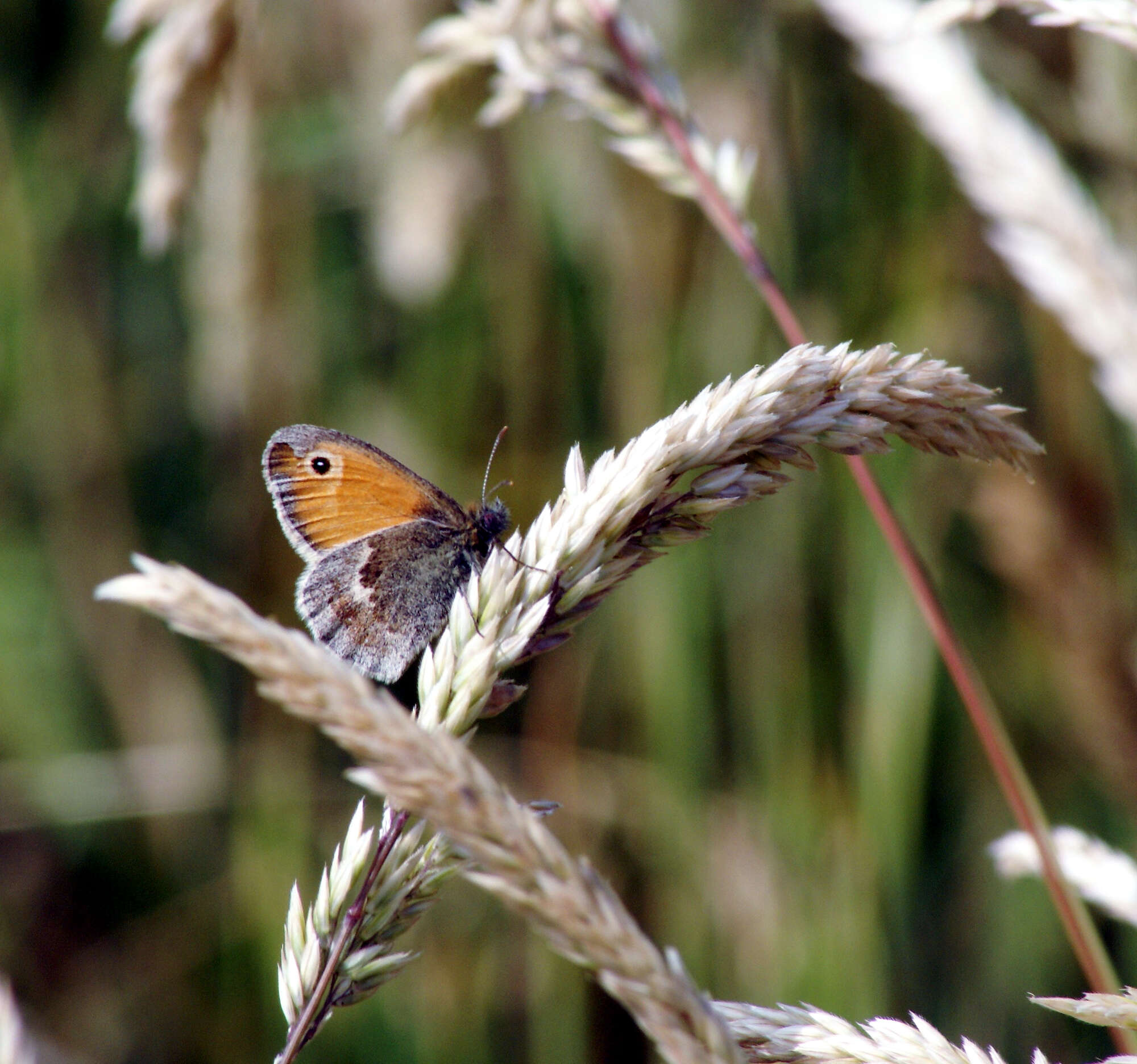 Small Heath had a small colony lasting until 2001.
Small Heath had a small colony lasting until 2001.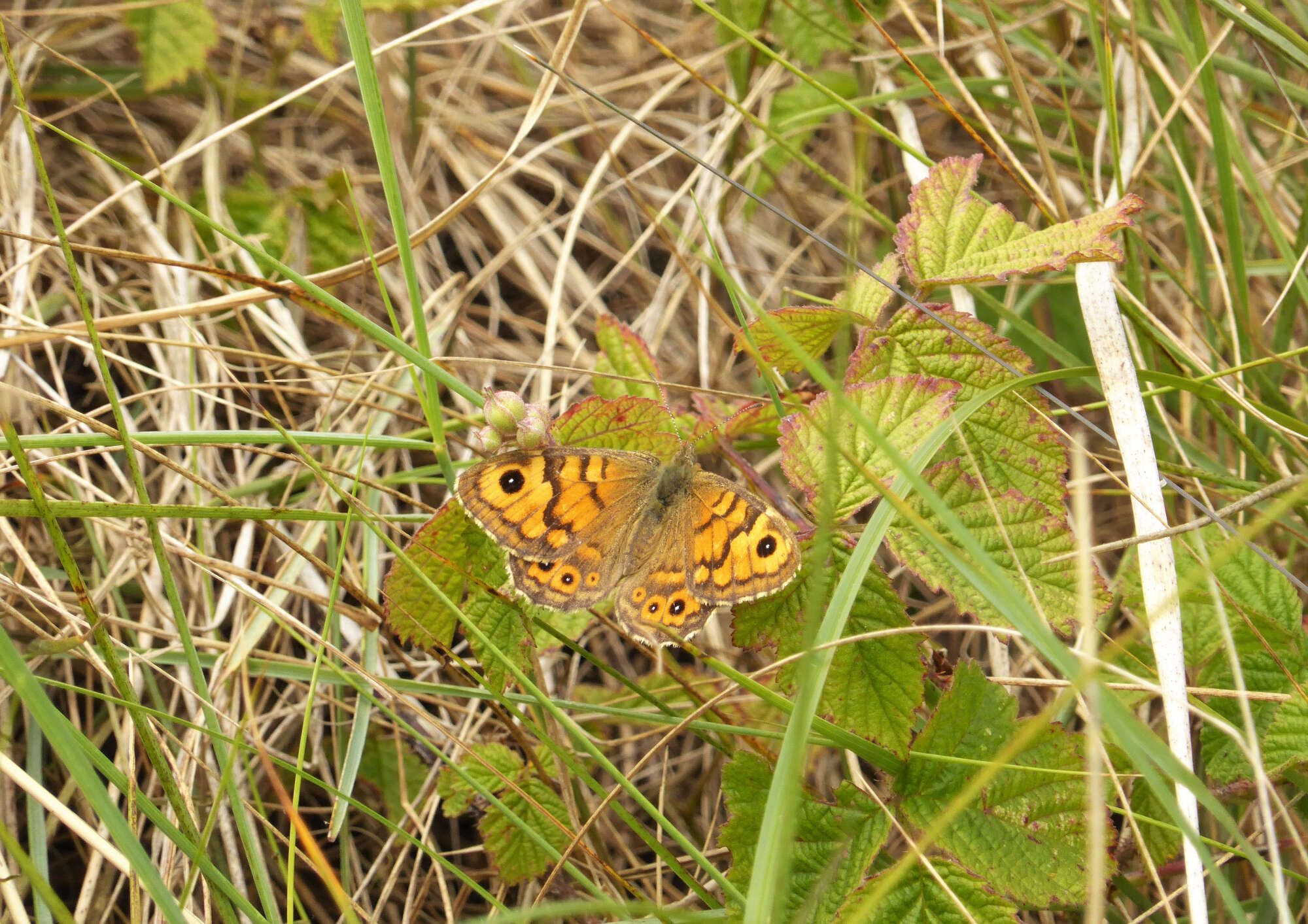 Wall Brown was initially a common resident prior to its general decline.
Wall Brown was initially a common resident prior to its general decline.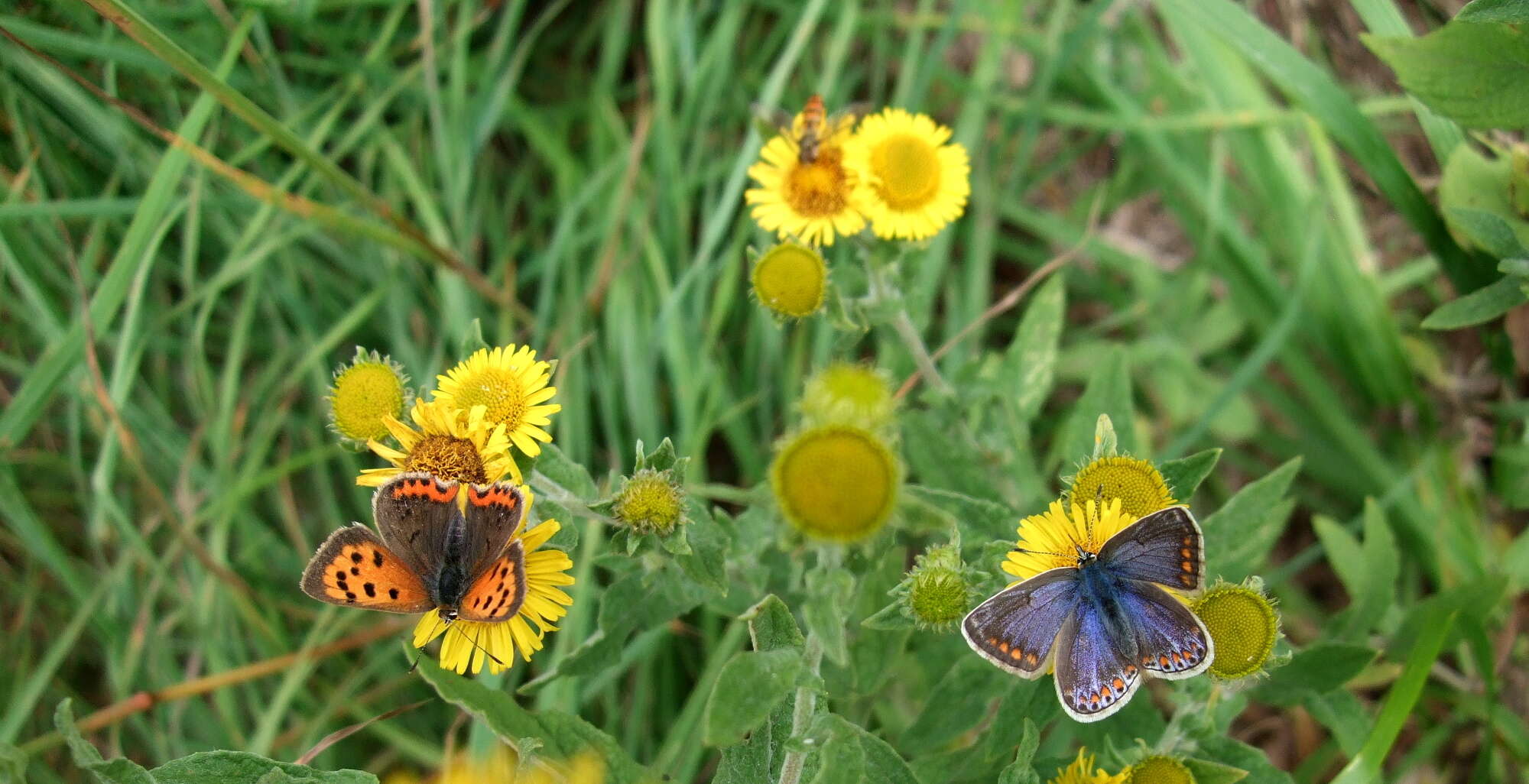 Common Blue and Small Copper showed real signs of promise.
Common Blue and Small Copper showed real signs of promise.
The others seen in our inaugural year were: Large Skipper, Brimstone, Large, Small and Green-veined Whites, Holly Blue, Red Admiral, Painted Lady, Small Tortoiseshell, Peacock, Comma, Gatekeeper, Meadow Brown, and Ringlet.
1998
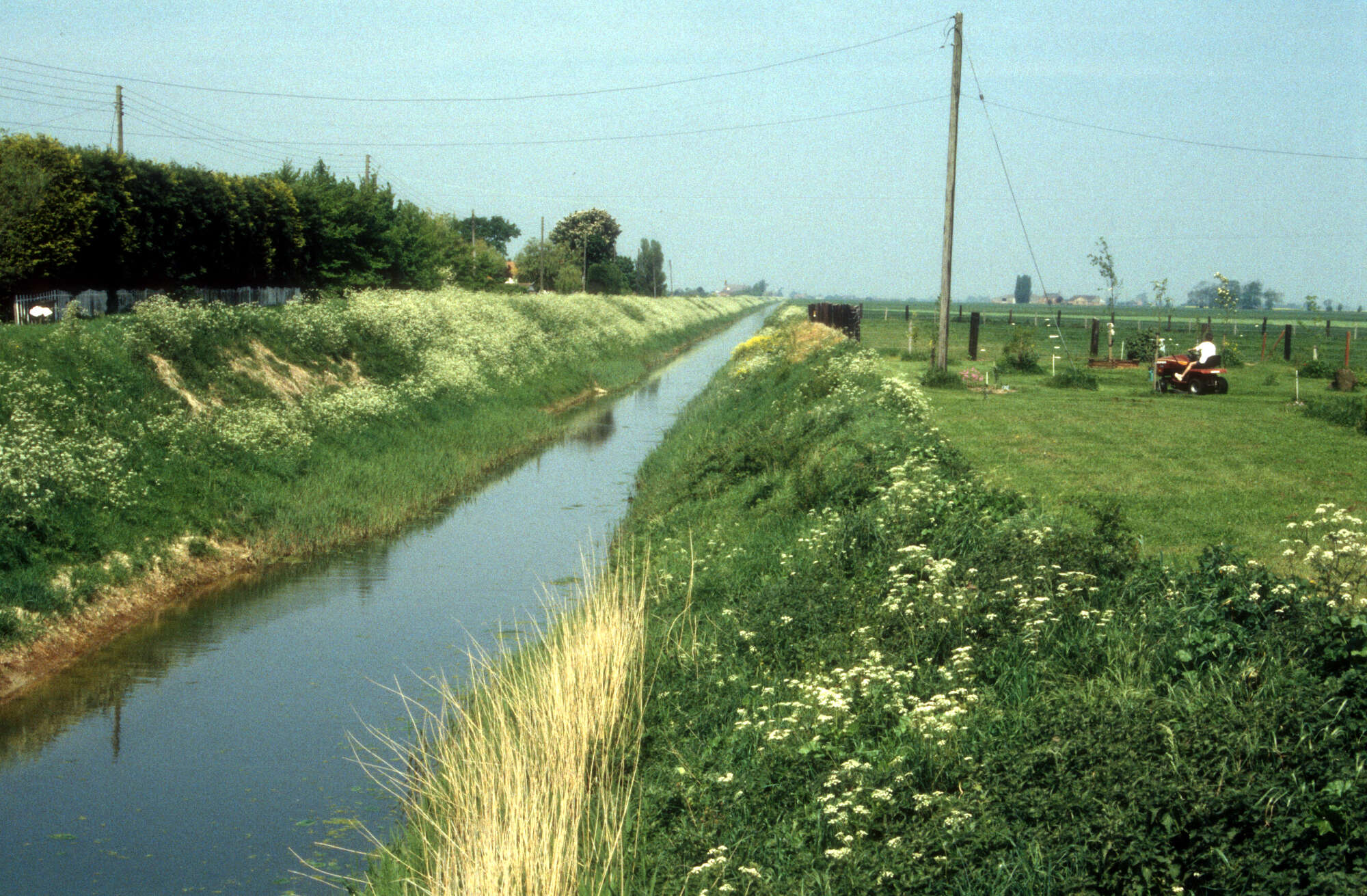 Early shot of original saplings in what would become the woodland garden adjacent to the dyke bank.
Early shot of original saplings in what would become the woodland garden adjacent to the dyke bank.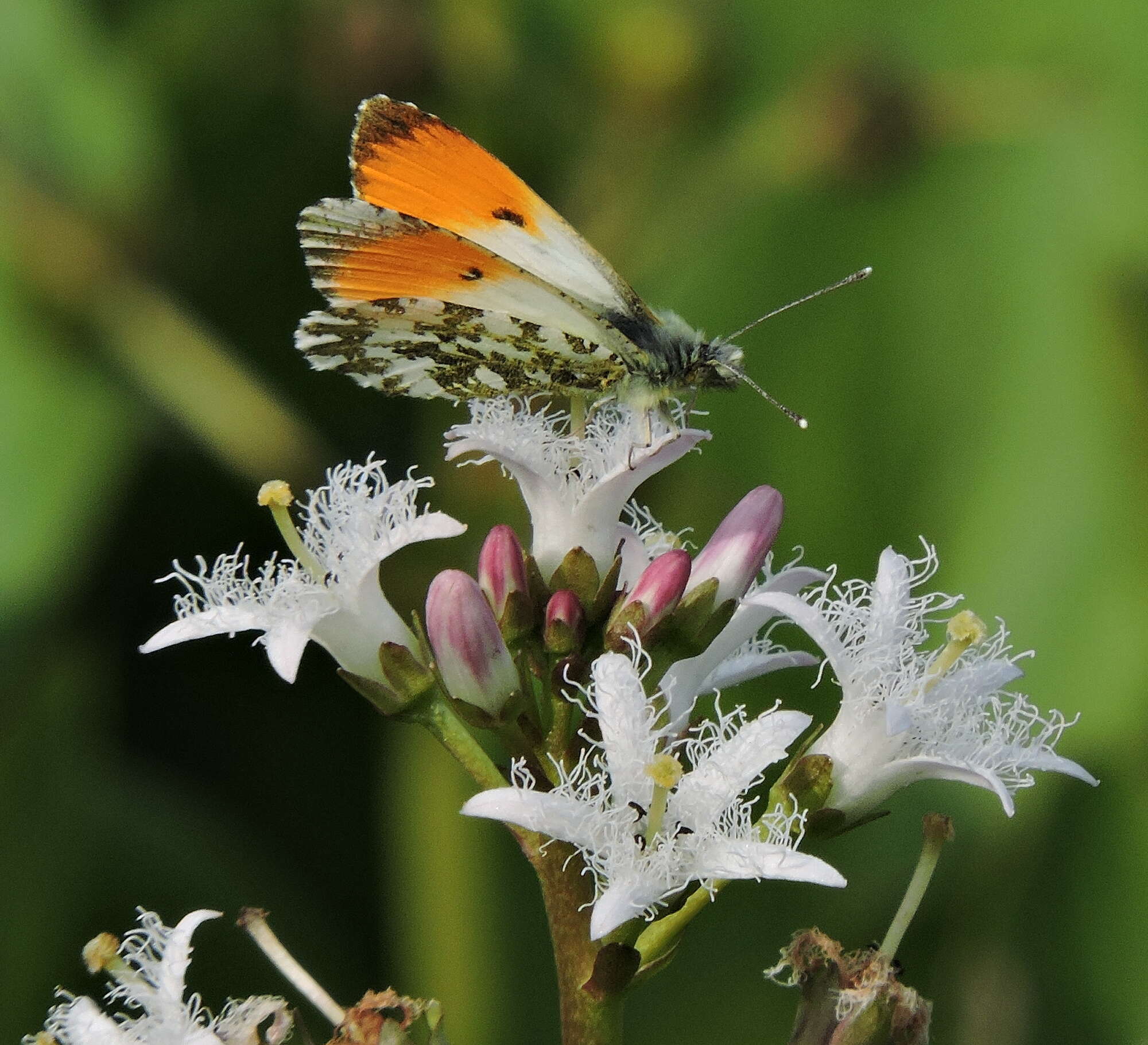 Welcome the Orange Tip to our list of residents. Being a spring butterfly, their flight period was over when we moved in last year.
Welcome the Orange Tip to our list of residents. Being a spring butterfly, their flight period was over when we moved in last year.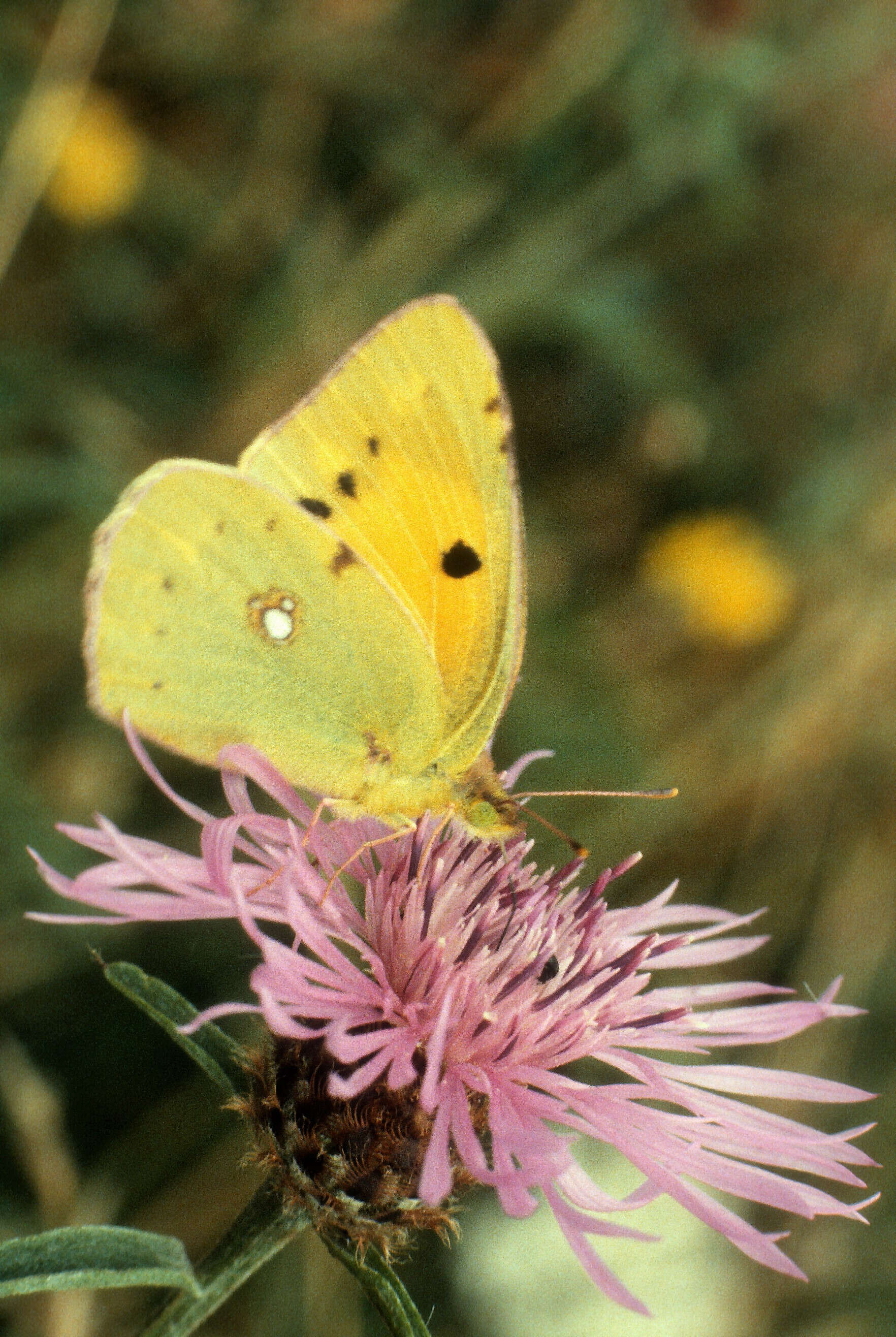 The major surprise of 1998 were three separate sightings of the less common migrant Clouded Yellow.
The major surprise of 1998 were three separate sightings of the less common migrant Clouded Yellow.
1999
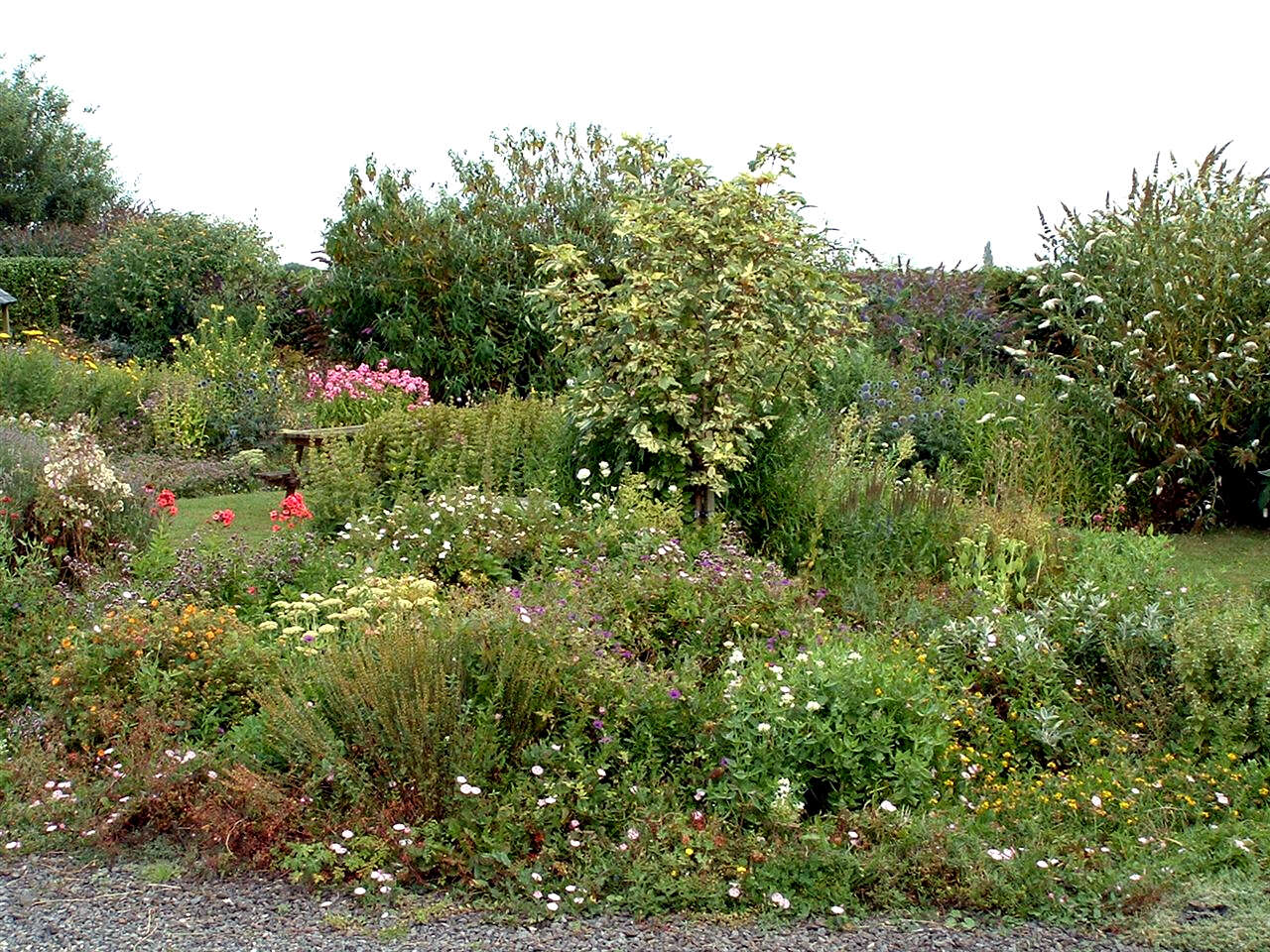 Within a couple of years the cottage garden was a blaze of colour and nectar.
Within a couple of years the cottage garden was a blaze of colour and nectar.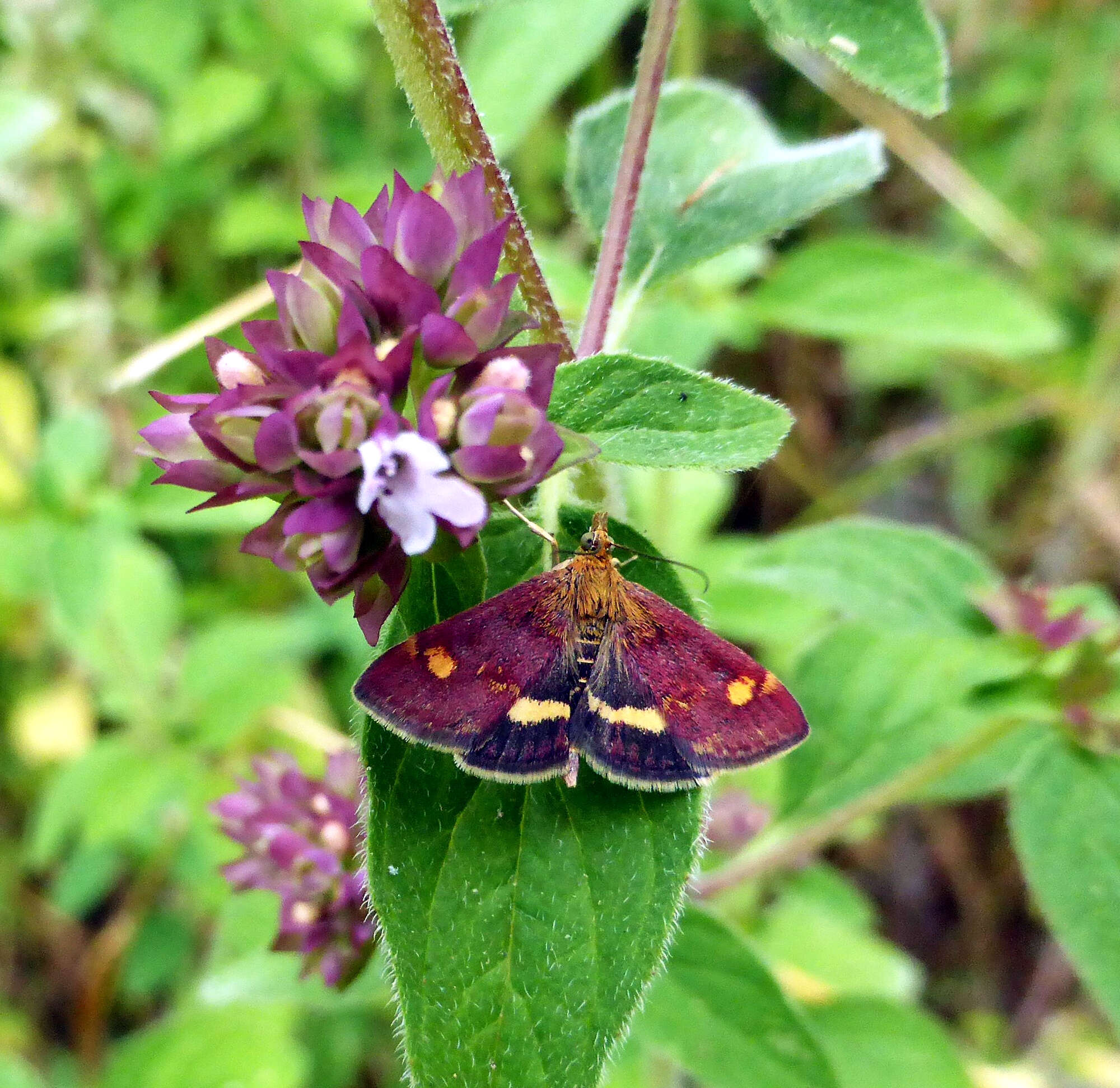 By now the Mint Moth was an established resident day-flying moth.
By now the Mint Moth was an established resident day-flying moth.
2000
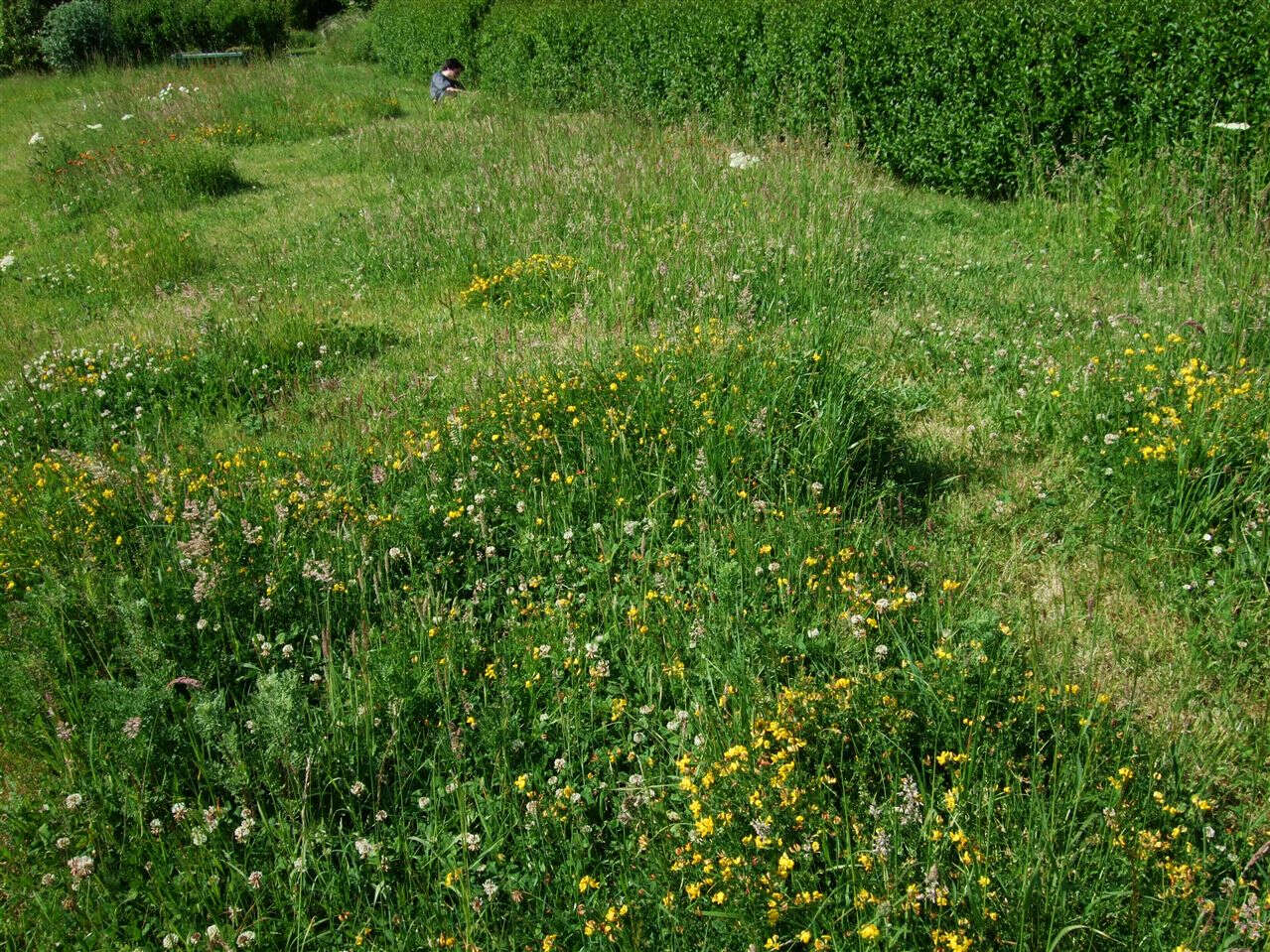 The meadow was now coming into its own, as witnessed by a female Clouded Yellow investigating the clover...
The meadow was now coming into its own, as witnessed by a female Clouded Yellow investigating the clover...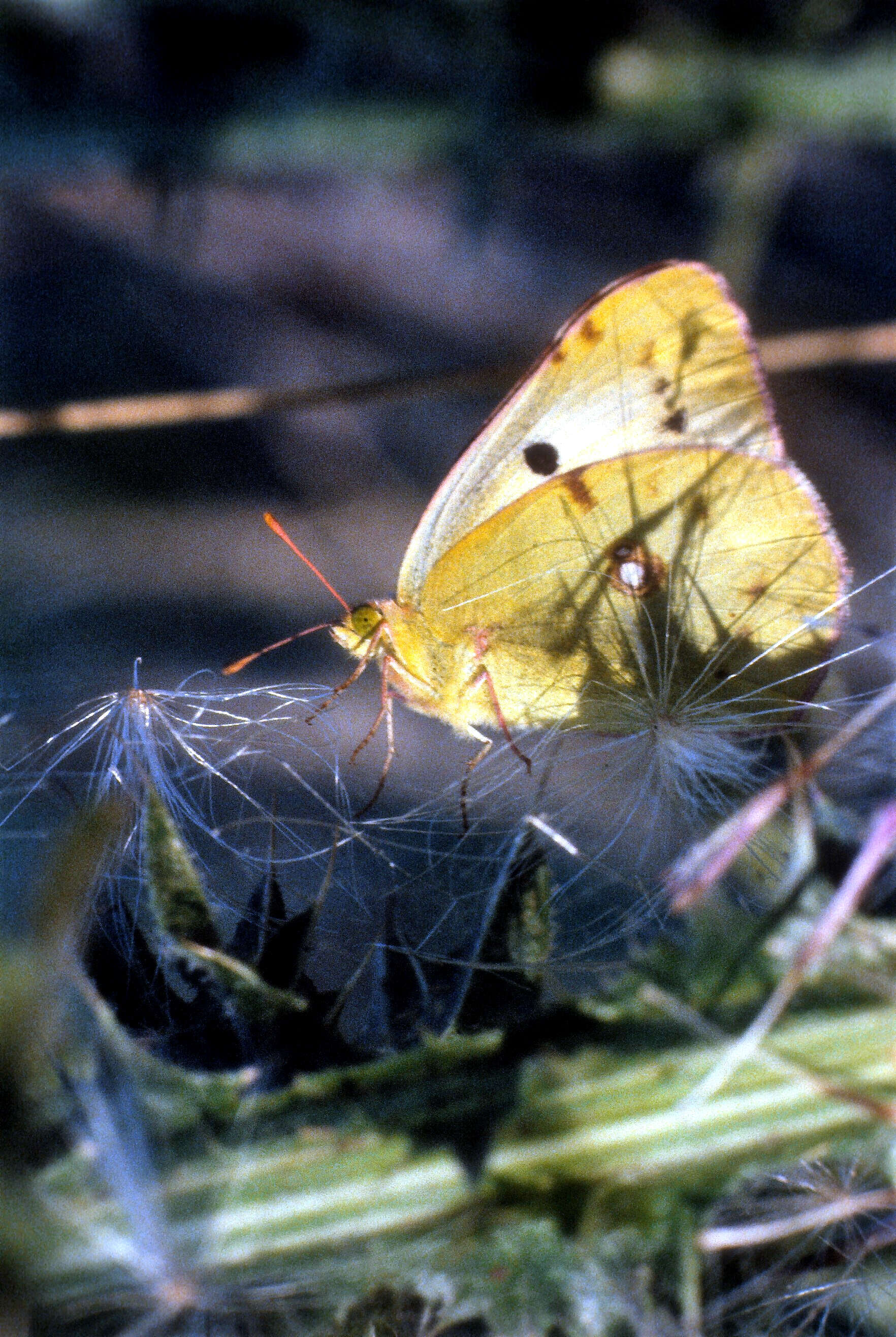 But this was no ordinary Clouded Yellow.... she was of the rare whiter form helice.
But this was no ordinary Clouded Yellow.... she was of the rare whiter form helice.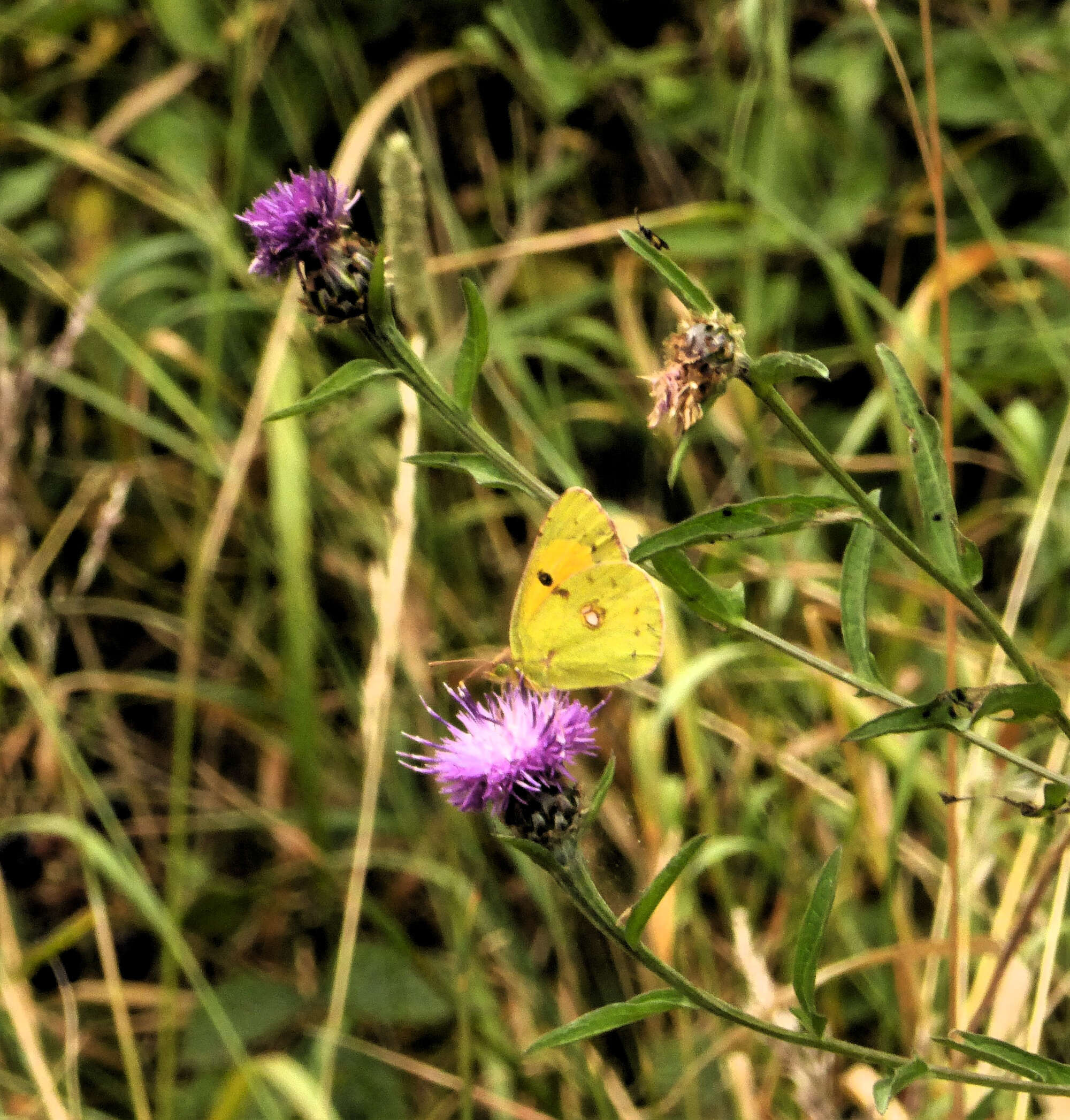 A total of 6 Clouded Yellows were seen this year, it still remains our best year for this uncommon migrant.
A total of 6 Clouded Yellows were seen this year, it still remains our best year for this uncommon migrant.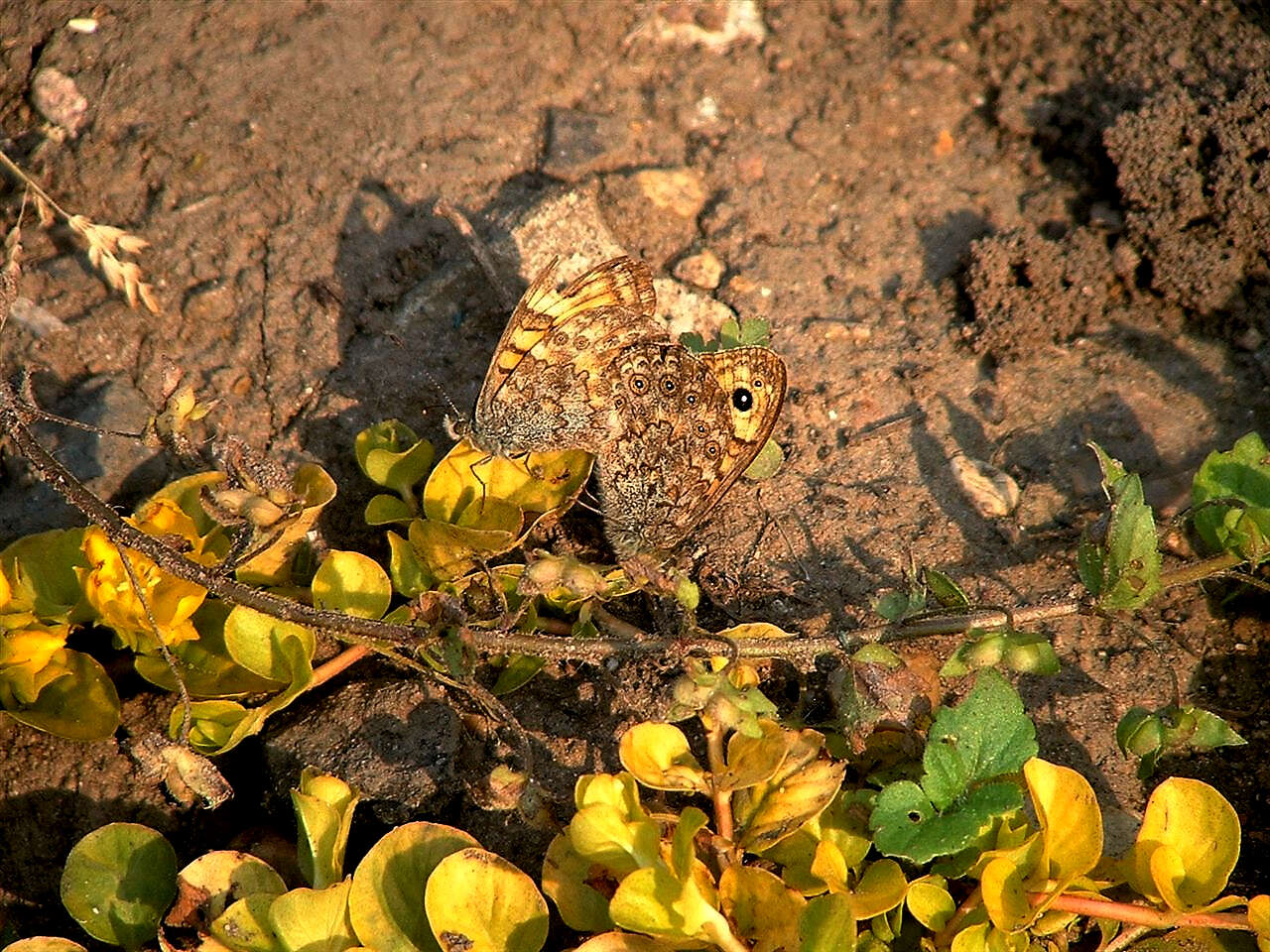 Yet it was the Wall Brown that we declared butterfly of the year, having an amazing season. Little did we know what lay ahead for it....
Yet it was the Wall Brown that we declared butterfly of the year, having an amazing season. Little did we know what lay ahead for it....
2001
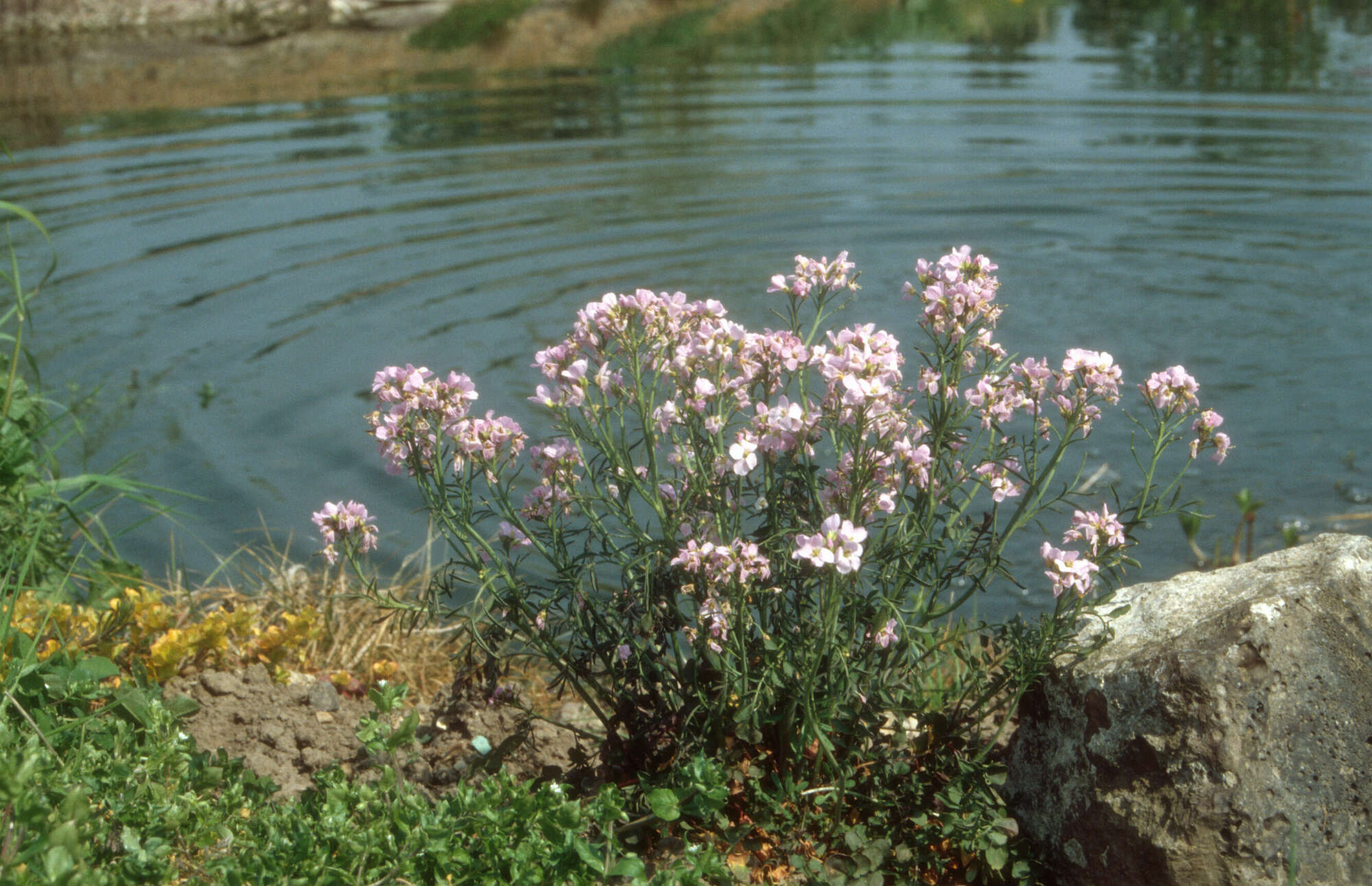 2001. Lady's smock, foodplant of Orange Tip and Green-veined White, overlooking the troublesome pond. It will have to be properly lined before long.
2001. Lady's smock, foodplant of Orange Tip and Green-veined White, overlooking the troublesome pond. It will have to be properly lined before long.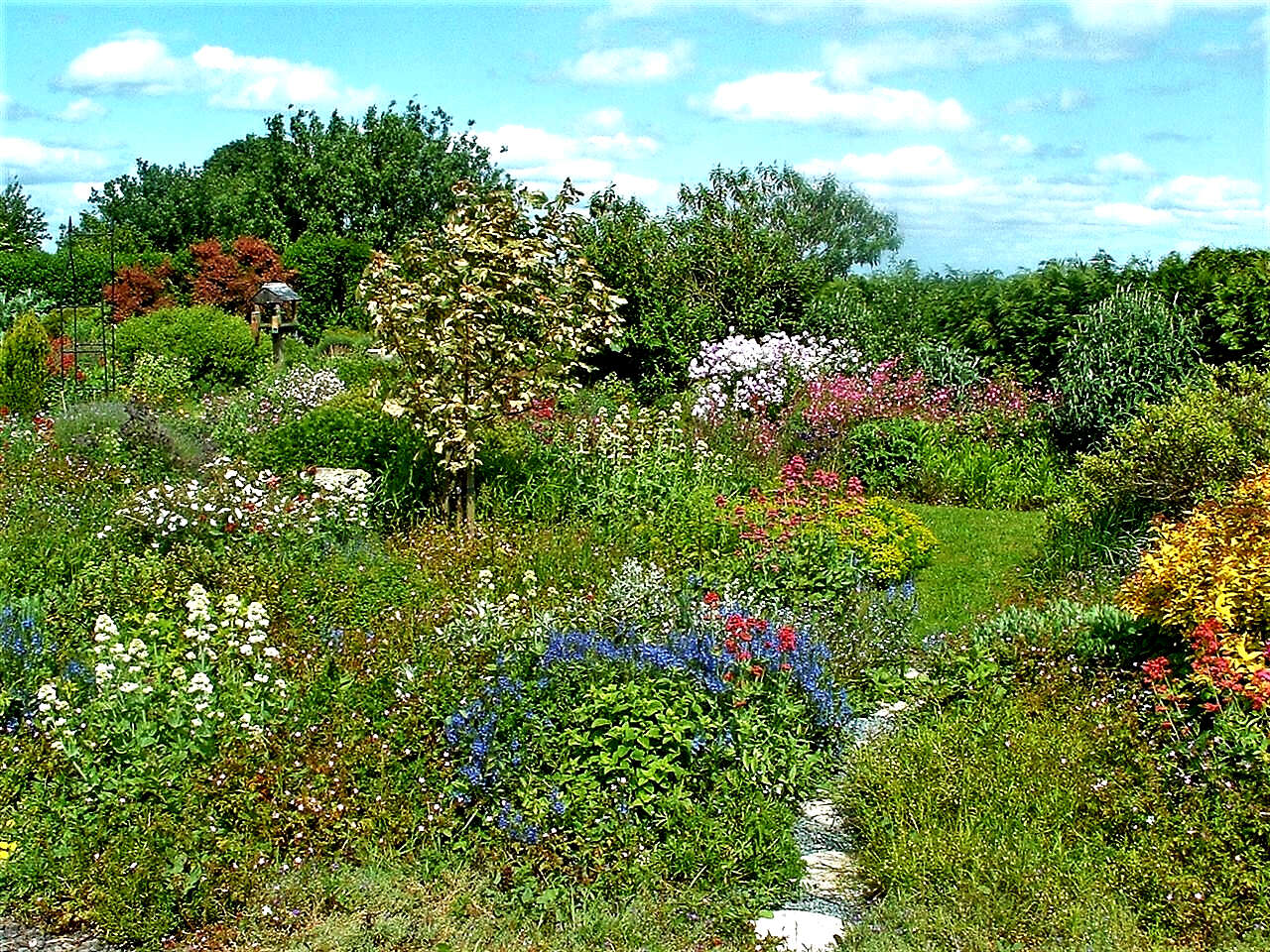 Meanwhile, the cottage garden went from strength to strength.
Meanwhile, the cottage garden went from strength to strength.
2002
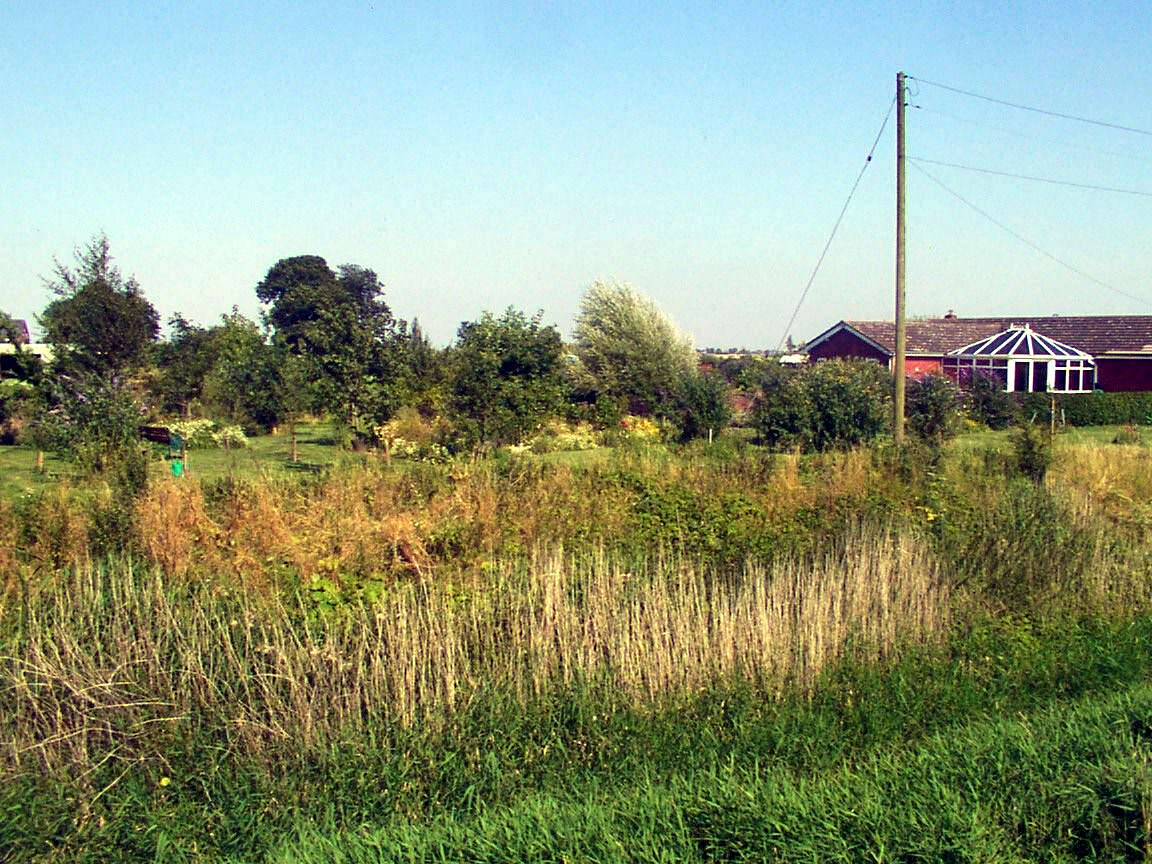 The developing woodland garden seen from over the dyke.
The developing woodland garden seen from over the dyke.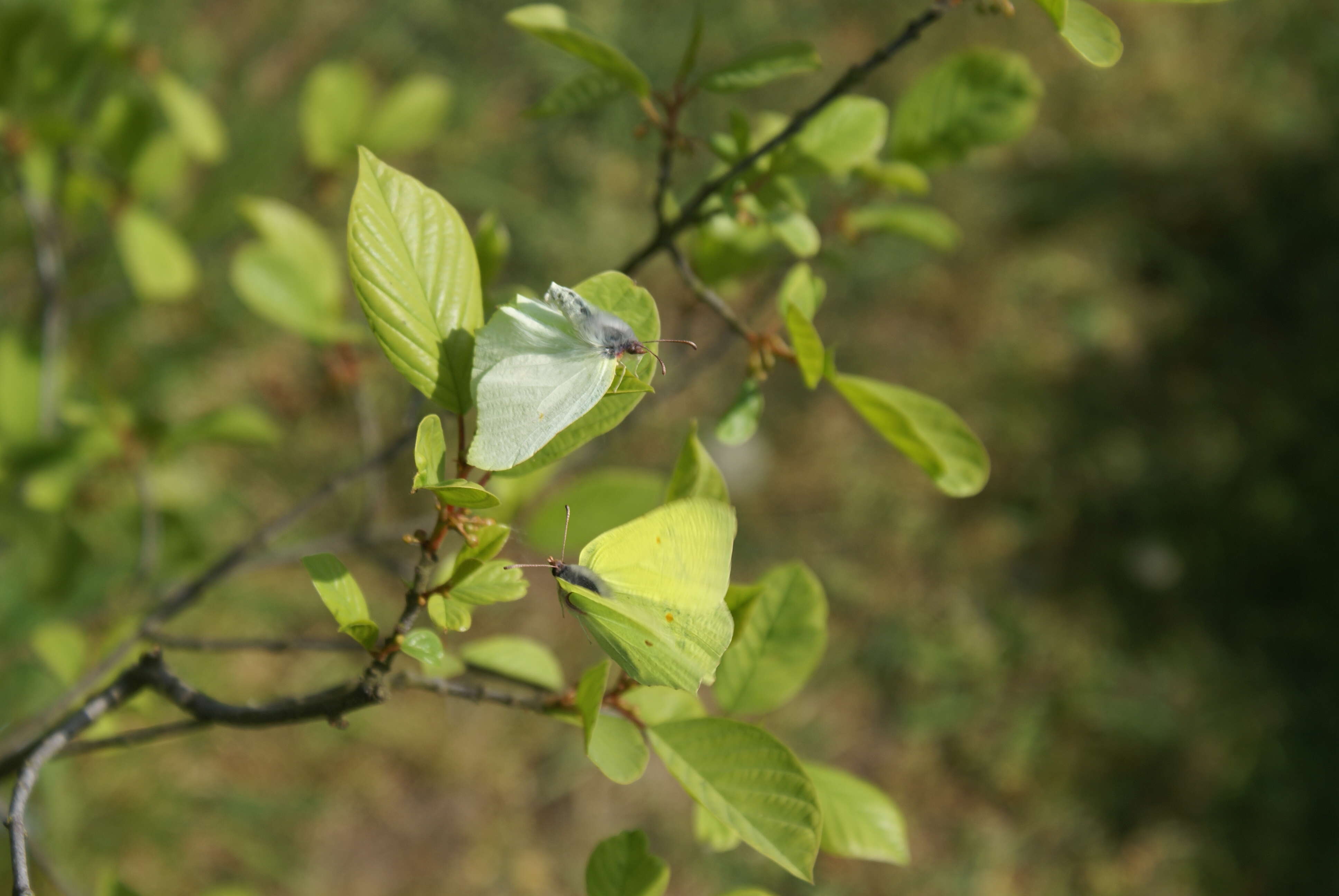 Wonderful to see the courtship antics of the Brimstone.
Wonderful to see the courtship antics of the Brimstone.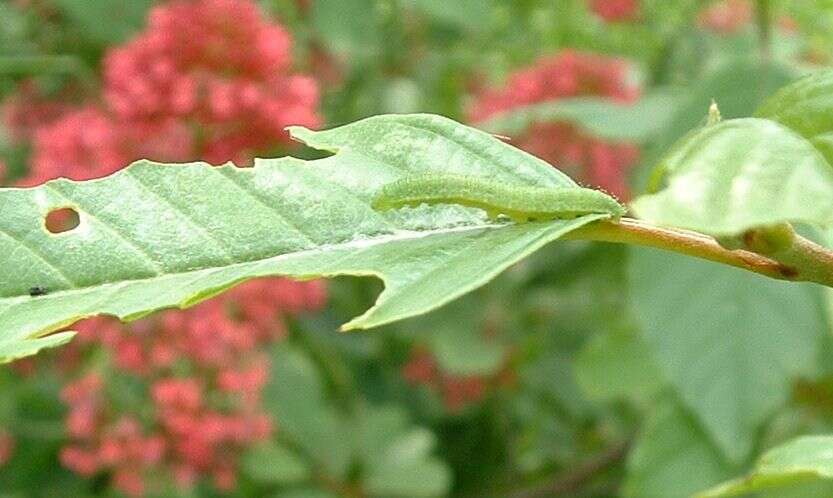 It is easy to pick out the Brimstone larvae on the alder buckthorn by the leaf damage.
It is easy to pick out the Brimstone larvae on the alder buckthorn by the leaf damage.
2003
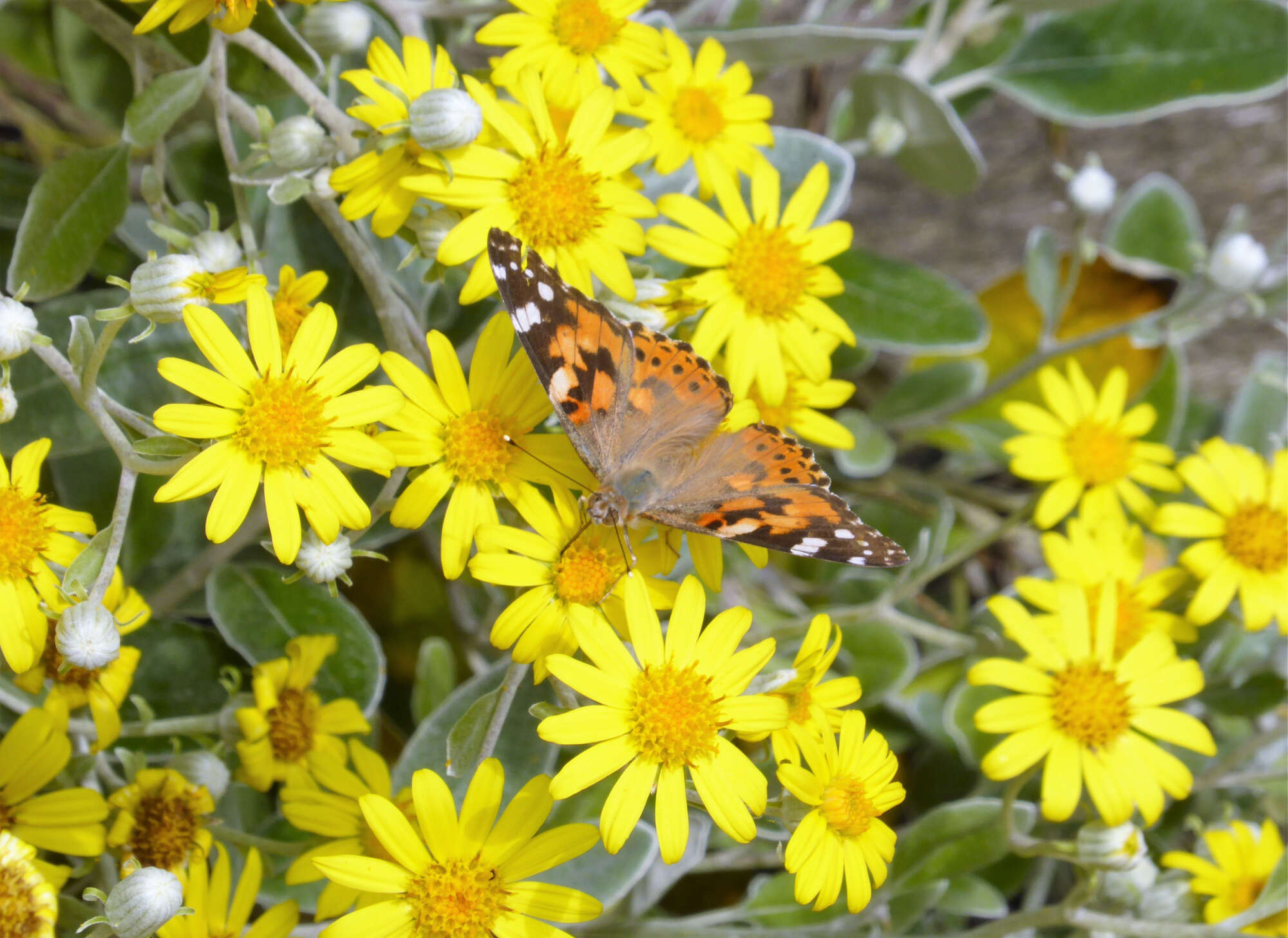 2003 was exceptional for the migrant Painted Lady, still its best year. A staggering 327 were counted on one day, the year total being 405.
2003 was exceptional for the migrant Painted Lady, still its best year. A staggering 327 were counted on one day, the year total being 405.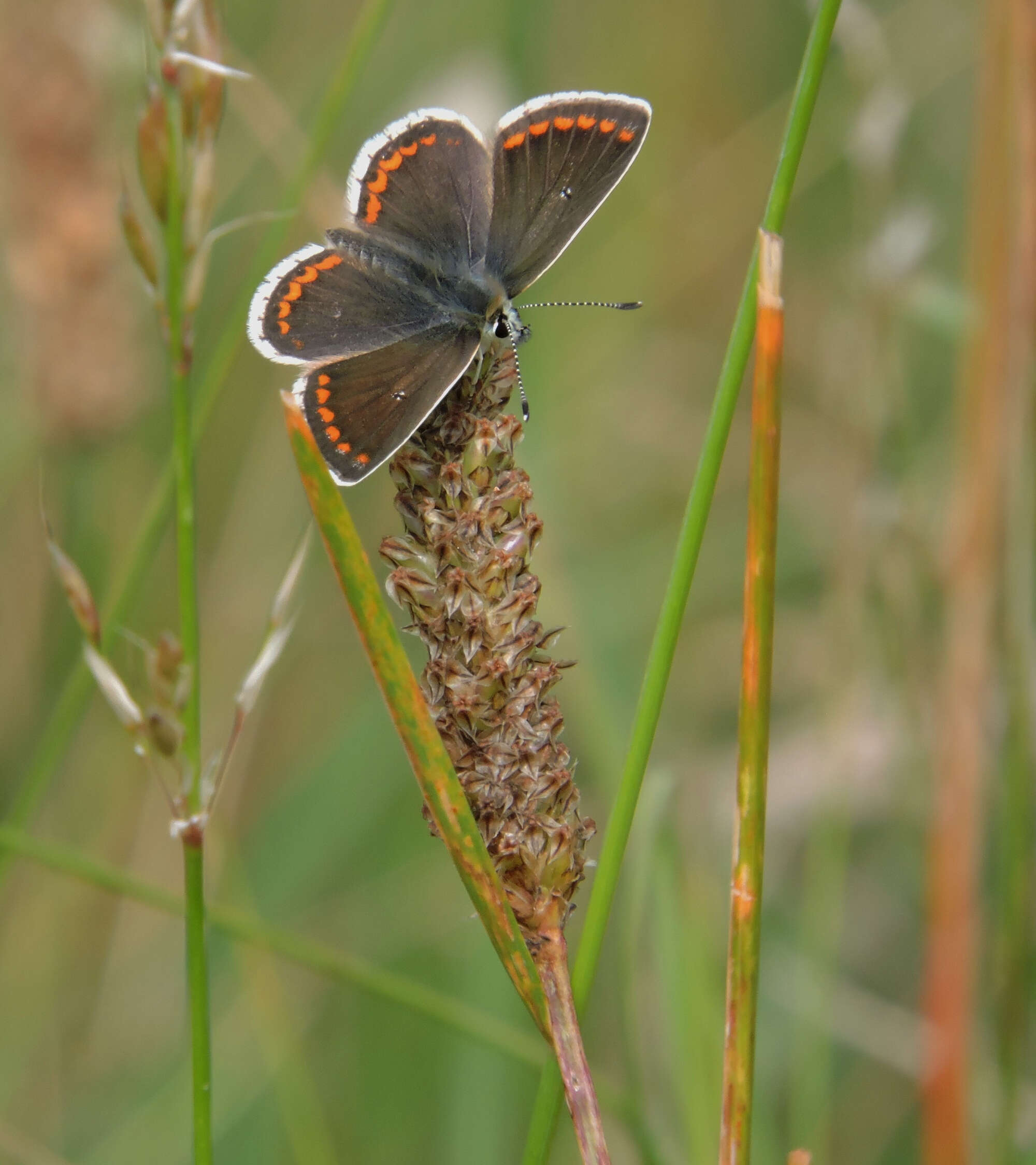 Yet it was a mere singleton of the Brown Argus that created the most excitement. Seen on the meadow, our first ever but the first of many as it quickly became our flagship species.
Yet it was a mere singleton of the Brown Argus that created the most excitement. Seen on the meadow, our first ever but the first of many as it quickly became our flagship species.
2004
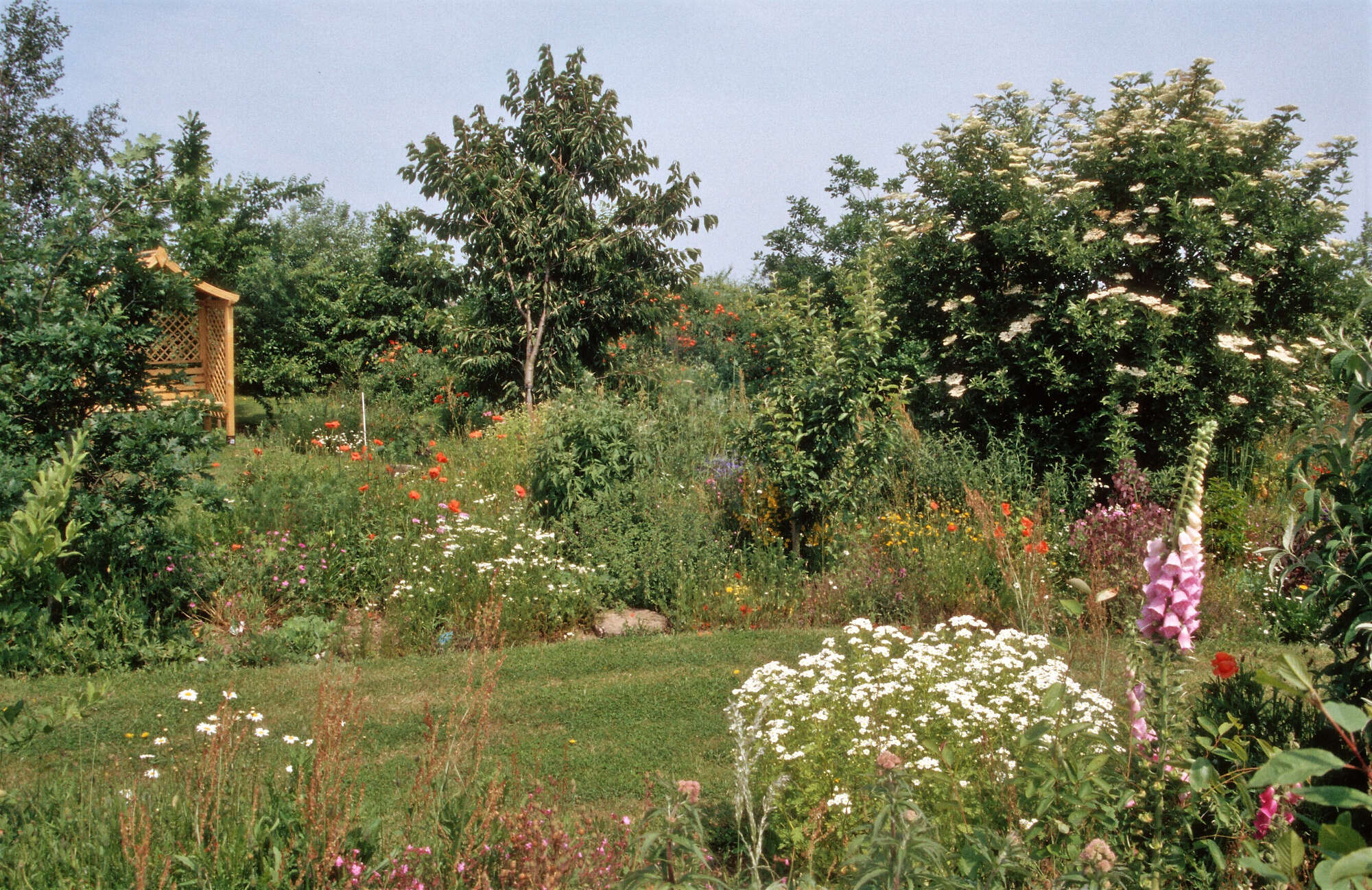 Flowery glades now becoming well established in the woodland garden.
Flowery glades now becoming well established in the woodland garden.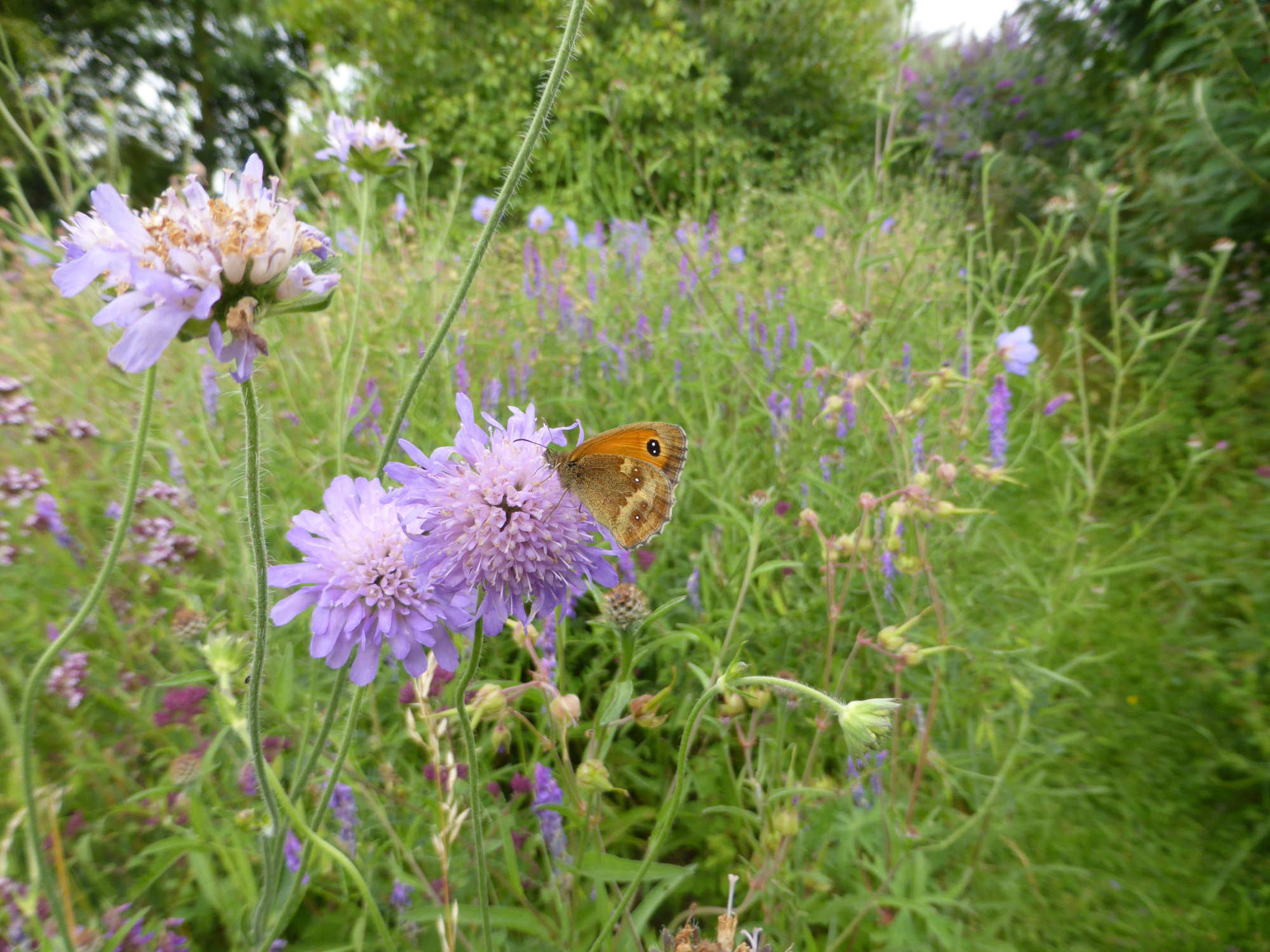 The Gatekeeper does very well here, this shot showing the garden habitat off well.
The Gatekeeper does very well here, this shot showing the garden habitat off well.
2005
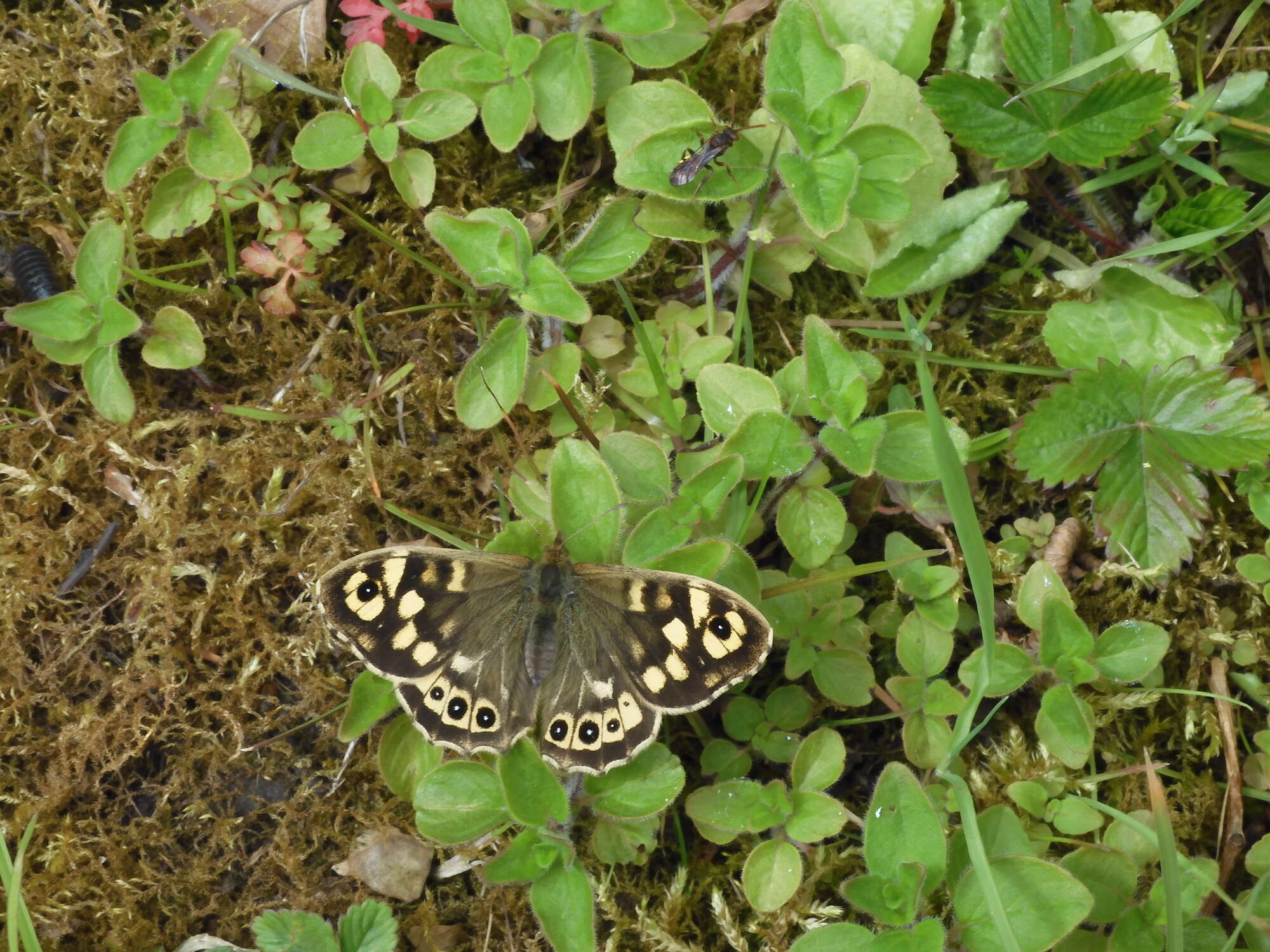 Proving that we were developing a real woodland habitat, 2005 produced our next resident species - the Speckled Wood, and an ovipositing female at that!
Proving that we were developing a real woodland habitat, 2005 produced our next resident species - the Speckled Wood, and an ovipositing female at that!
2006
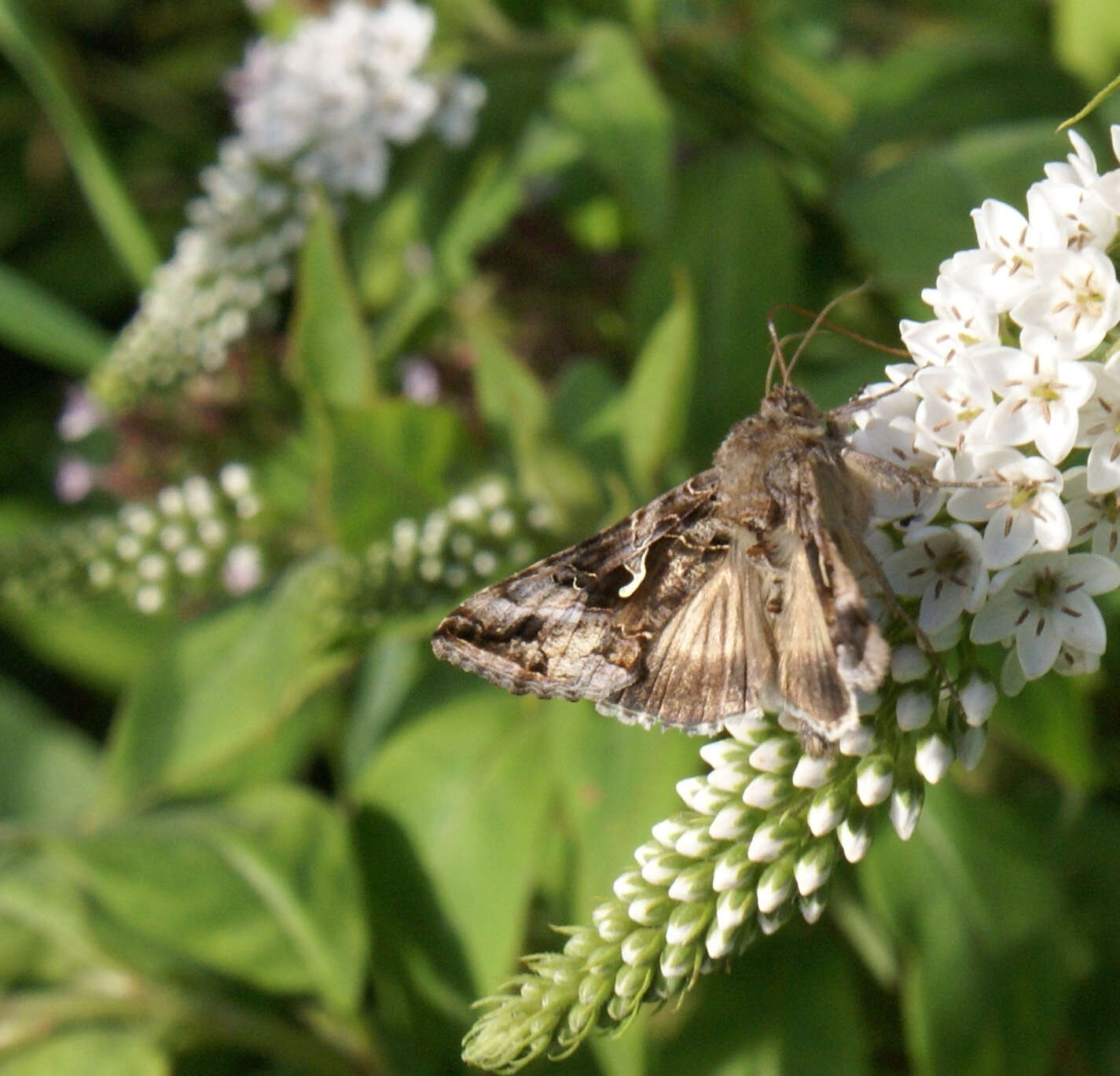 The highest count of any species to date occurred in 2006 with phenomenal numbers of the migrant Silver Y moth. 800 were counted in one session, with an overall total of 841.
The highest count of any species to date occurred in 2006 with phenomenal numbers of the migrant Silver Y moth. 800 were counted in one session, with an overall total of 841.
2007
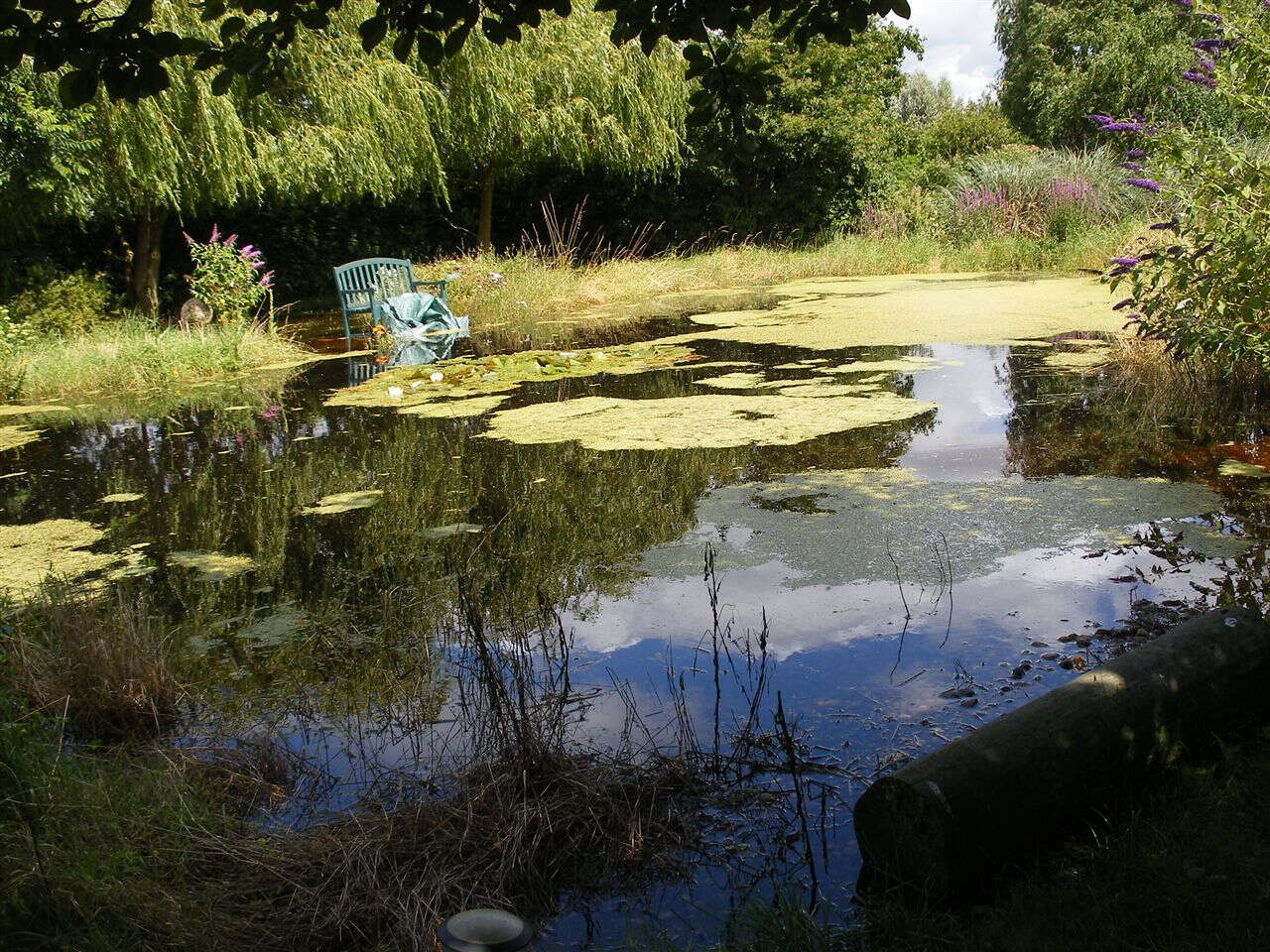 Summer floods brought the wettest and worst summer in LIVING MEMORY! Butterfly numbers plummeted, with no Brown Argus seen, after they had been doing so well.
Summer floods brought the wettest and worst summer in LIVING MEMORY! Butterfly numbers plummeted, with no Brown Argus seen, after they had been doing so well.
2008
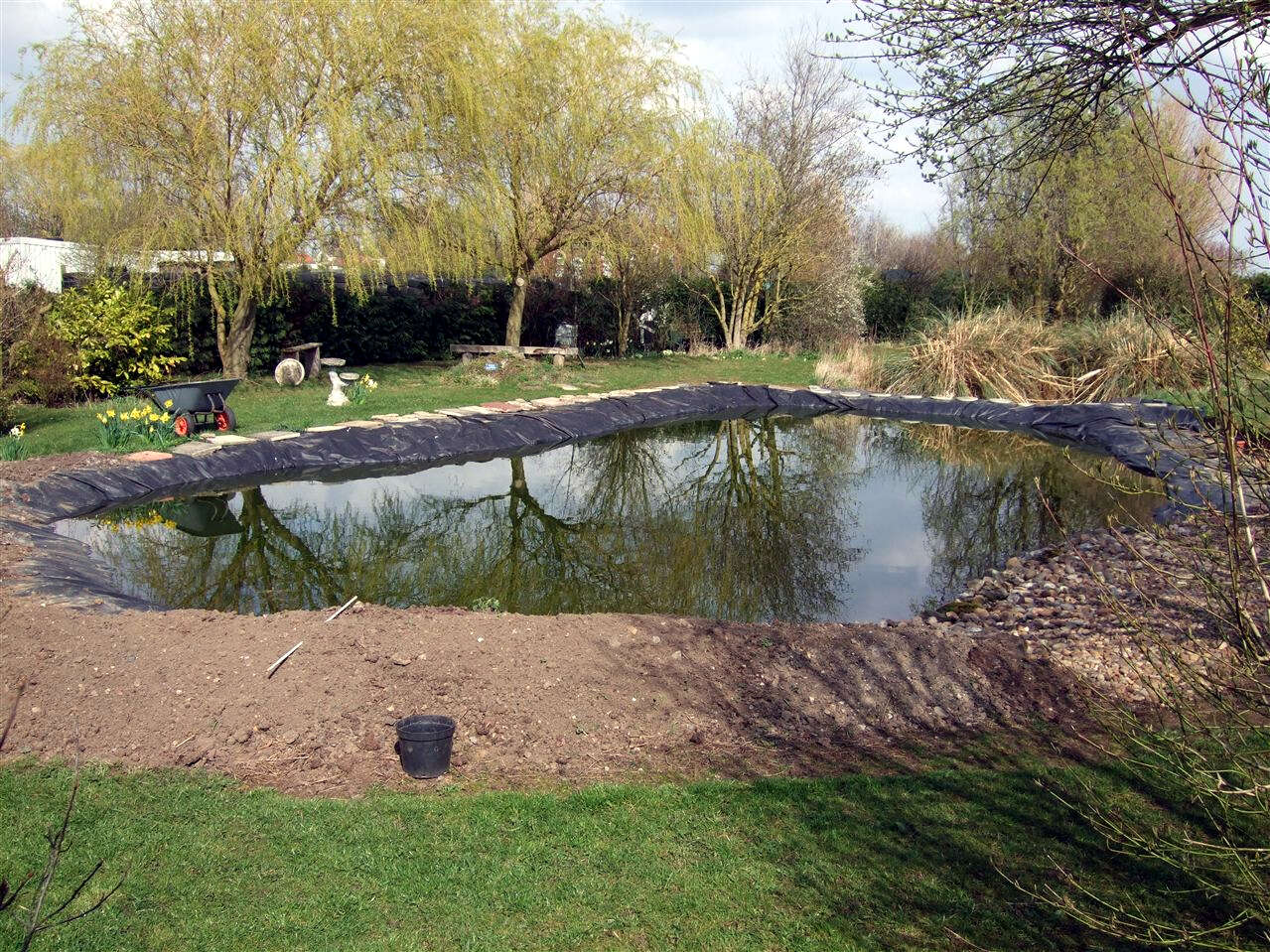 Needless to say, the pond restoration was put on hold last year but went ahead this year.
Needless to say, the pond restoration was put on hold last year but went ahead this year.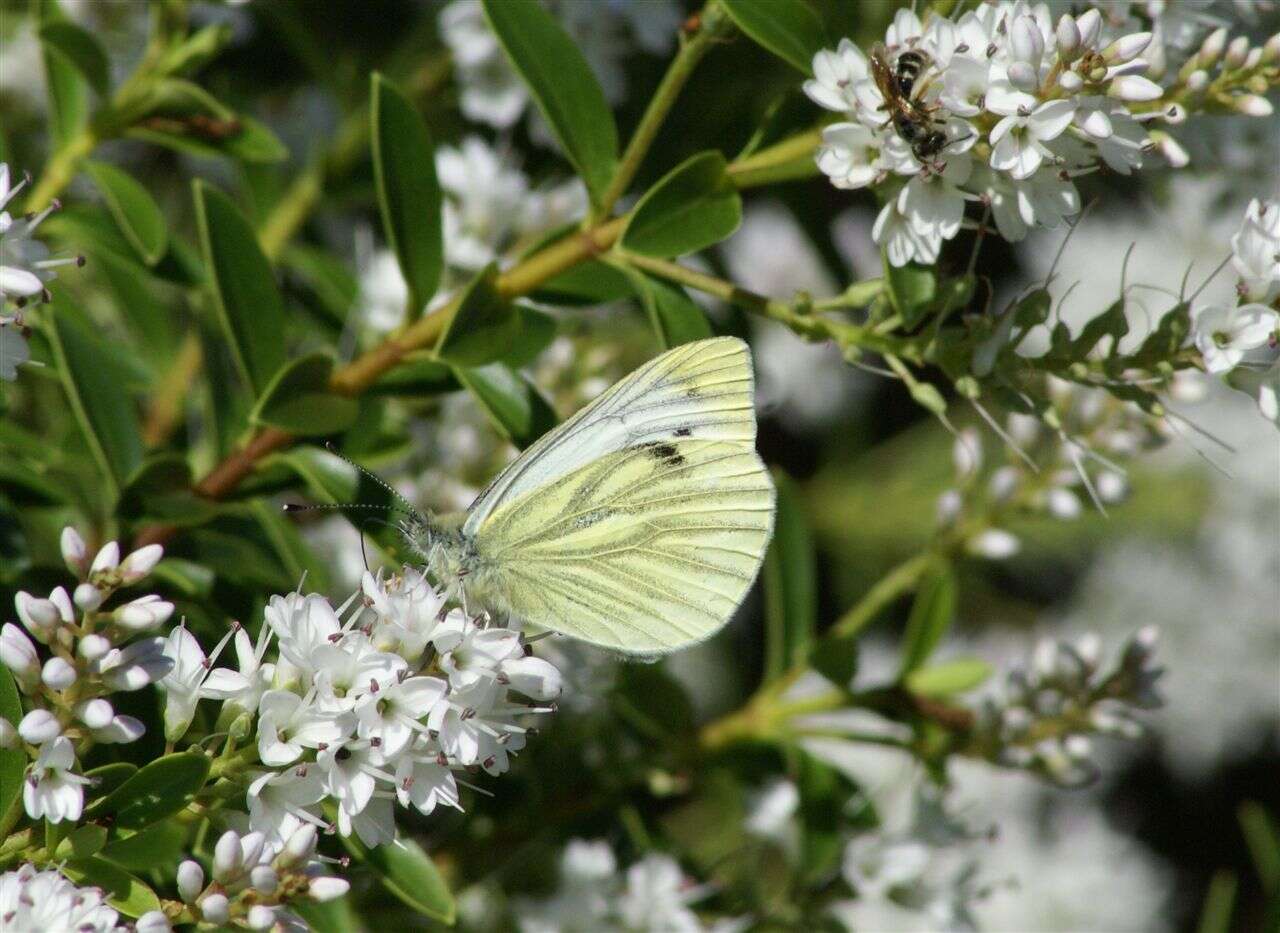 Following the worst butterfly season EVER, it was a complete surprise to see so many species making an amazing comeback - Green-veined White had its BEST season ever.
Following the worst butterfly season EVER, it was a complete surprise to see so many species making an amazing comeback - Green-veined White had its BEST season ever.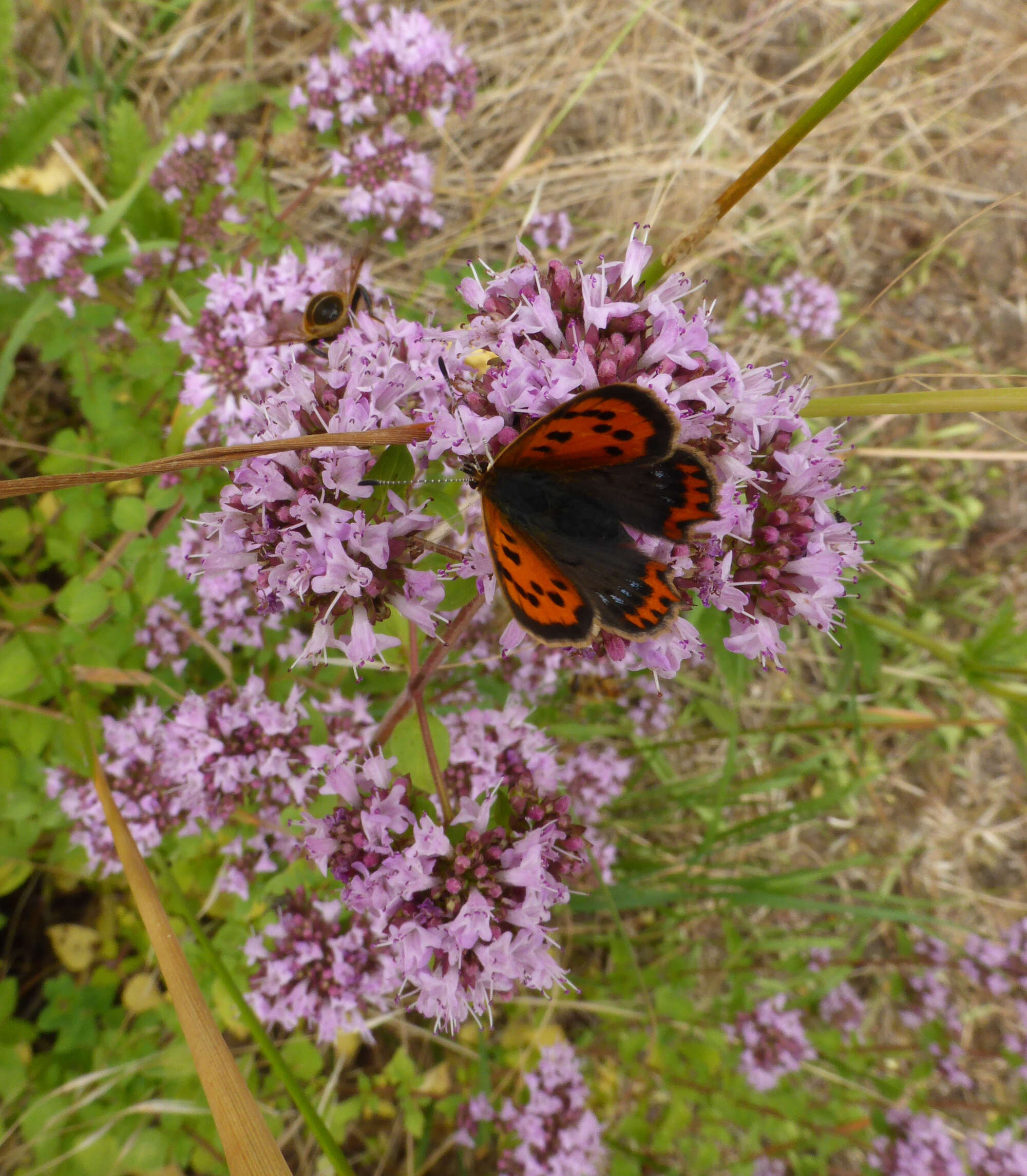 Small Copper excelled, to a lesser extent the Common Blue, and the Wall Brown was very encouraging.
Small Copper excelled, to a lesser extent the Common Blue, and the Wall Brown was very encouraging.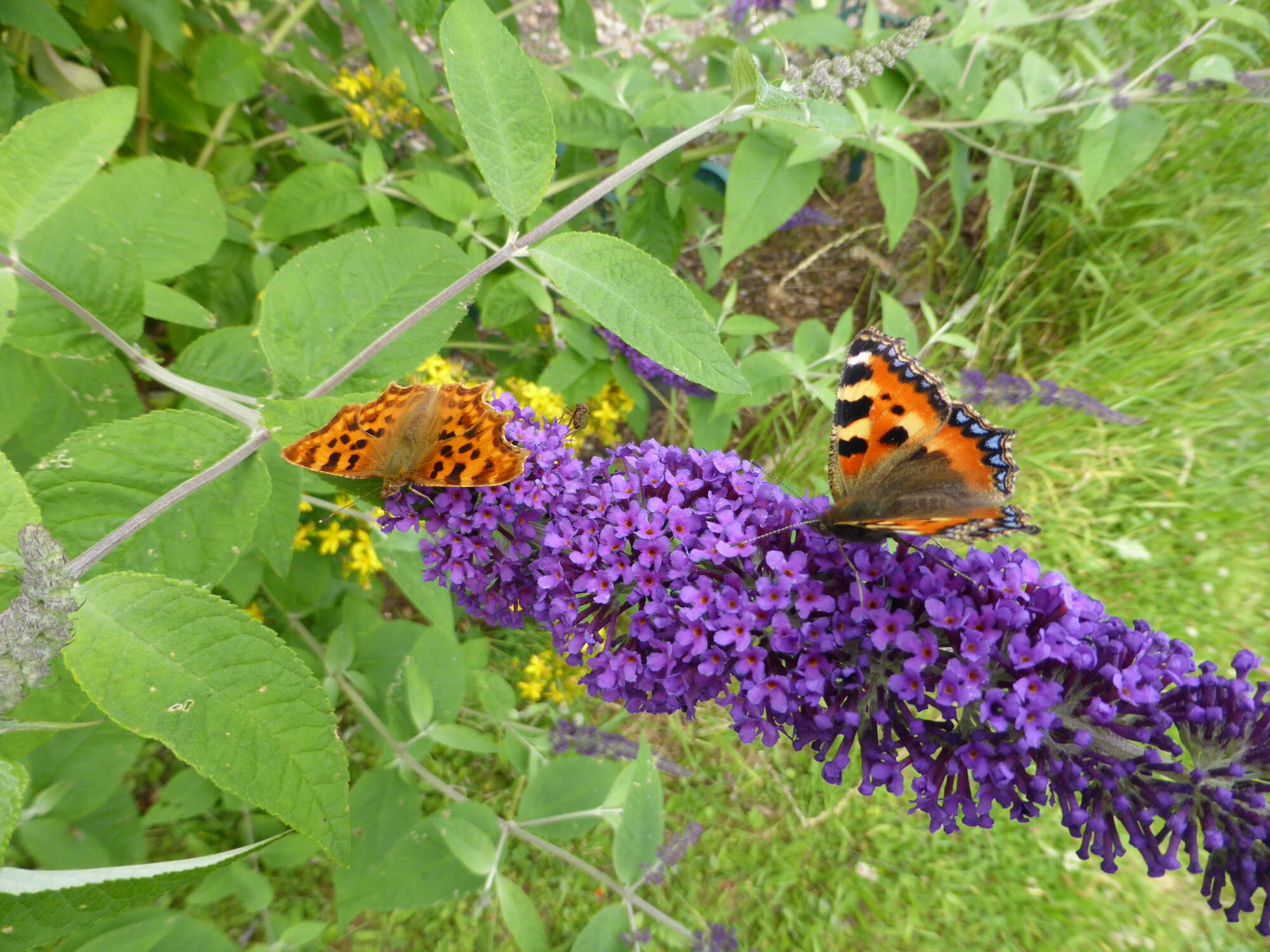 The Nymphalids had a particularly good year.
The Nymphalids had a particularly good year.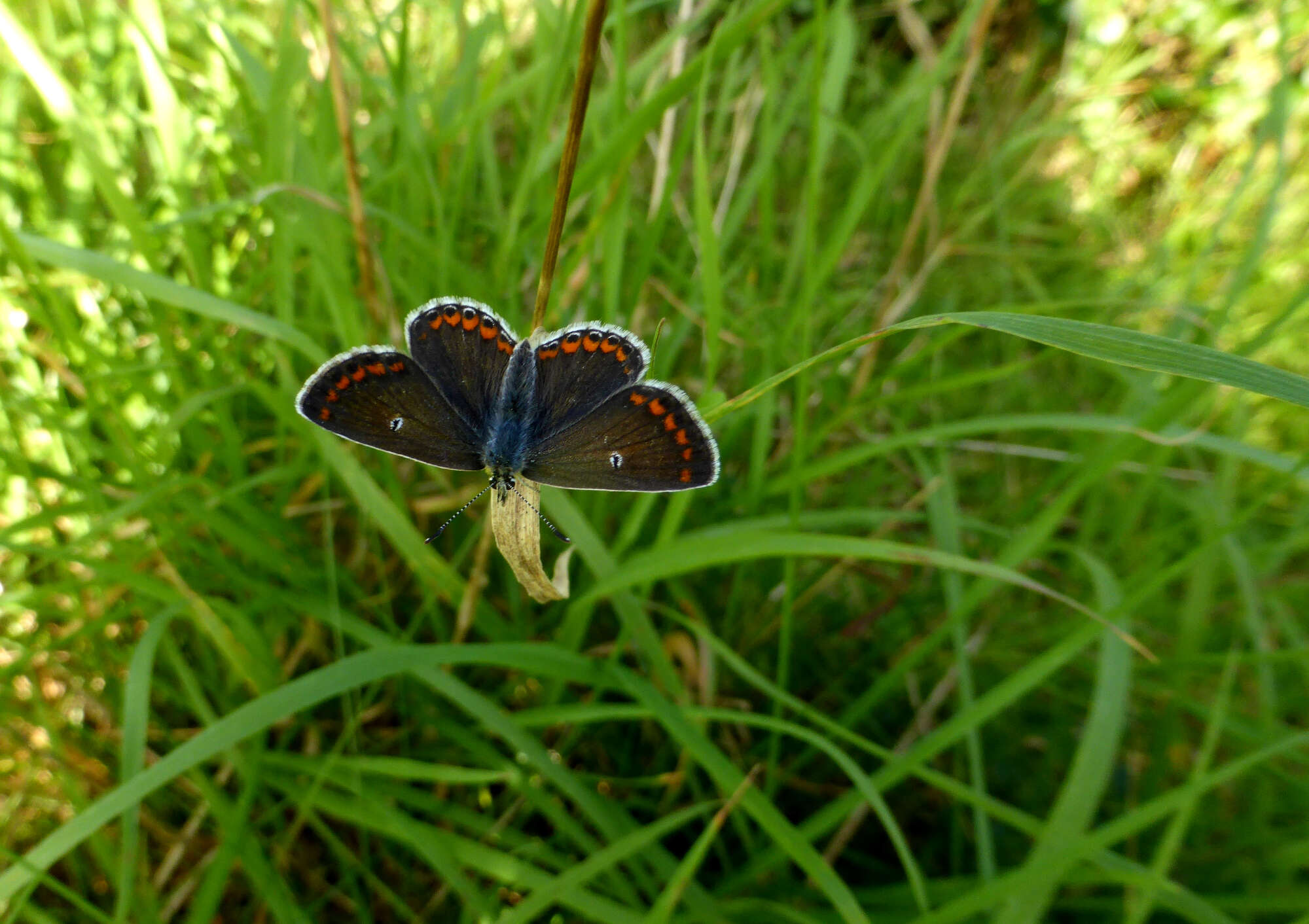 I honestly thought it would be a complete restart for the Brown Argus, yet it was in better numbers than ever! Mother Nature's recovery process at its best!
I honestly thought it would be a complete restart for the Brown Argus, yet it was in better numbers than ever! Mother Nature's recovery process at its best!
2009
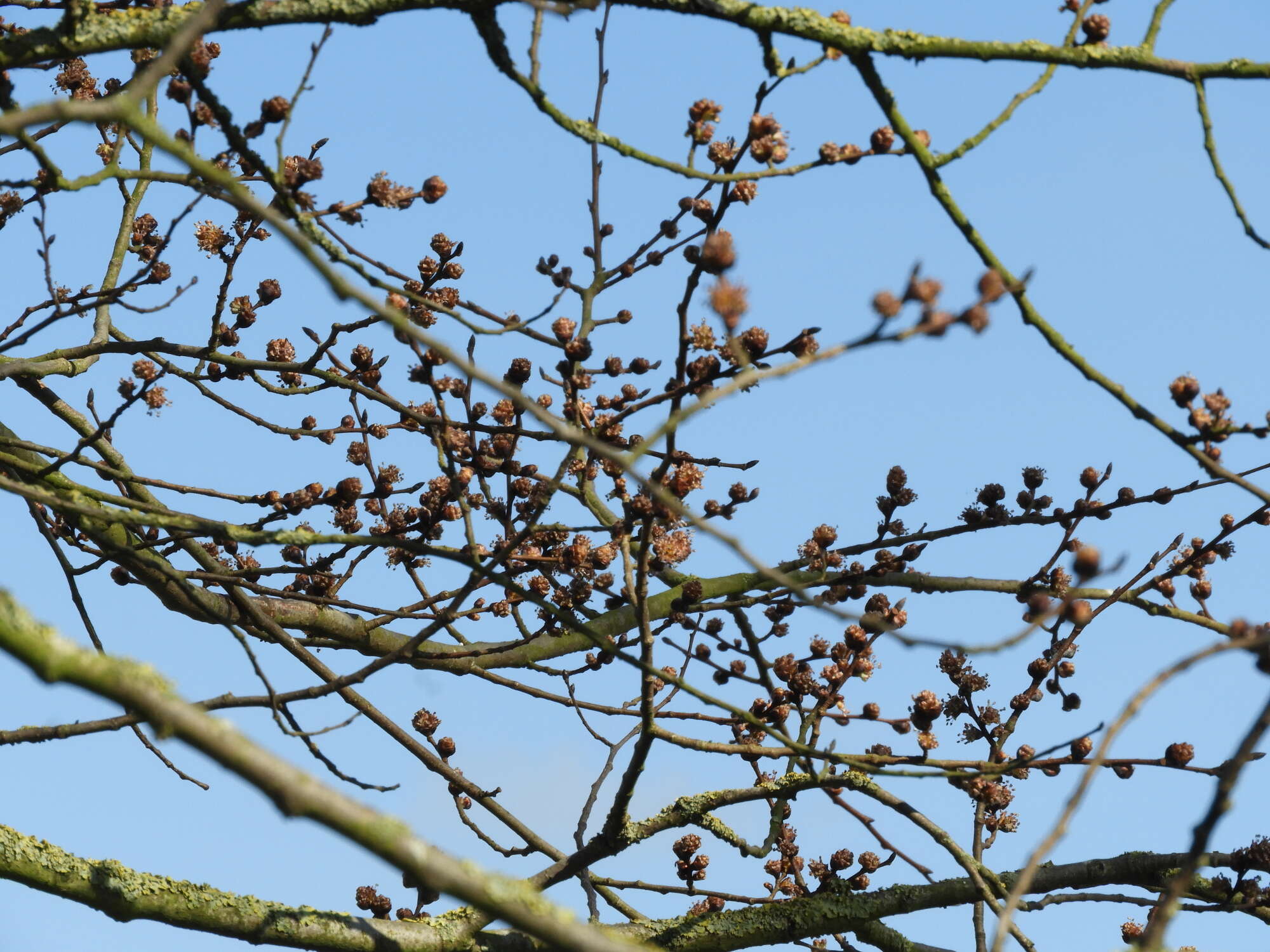 It was encouraging to see flowers on the woodland garden elms, a sign of maturity and a requirement of any potential White-letter Hairstreak larvae.
It was encouraging to see flowers on the woodland garden elms, a sign of maturity and a requirement of any potential White-letter Hairstreak larvae.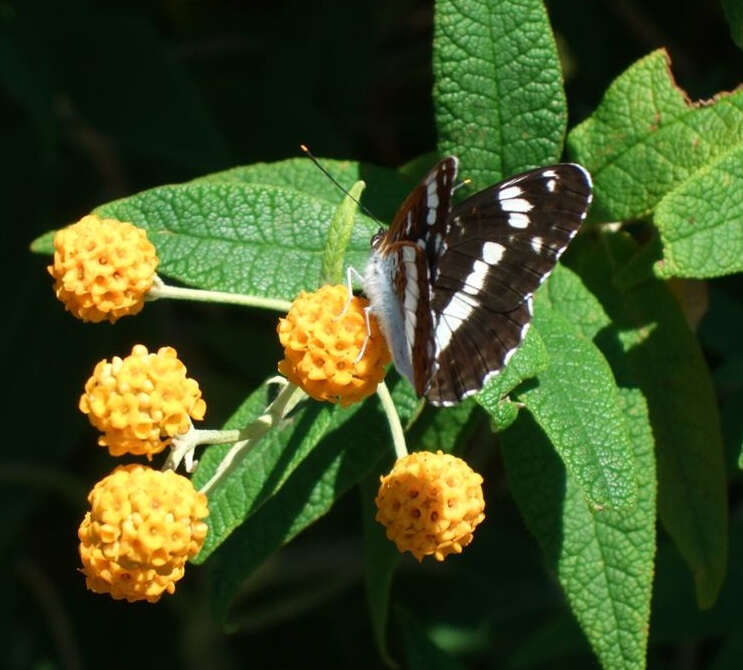 Still no signs of the White-letter Hairstreak but we did have a visit from a White Admiral feeding on buddleia globosa. No known colonies within 12 miles or so.
Still no signs of the White-letter Hairstreak but we did have a visit from a White Admiral feeding on buddleia globosa. No known colonies within 12 miles or so.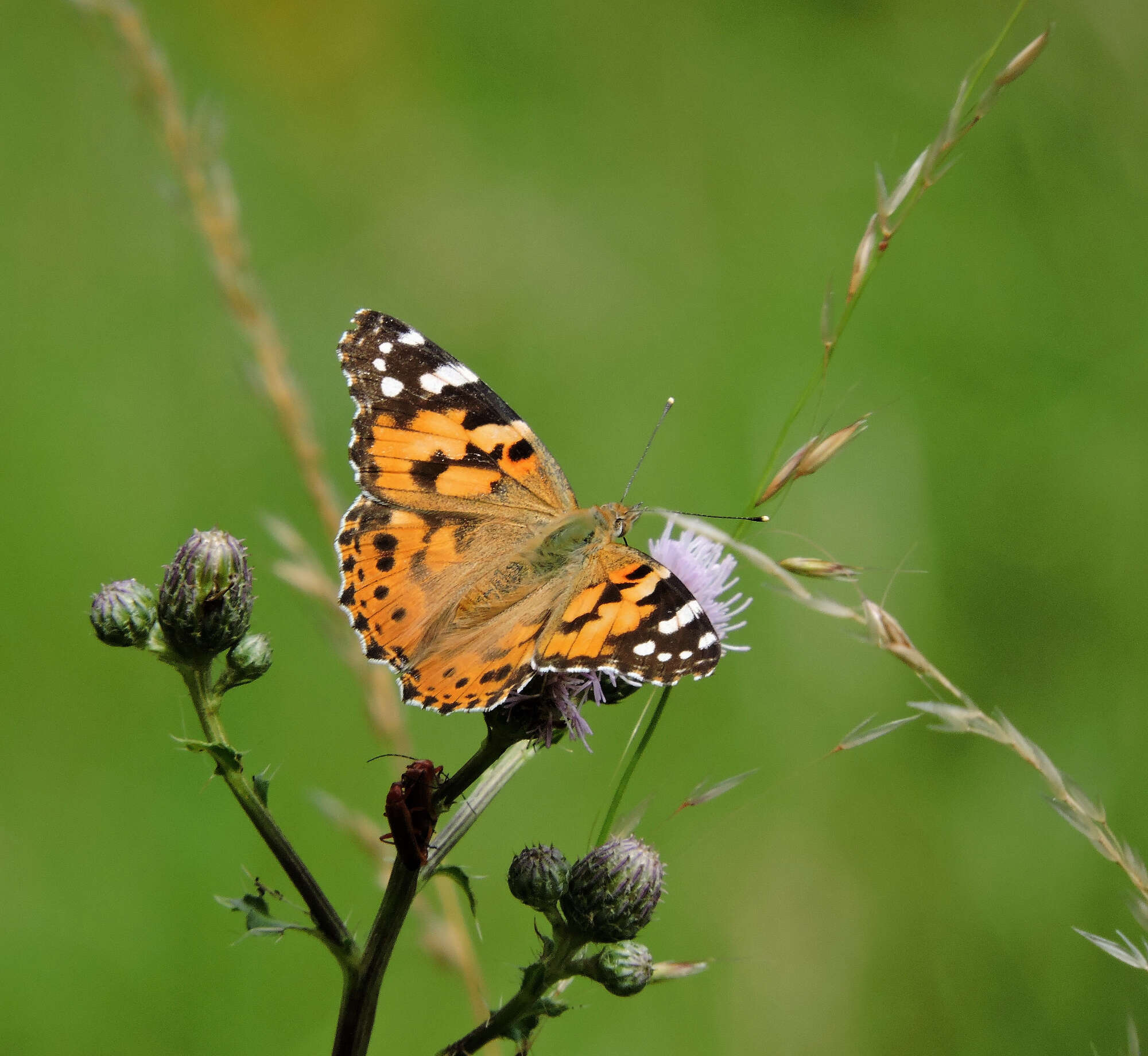 Painted Ladies perform their largest migration ever to the UK. Millions were recorded arriving. I stood and watched them coming from the south-east. 2003 is still their best here.
Painted Ladies perform their largest migration ever to the UK. Millions were recorded arriving. I stood and watched them coming from the south-east. 2003 is still their best here.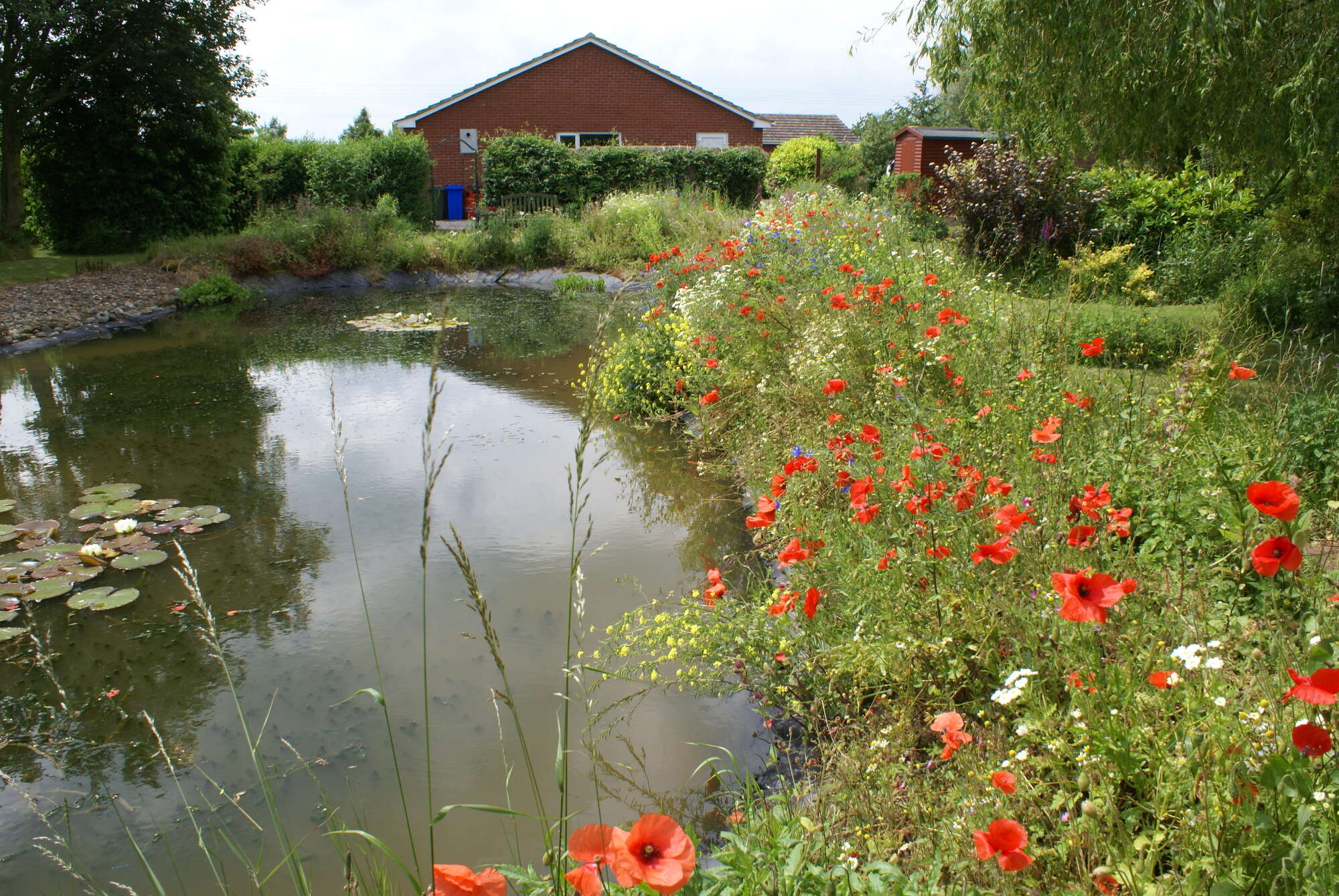 Poppies help fill the gaps around the renovated pond.
Poppies help fill the gaps around the renovated pond.
2010
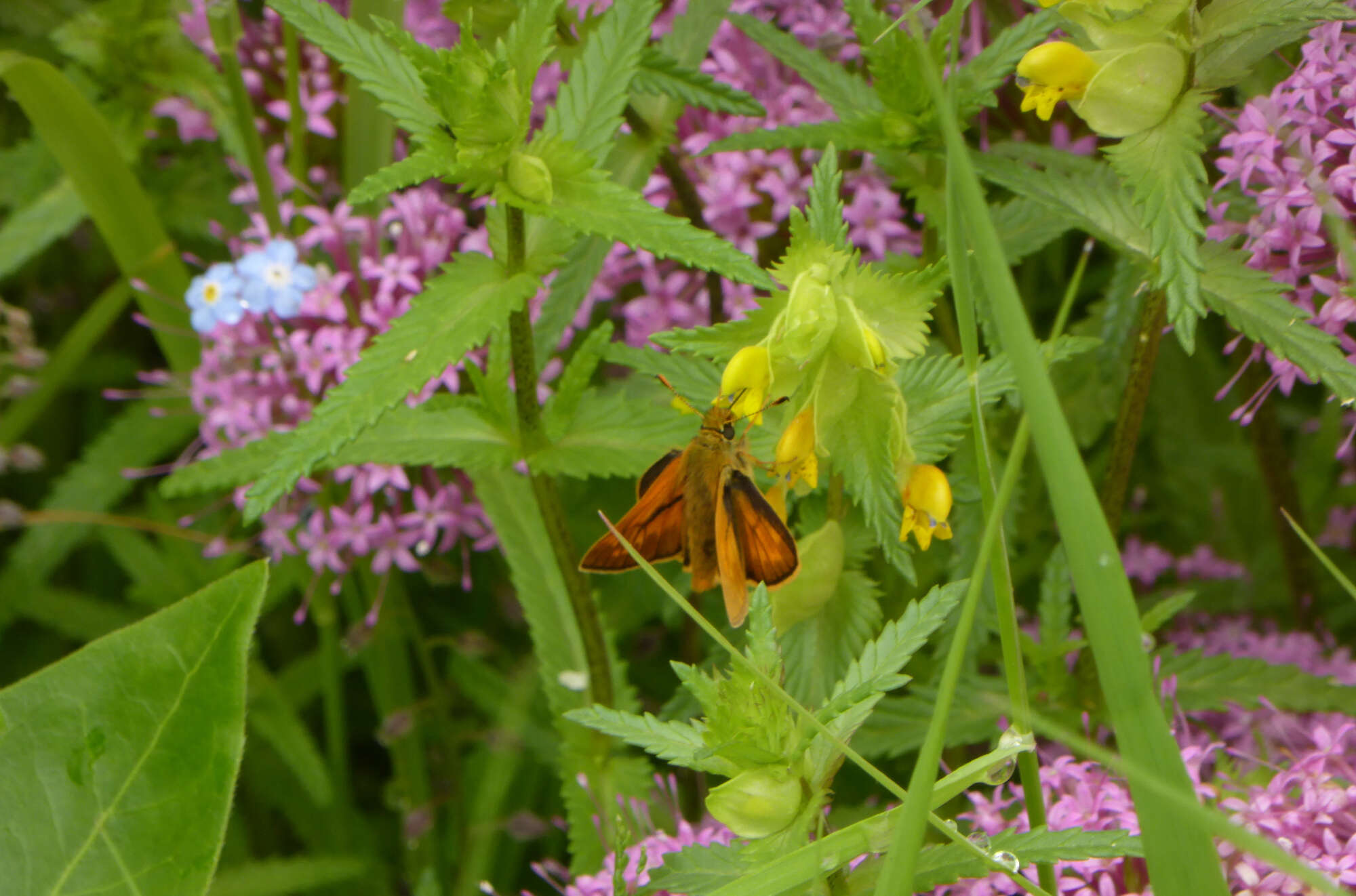 Yellow rattle is at last establised, a much needed plant that keeps the grasses at bay. A good nectar plant too, as seen with this Large Skipper. They had a very good year.
Yellow rattle is at last establised, a much needed plant that keeps the grasses at bay. A good nectar plant too, as seen with this Large Skipper. They had a very good year.
2011
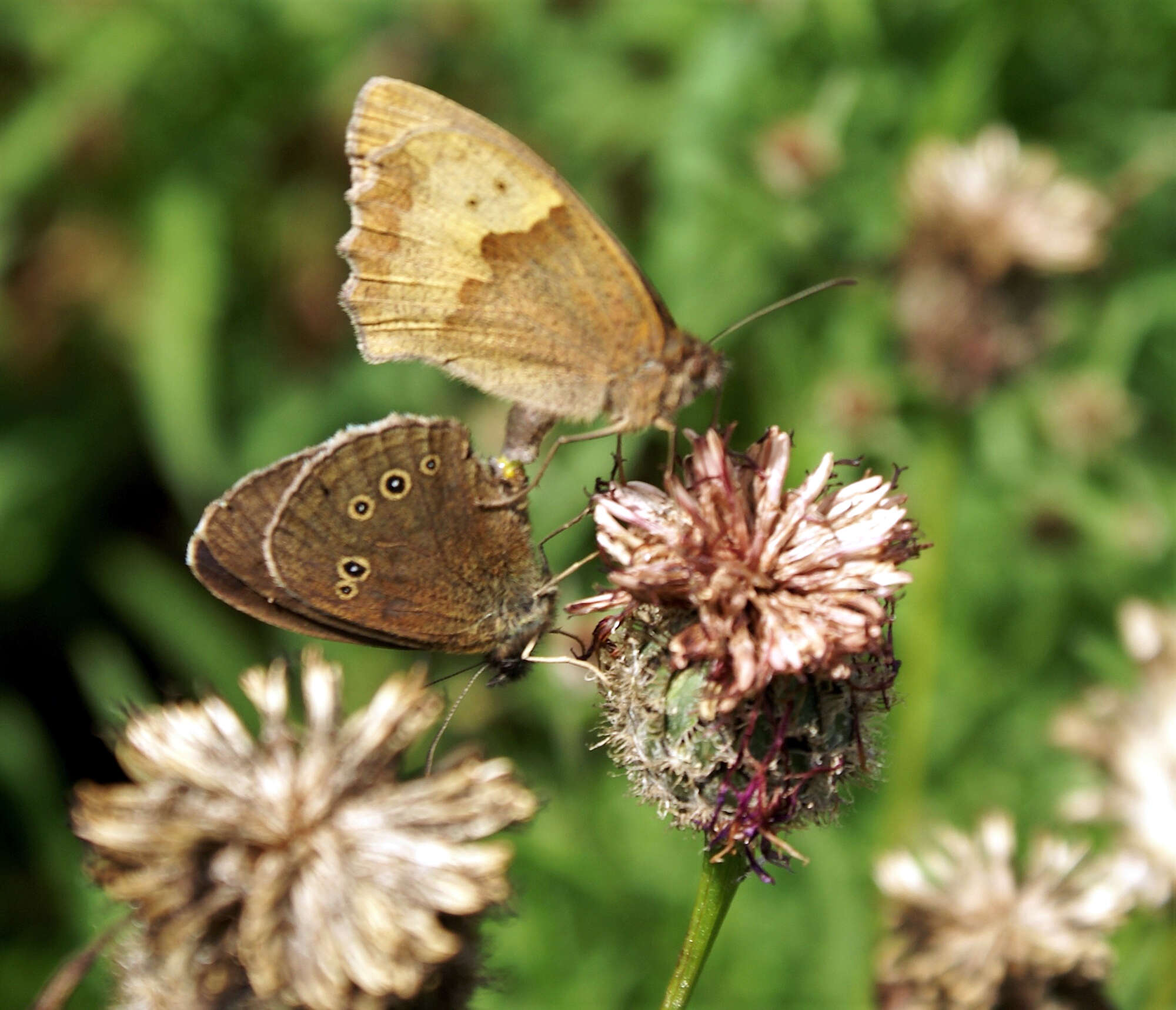 With so few butterflies around this summer I joked about this Ringlet having to make do by mating with a Meadow Brown! A very odd occurence.
With so few butterflies around this summer I joked about this Ringlet having to make do by mating with a Meadow Brown! A very odd occurence.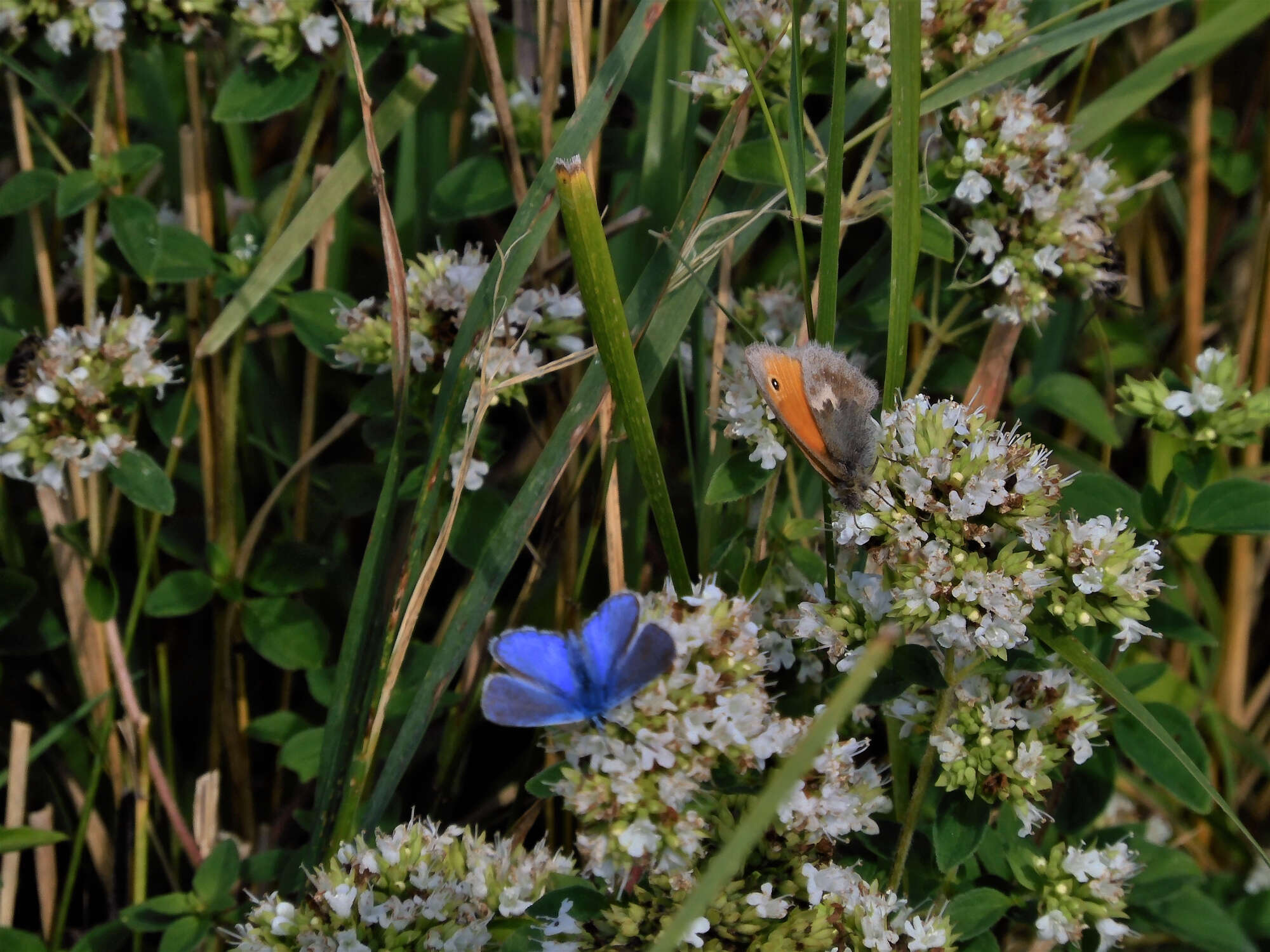 Yet despite the very poor season, we saw our first Small Heath for 10 years.
Yet despite the very poor season, we saw our first Small Heath for 10 years.
2012
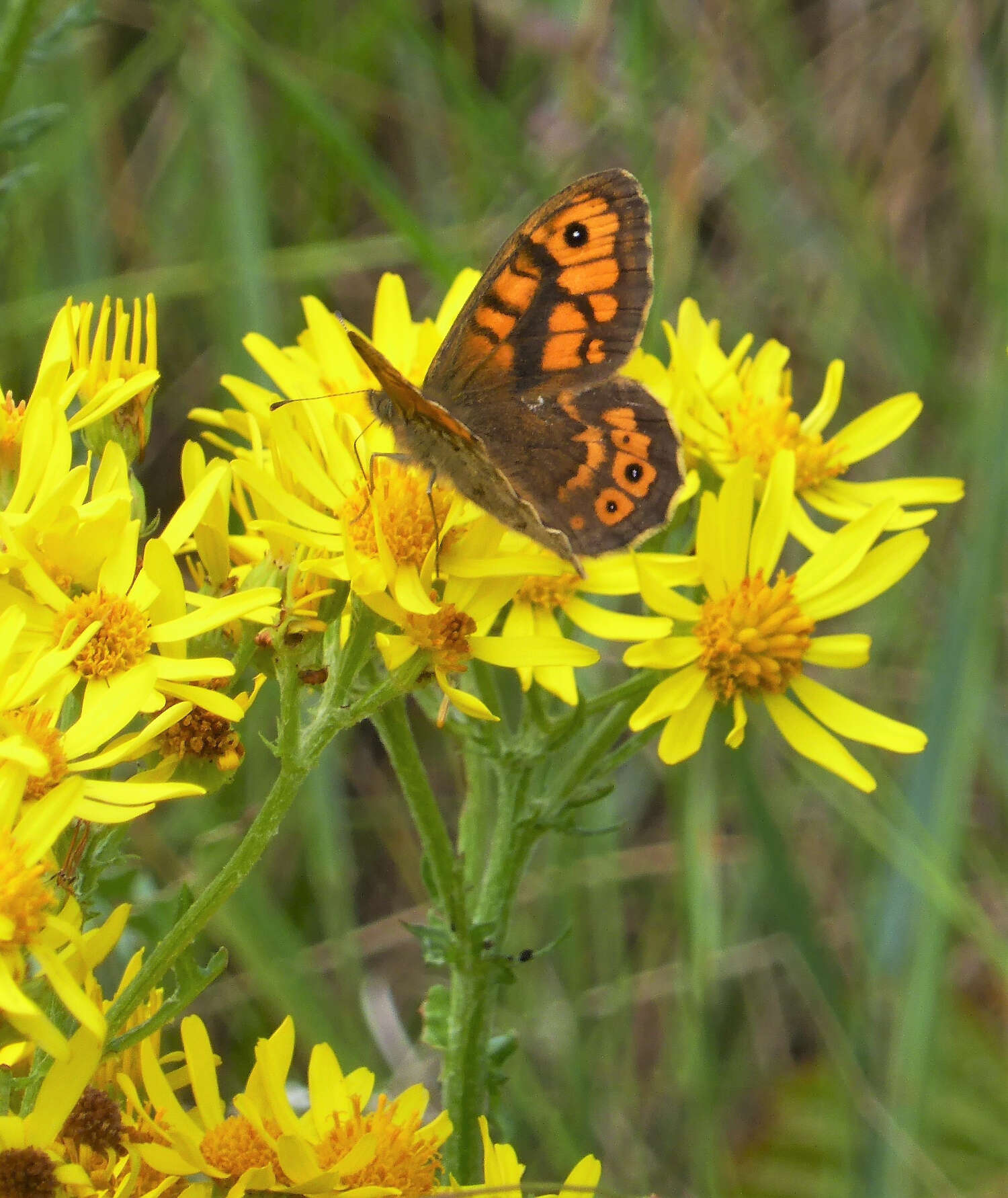 The second wettest summer on record is officially declared the worst butterfly year ever. For us, it marks the departure of the Wall Brown. So sad it has become so rare.
The second wettest summer on record is officially declared the worst butterfly year ever. For us, it marks the departure of the Wall Brown. So sad it has become so rare.
2013
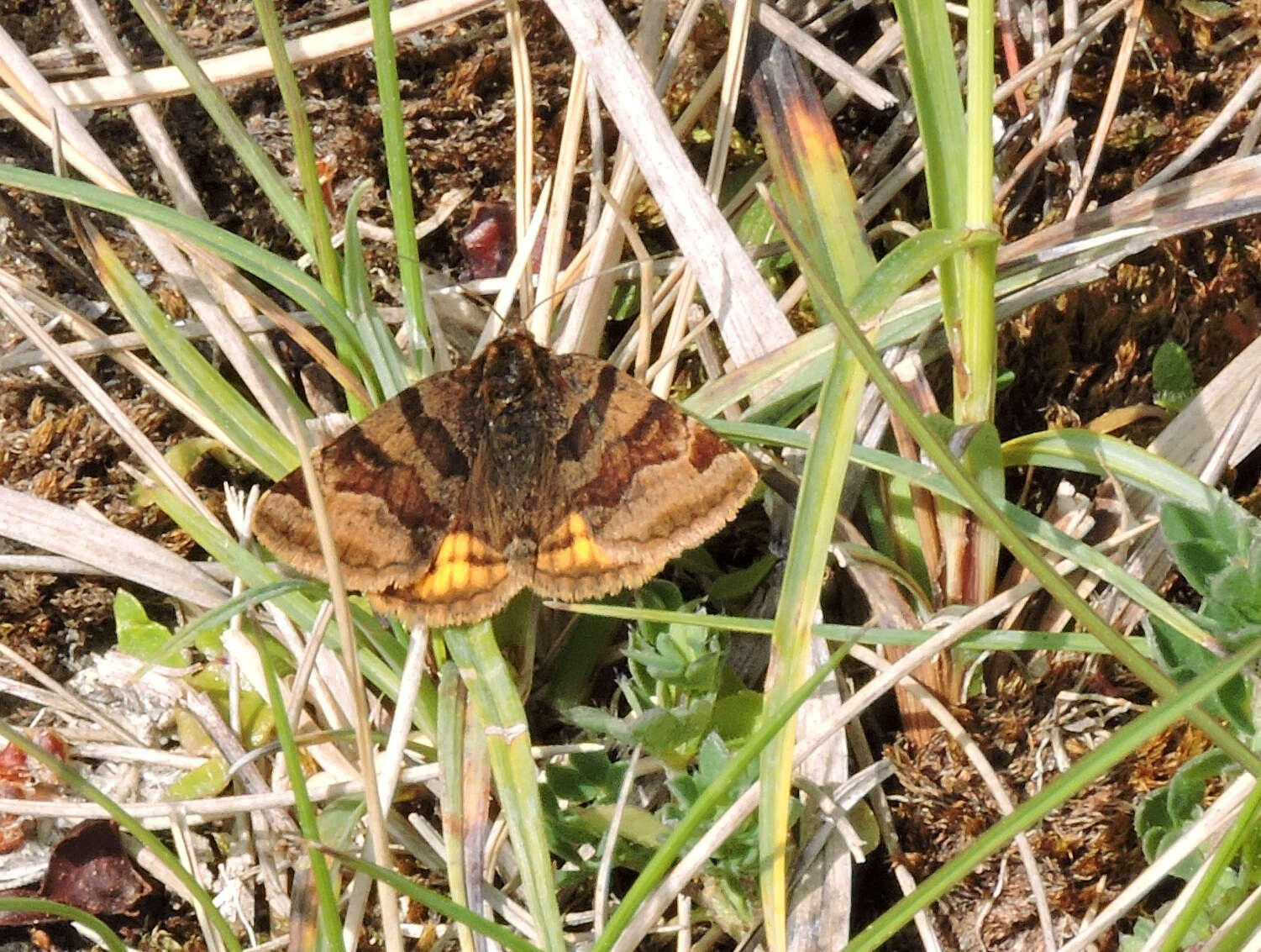 2013 was a mixed bag overall but 2 new day-flying moths were seen. First the Burnet Companion....
2013 was a mixed bag overall but 2 new day-flying moths were seen. First the Burnet Companion....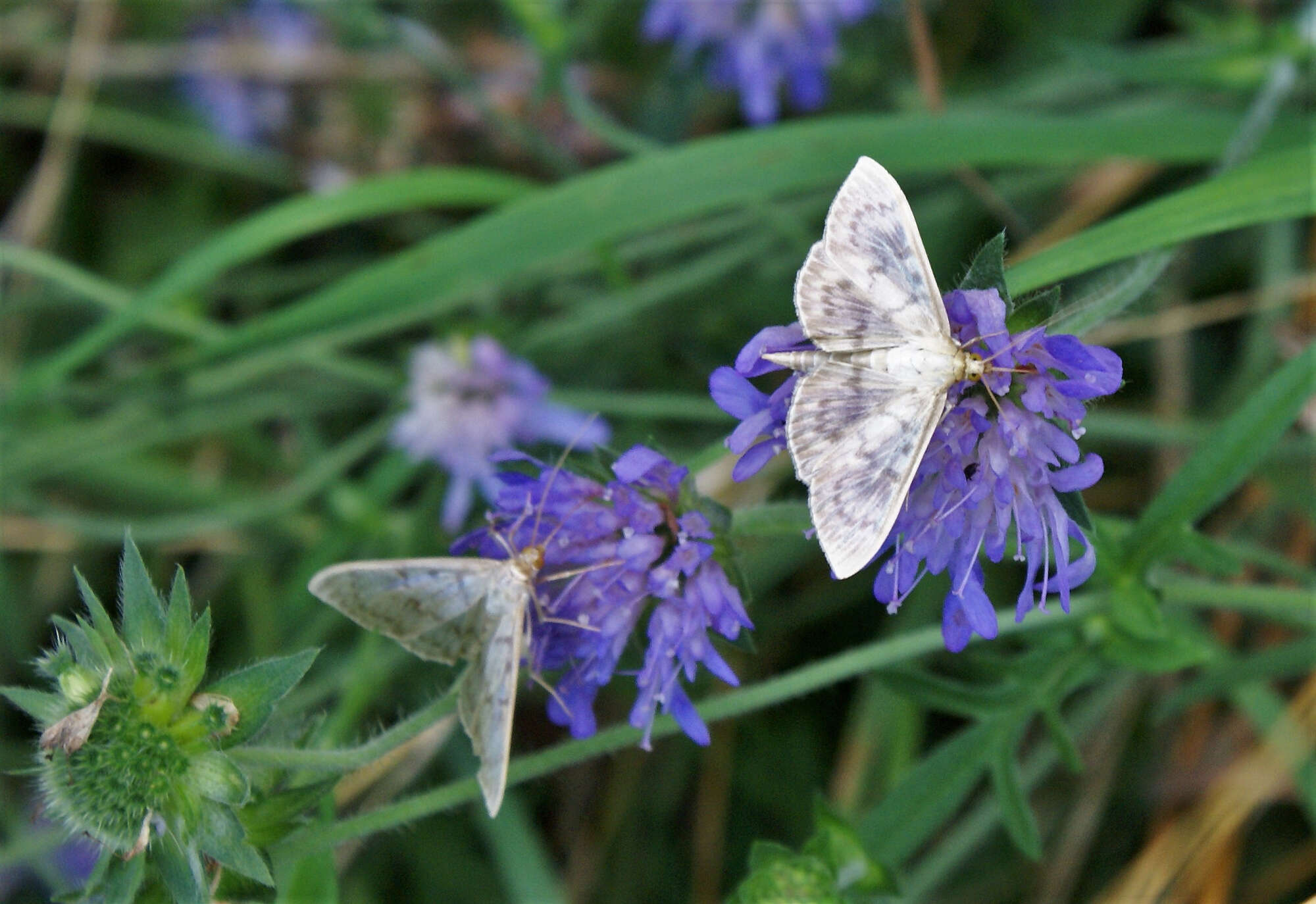 followed by the beautiful Mother of Pearl, seen here on scabious.
followed by the beautiful Mother of Pearl, seen here on scabious.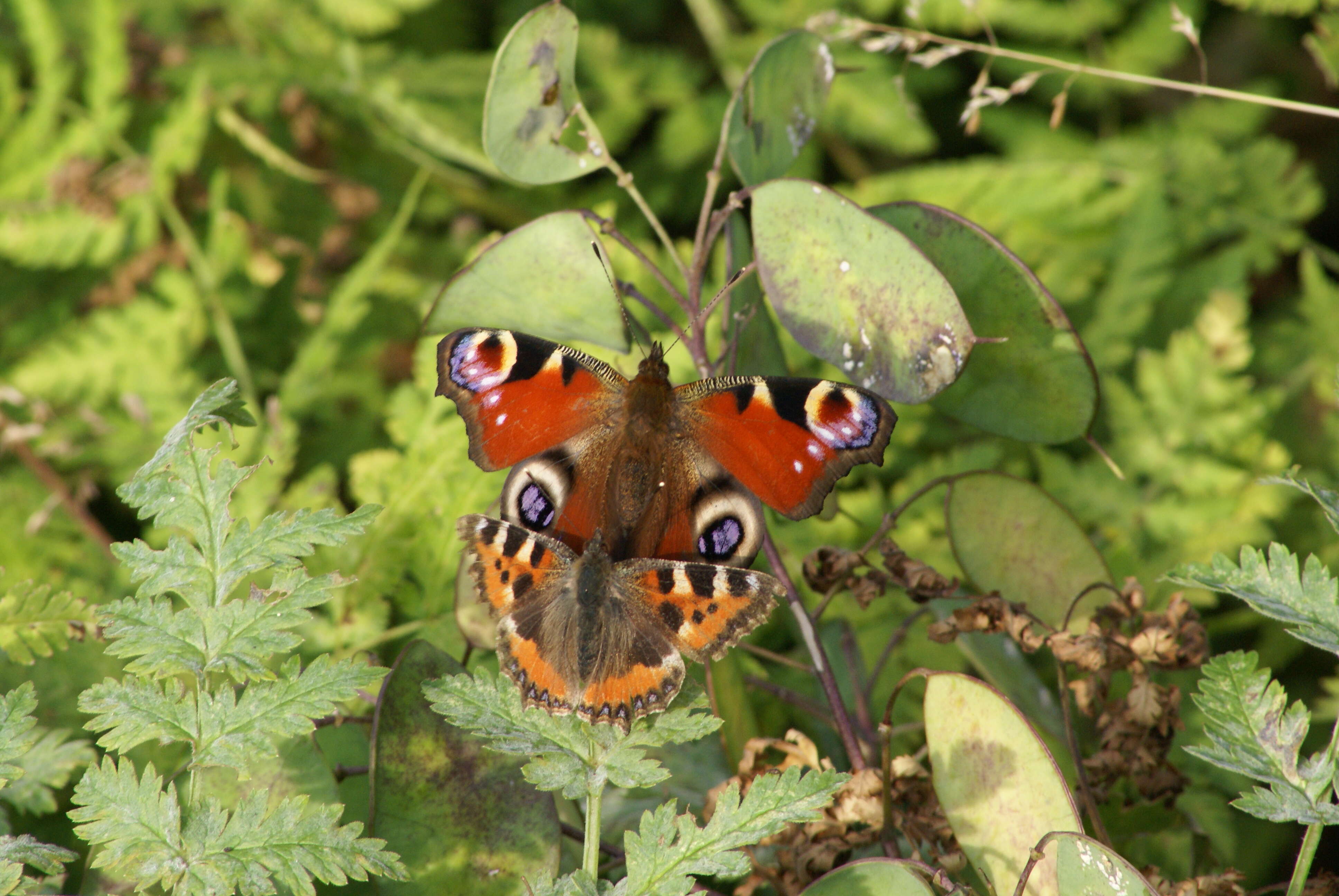 2013 was the best year ever for the Peacock, despite the efforts of this Small Tortoiseshell to disrupt proceedings!
2013 was the best year ever for the Peacock, despite the efforts of this Small Tortoiseshell to disrupt proceedings!
2014
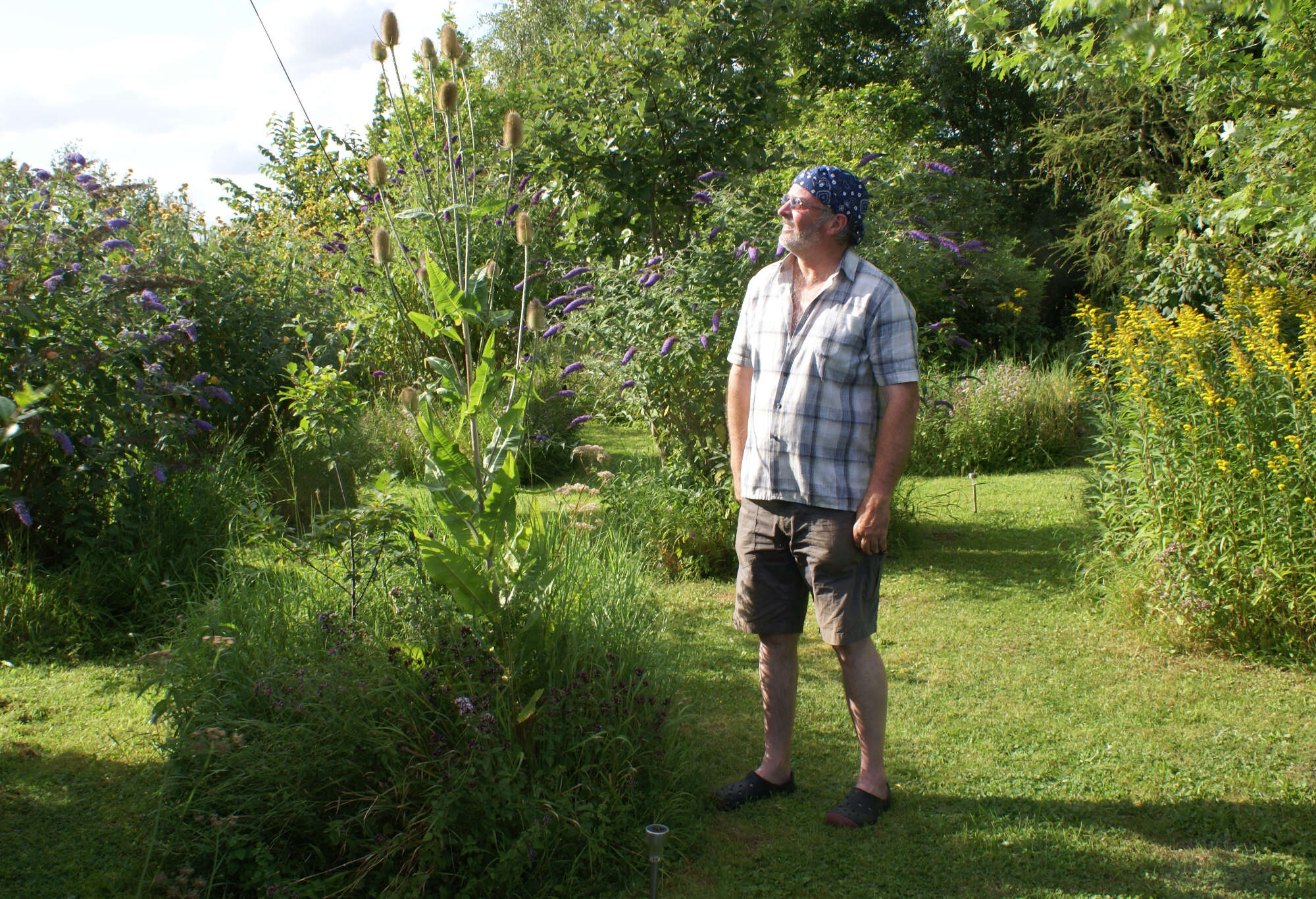 It is often quoted that distribution maps show the wherabouts of the recorders more so than the actual species, as we proved in 2014...
It is often quoted that distribution maps show the wherabouts of the recorders more so than the actual species, as we proved in 2014...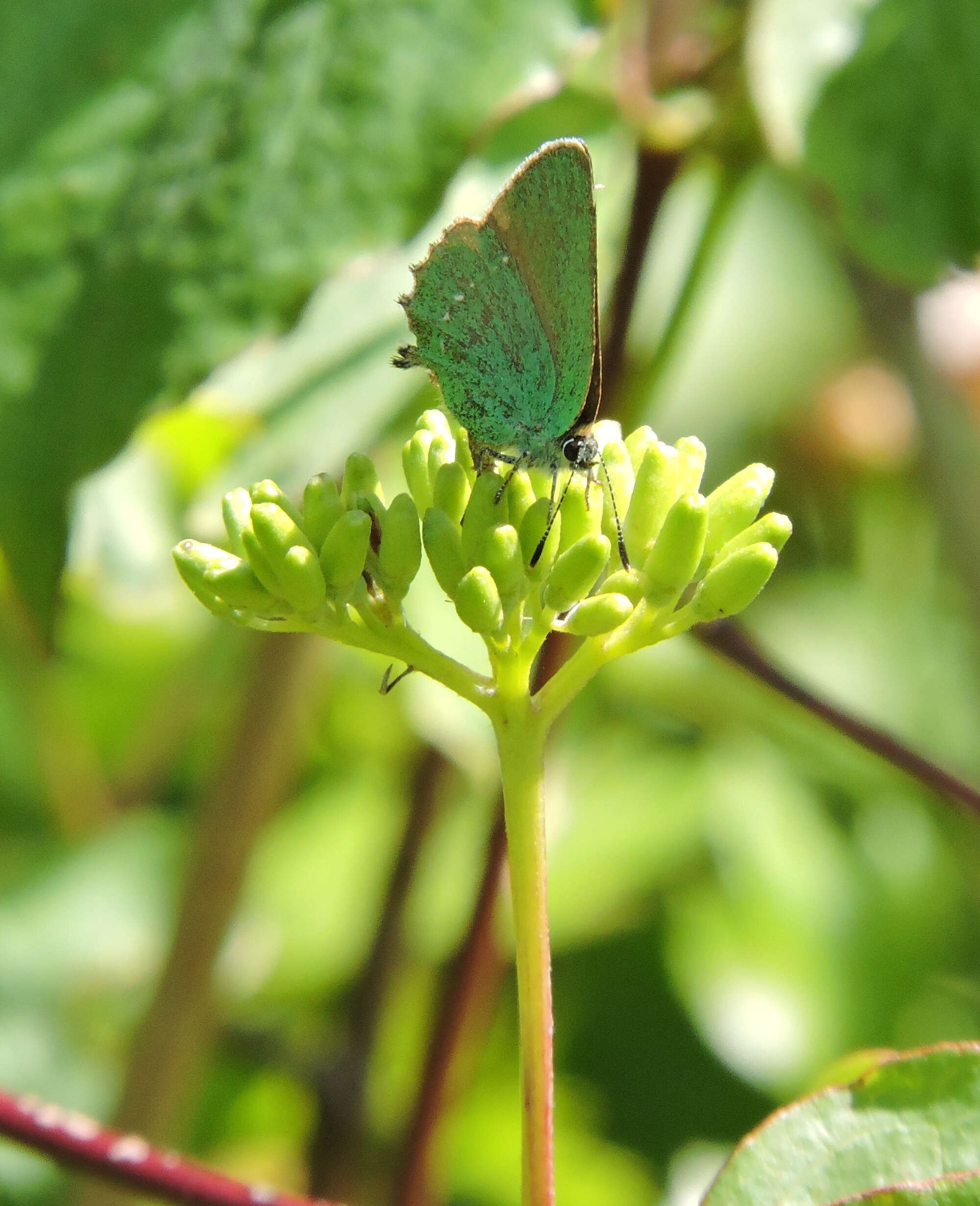 No Green Hairstreaks had ever been recorded in our area - until now! Seen on dogwood, one of its foodplants, this butterfly does not wander and is our claim to fame!
No Green Hairstreaks had ever been recorded in our area - until now! Seen on dogwood, one of its foodplants, this butterfly does not wander and is our claim to fame!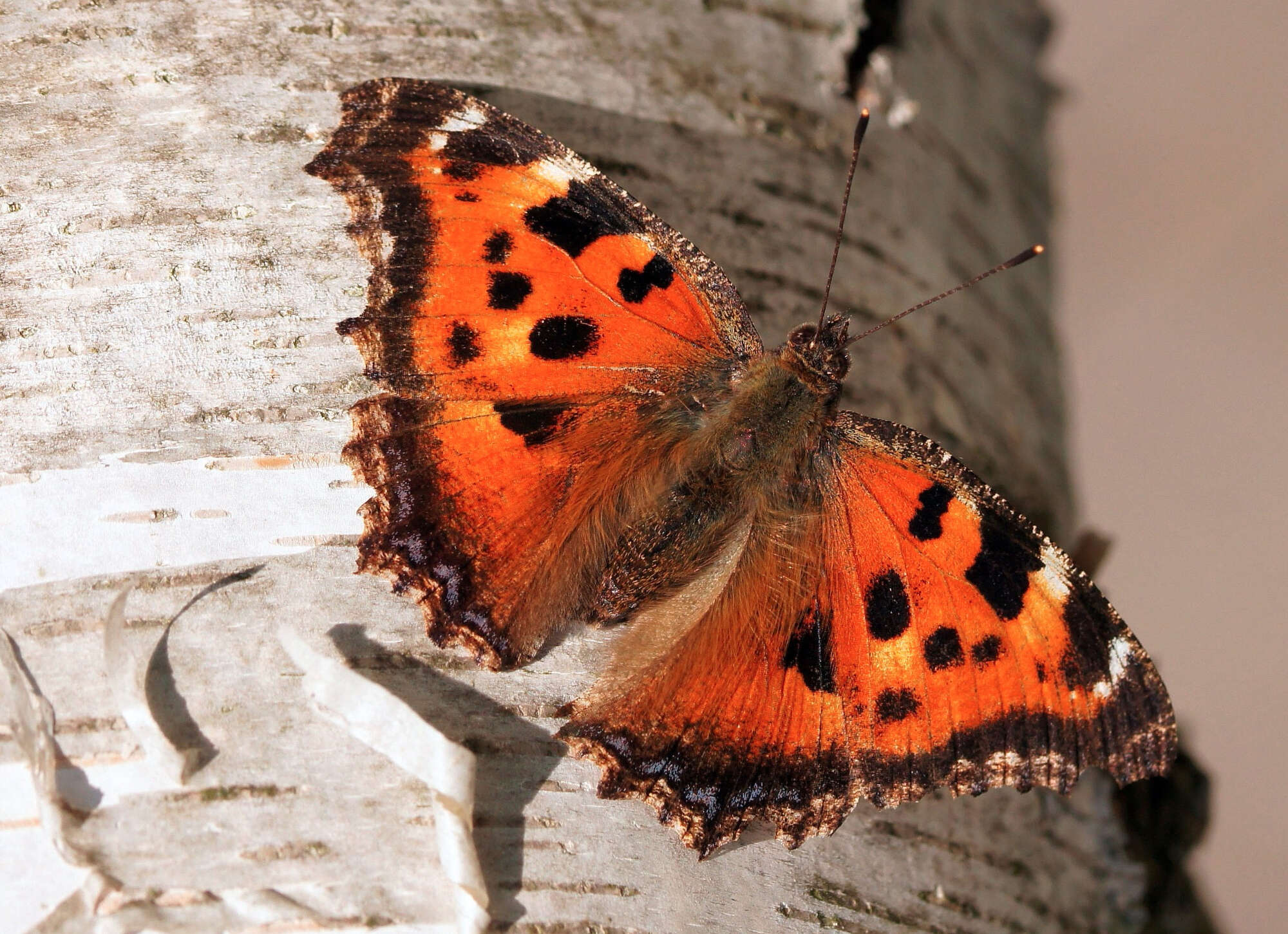 2014 went on record as being the year of the Yellow-legged Tortoiseshell. A one-off year of vagrants from eastern Europe....
2014 went on record as being the year of the Yellow-legged Tortoiseshell. A one-off year of vagrants from eastern Europe....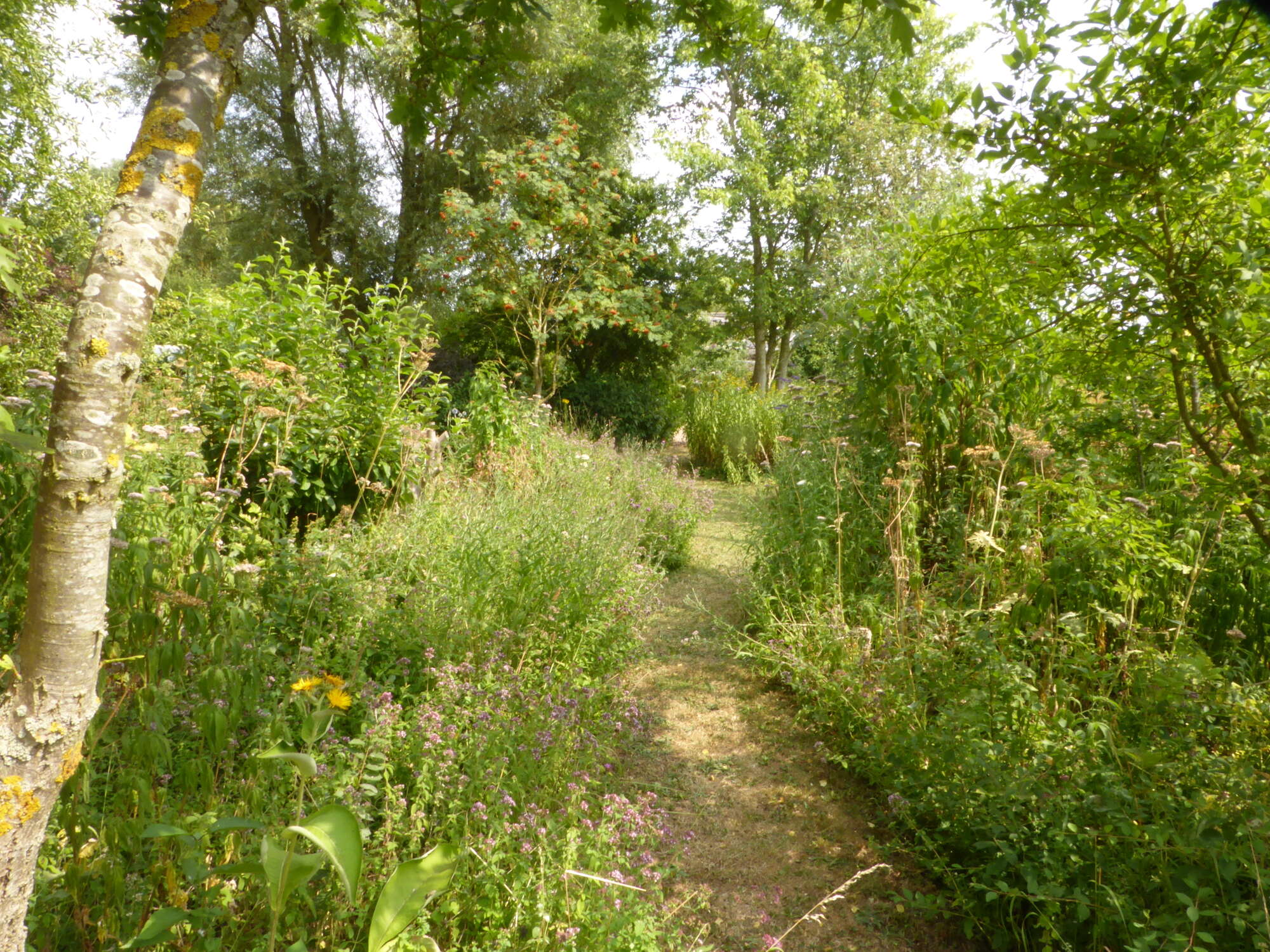 whilst we were away on the west coast!! They were seen in local woodlands back home. At least we now had a proper woodland setting but no such luck seeing them here.
whilst we were away on the west coast!! They were seen in local woodlands back home. At least we now had a proper woodland setting but no such luck seeing them here.
2015
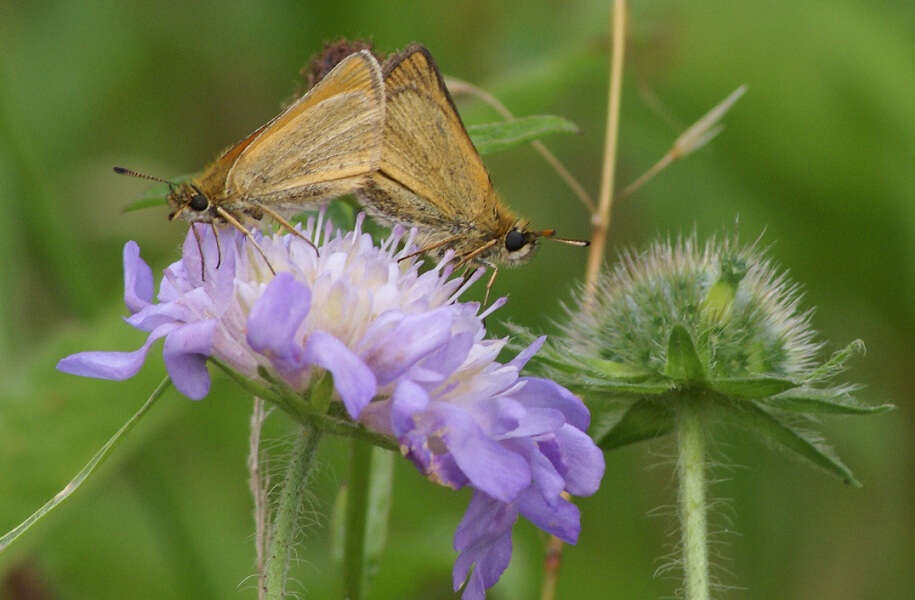 Our old faithful, the Essex Skipper, rewarded us with its best year to date in 2015.
Our old faithful, the Essex Skipper, rewarded us with its best year to date in 2015.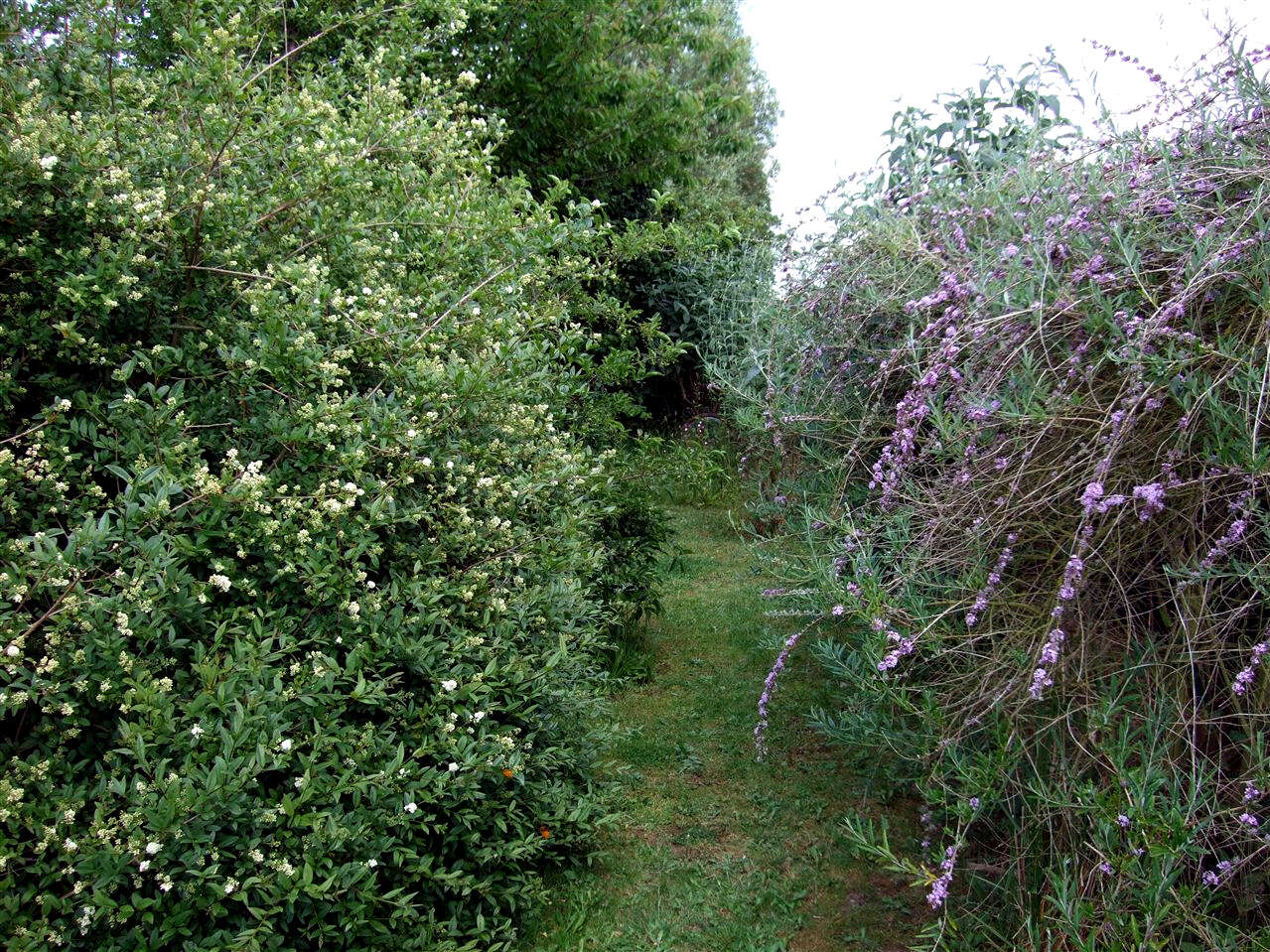 Just like two classic pubs side by side - wild privet and buddleia alternifolia perform a classic nectar double act.
Just like two classic pubs side by side - wild privet and buddleia alternifolia perform a classic nectar double act.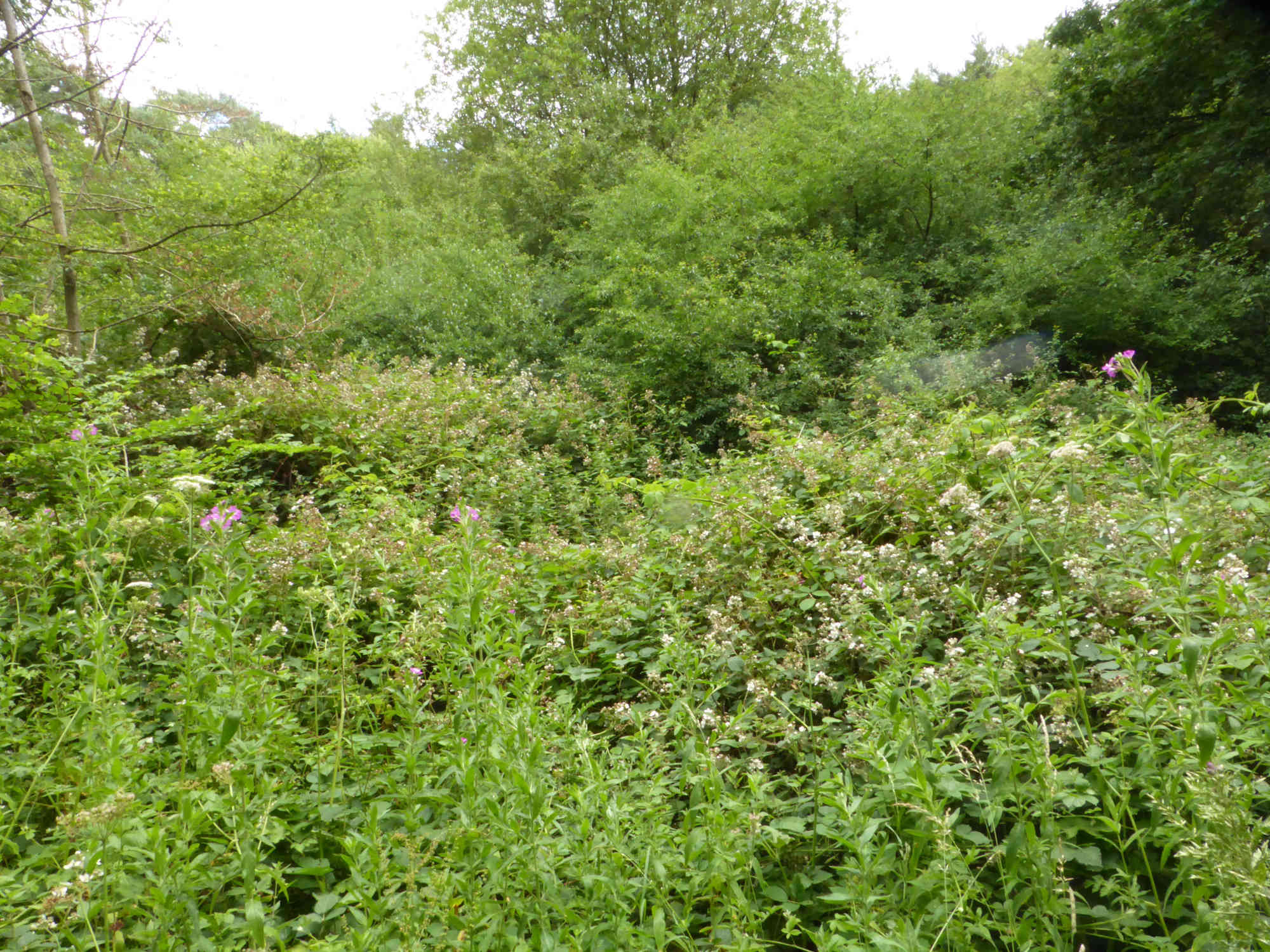 Bramble blossom is amongst the very best of the nectar plants. We have encouraged out of the way bramble thickets.
Bramble blossom is amongst the very best of the nectar plants. We have encouraged out of the way bramble thickets.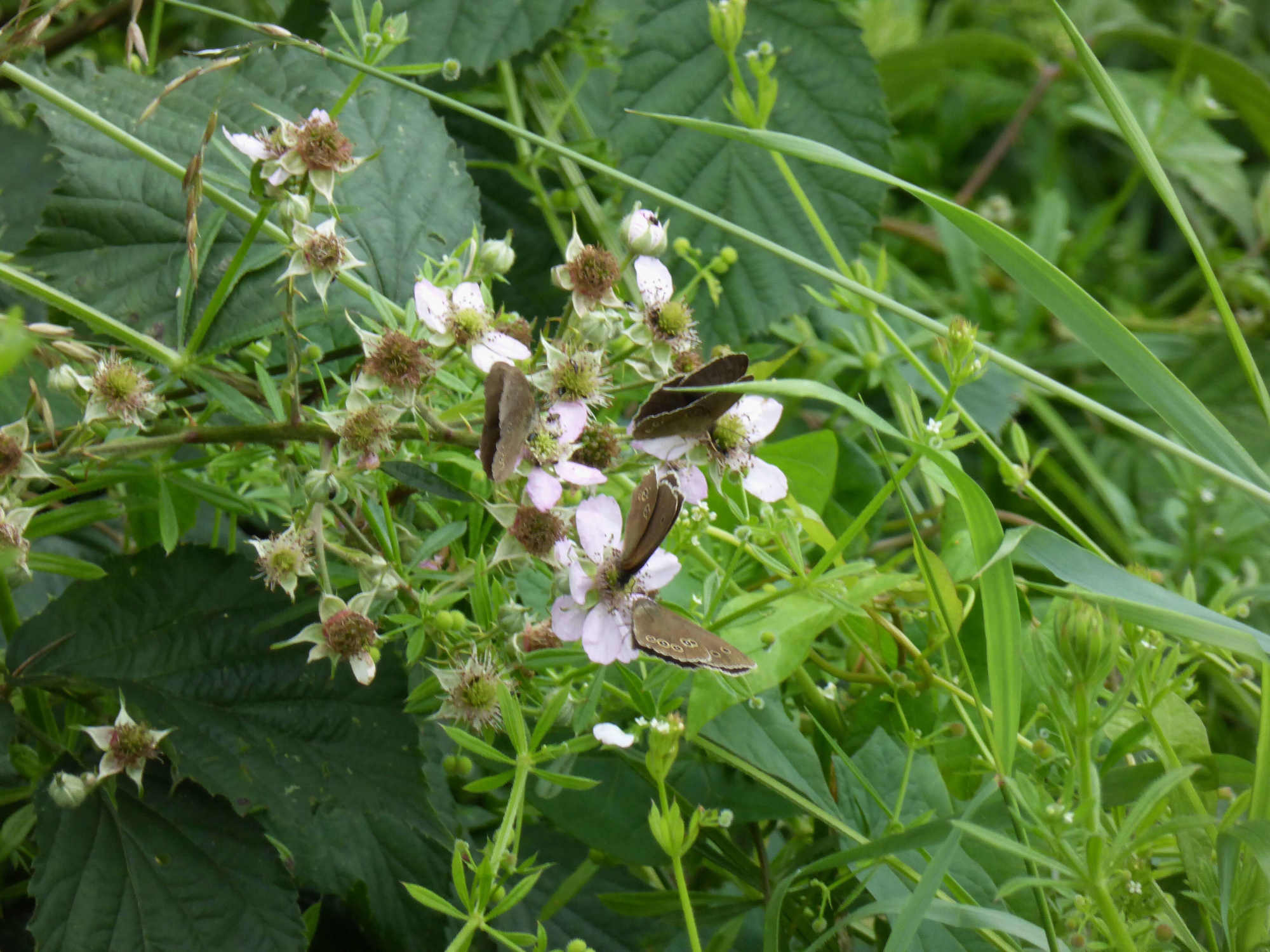 This gathering of Ringlets feasting on bramble blossom speaks volumes.
This gathering of Ringlets feasting on bramble blossom speaks volumes.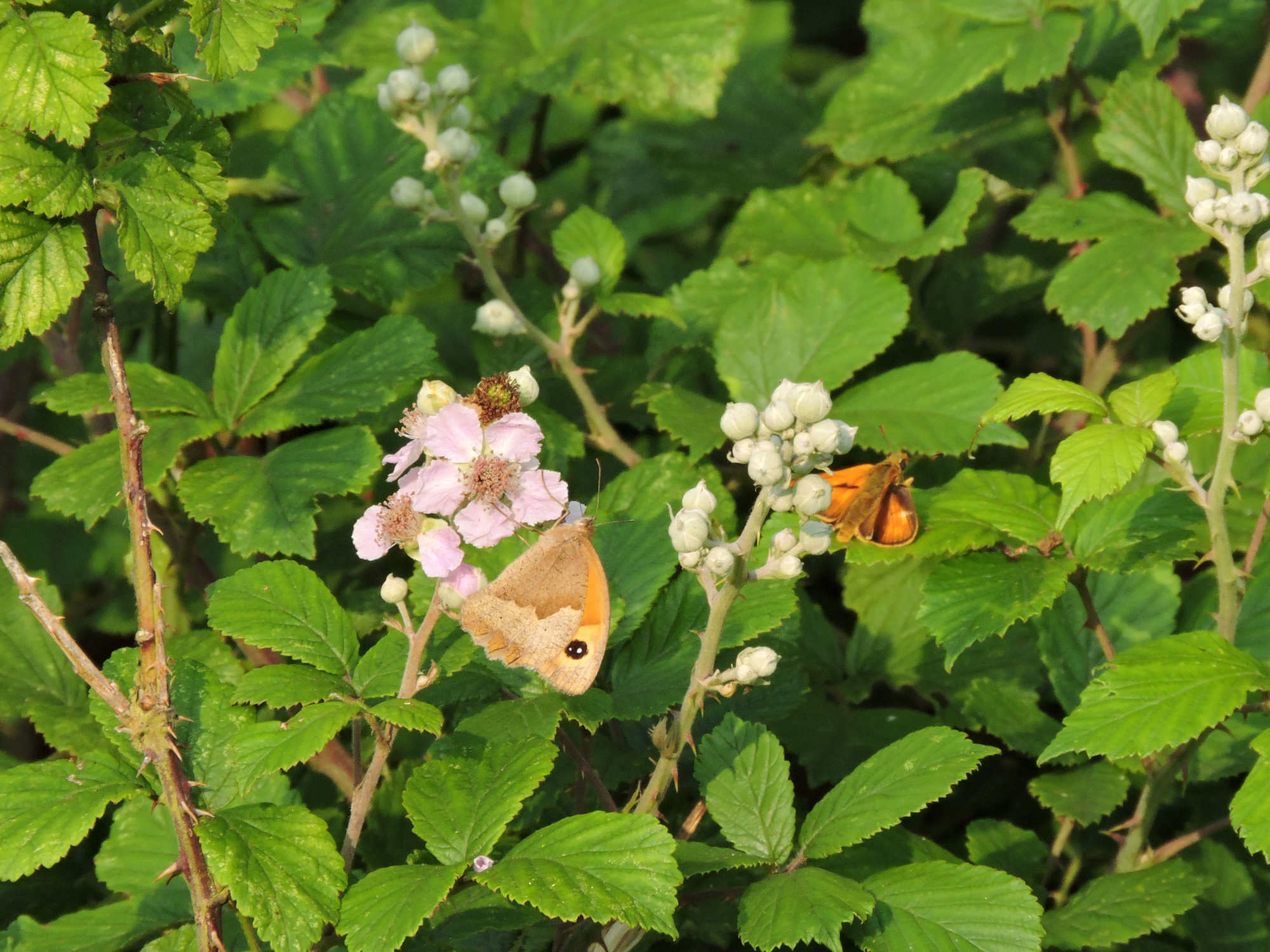 Meadow Brown on bramble with a Small Skipper in the background.
Meadow Brown on bramble with a Small Skipper in the background.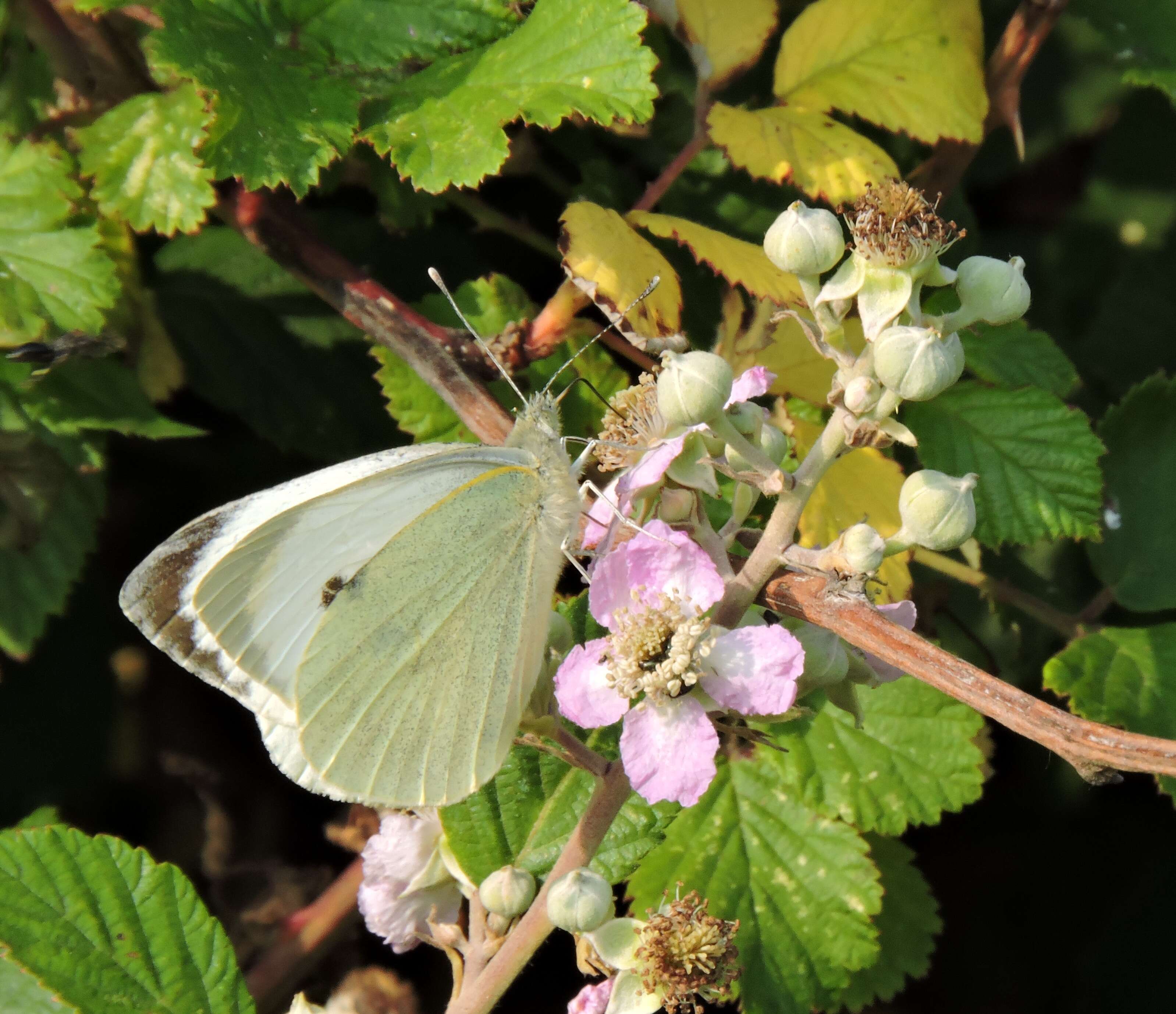 Large White taking its turn on the bramble blossom.
Large White taking its turn on the bramble blossom.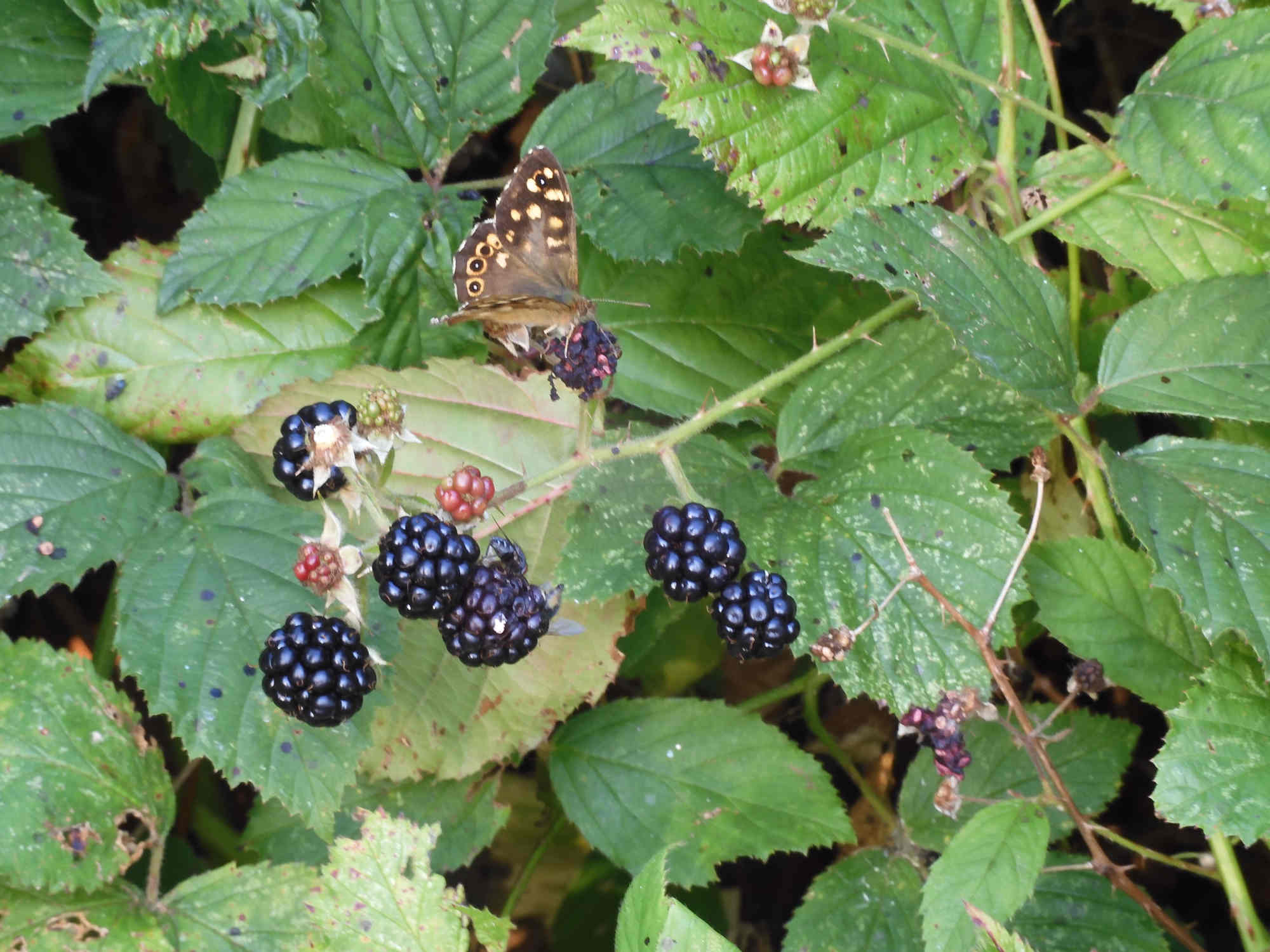 In the autumn Speckled Woods adore the blackberries.
In the autumn Speckled Woods adore the blackberries.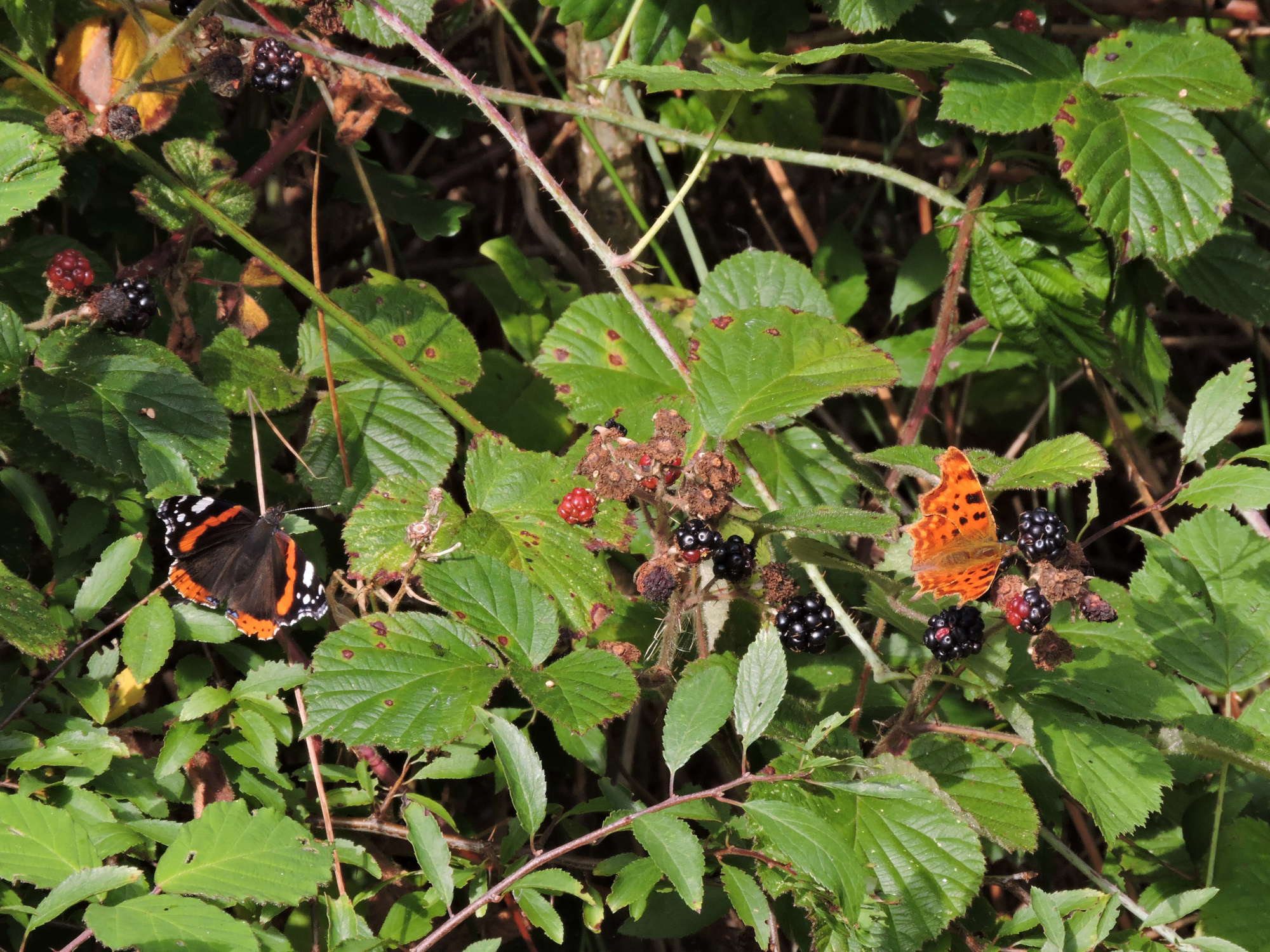 As do the Comma and Red Admiral.
As do the Comma and Red Admiral.
2016
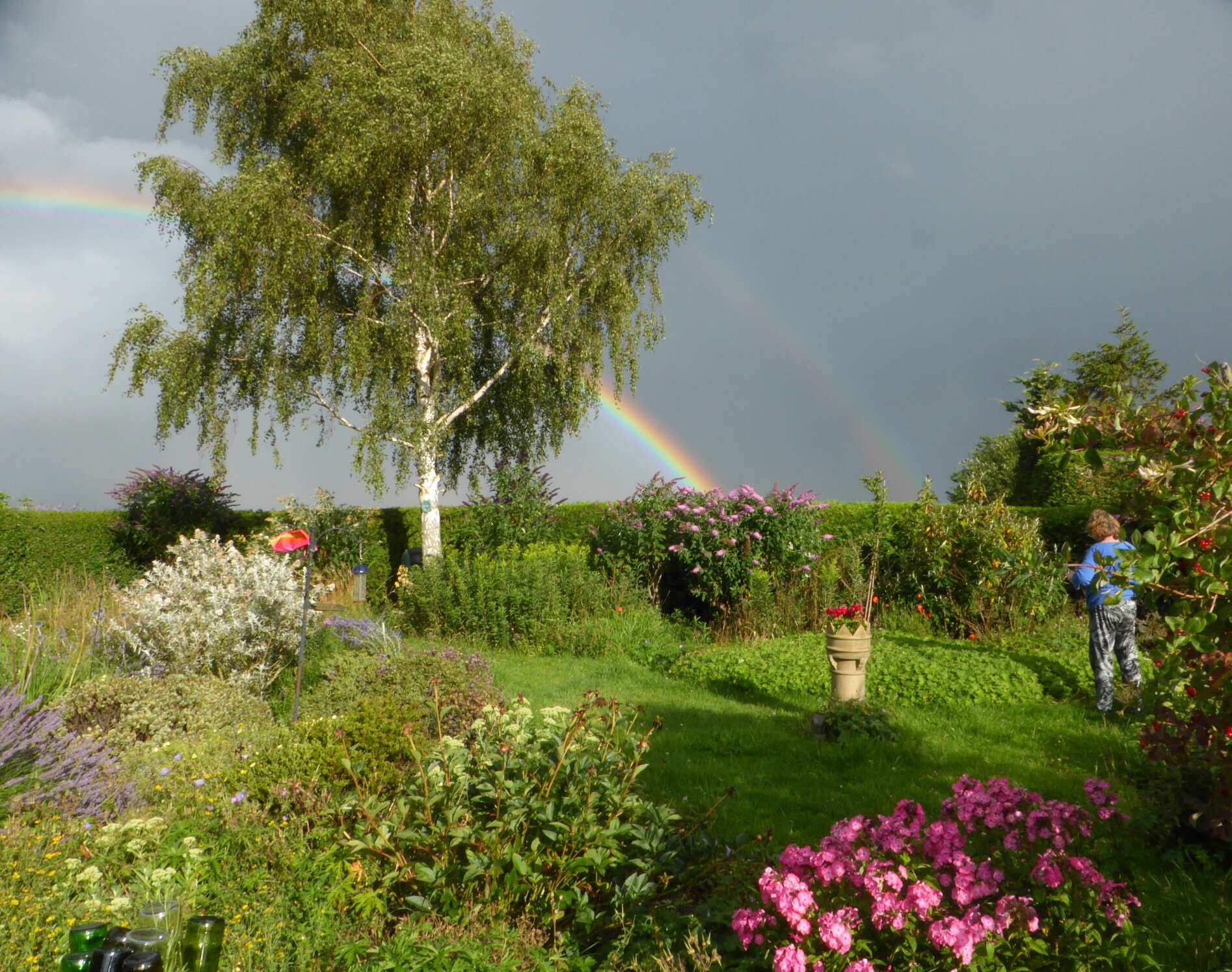 2007, 2012, and now 2016 being officially classed as the all-time worst butterfly year. One thing we cannot control is the weather - so onwards and upwards!
2007, 2012, and now 2016 being officially classed as the all-time worst butterfly year. One thing we cannot control is the weather - so onwards and upwards!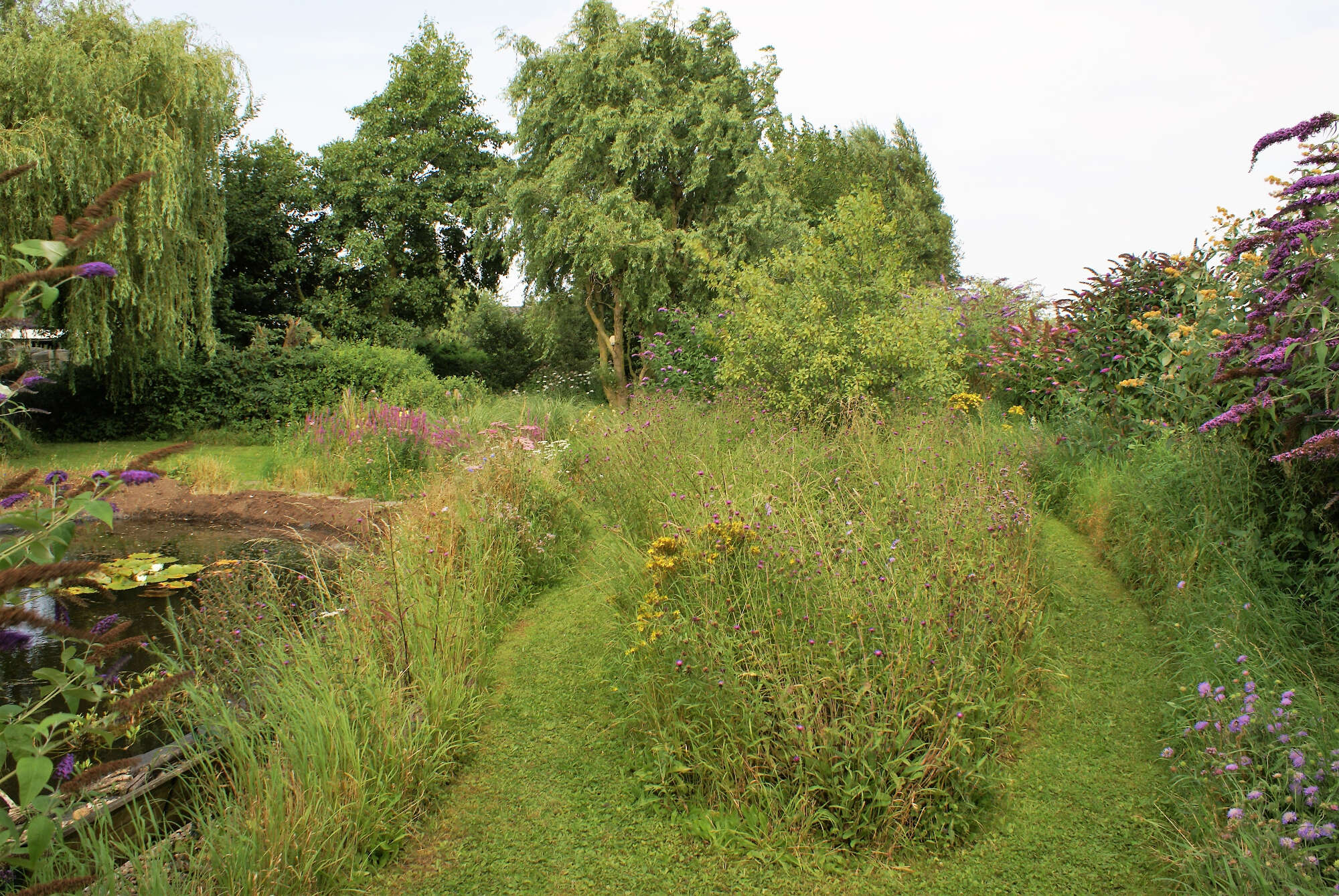 Yet even in bad years, this small area known as The Hollow always produces plentiful sightings.
Yet even in bad years, this small area known as The Hollow always produces plentiful sightings.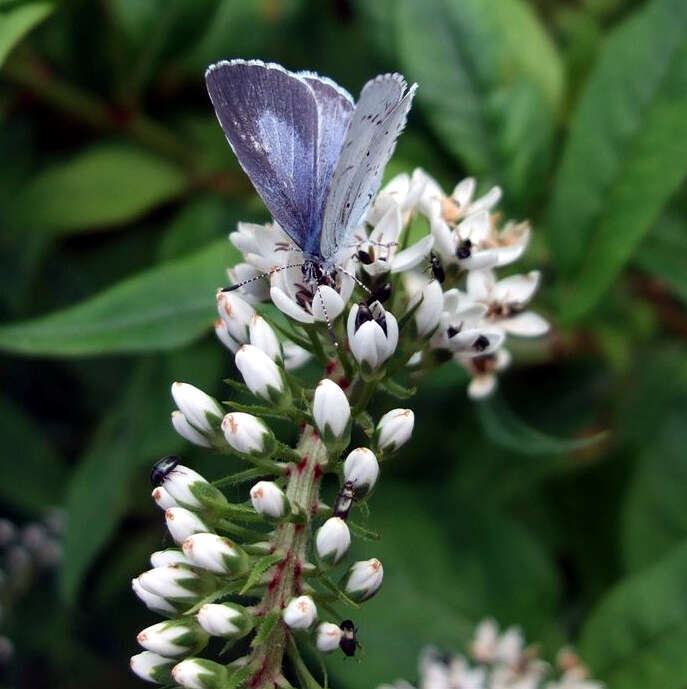 Bucking the trend this time, it was the turn of the Holly Blue to make a dramatic comeback.
Bucking the trend this time, it was the turn of the Holly Blue to make a dramatic comeback.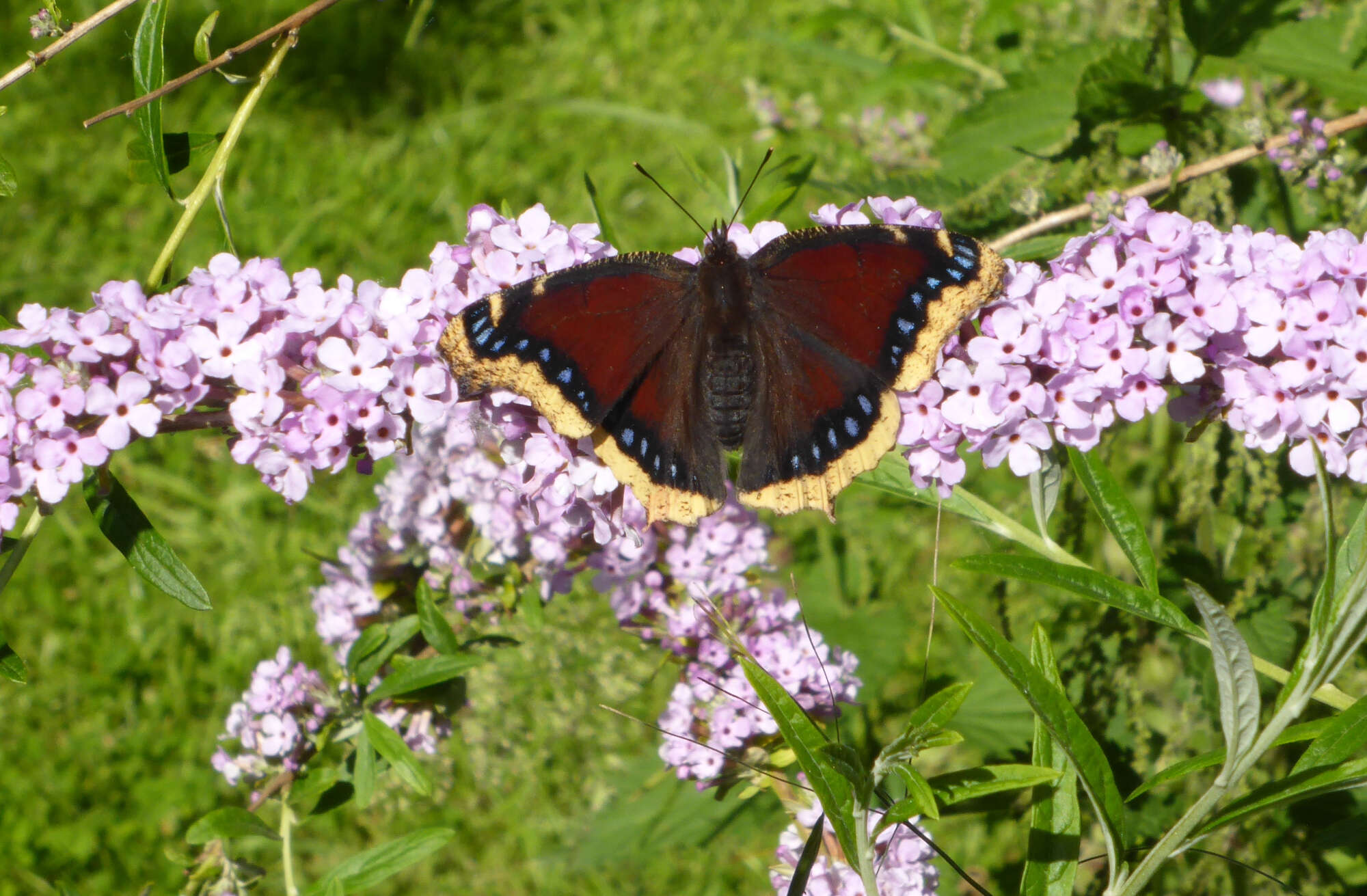 Since moving over here we expected to see a rare migrant Camberwell Beauty, with them coming from the east. Ironically, one appeared in a neighbour's garden!
Since moving over here we expected to see a rare migrant Camberwell Beauty, with them coming from the east. Ironically, one appeared in a neighbour's garden!
2017
At long last nature organisations were beginning to realise that we have something to offer here: the # 2014 Green Hairstreak sighting paved the way, augmented by numbers of other species that are far more than you would expect from a garden habitat. It was designated a special wildlife site and forms part of the Black Sluice Internal Drainage Board’s biodiversity plan.
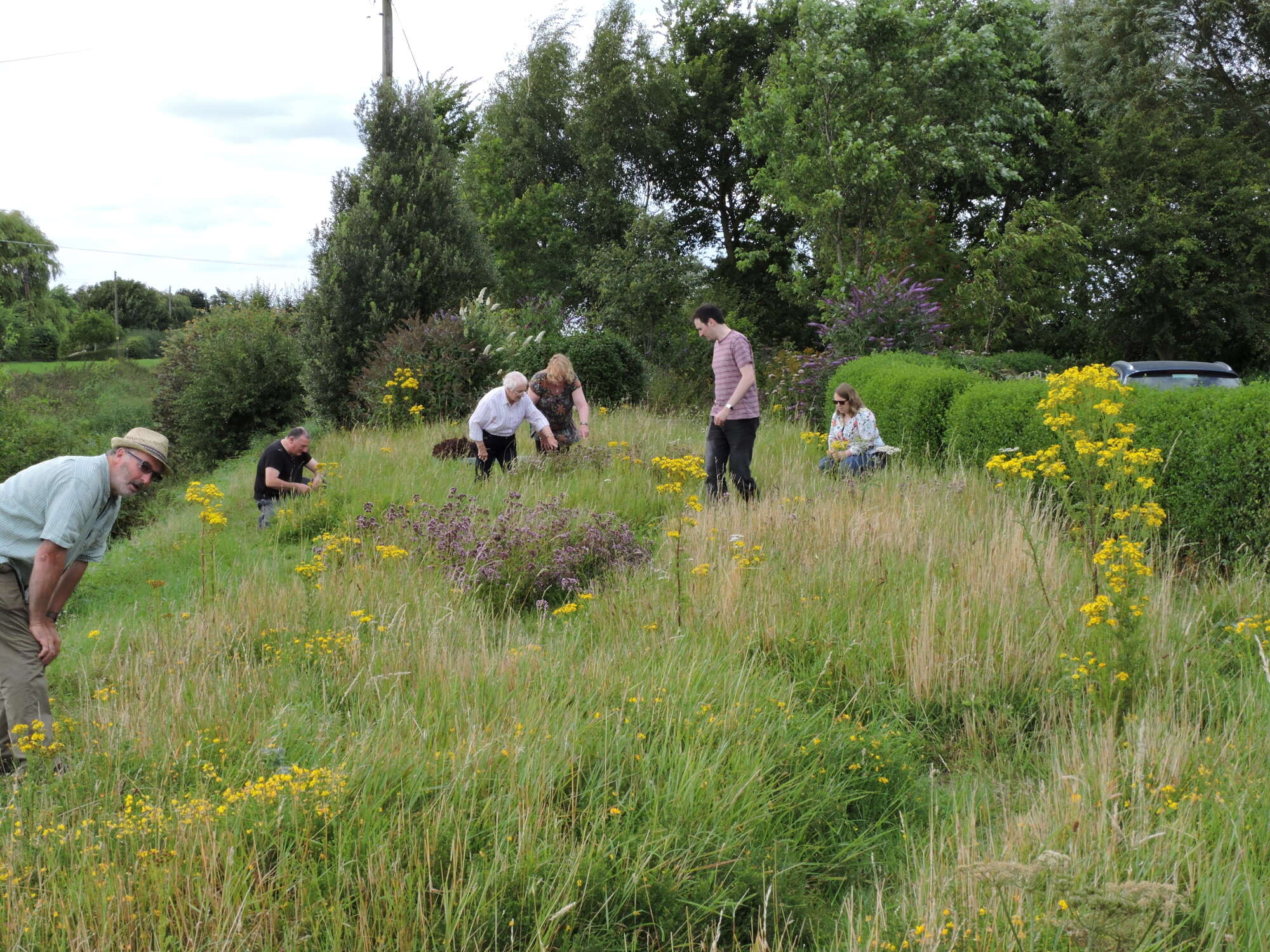 Plenty of interest was and is shown in our award winning conservation project.
Plenty of interest was and is shown in our award winning conservation project.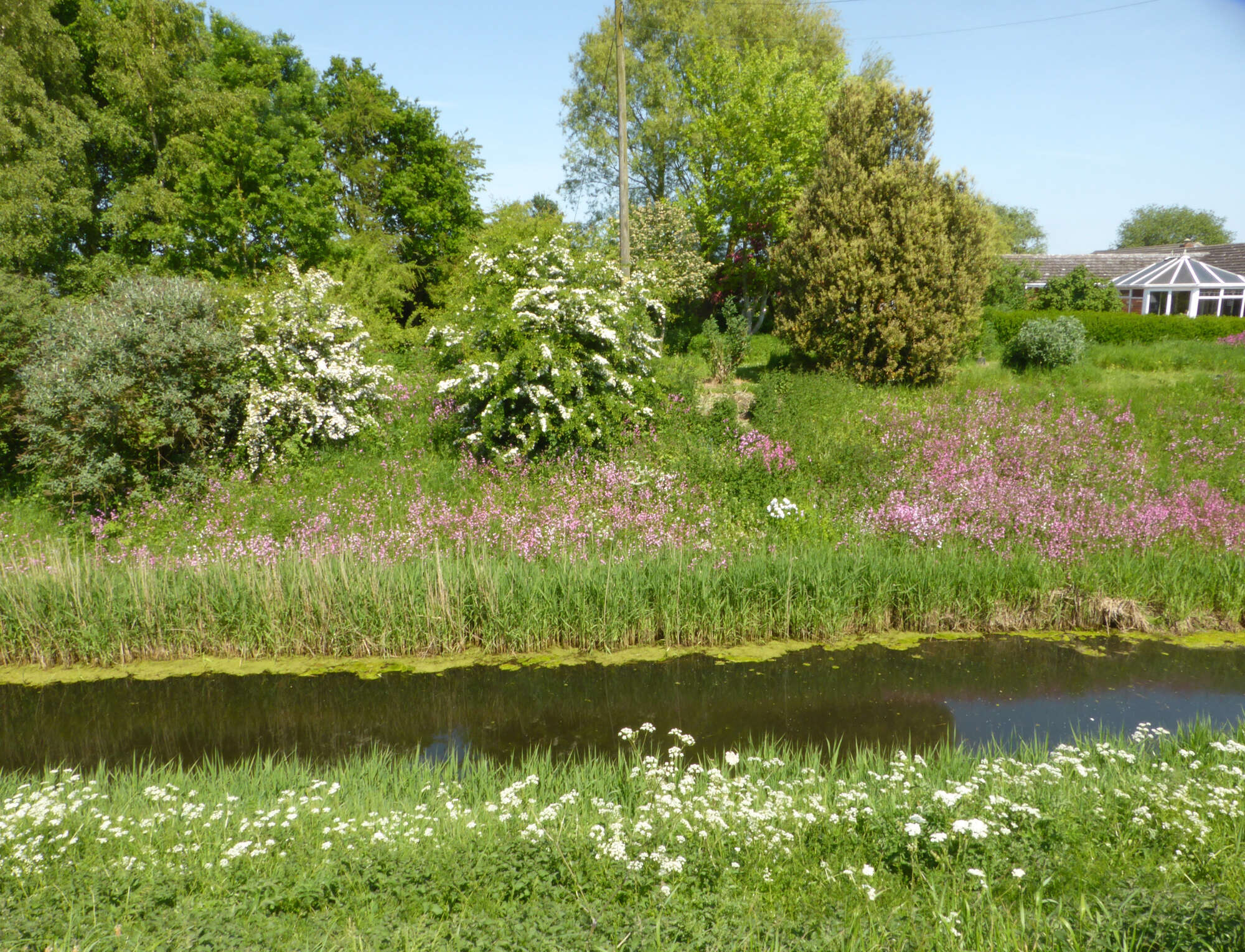 The flowery dyke banks with our woodland garden beyond.
The flowery dyke banks with our woodland garden beyond.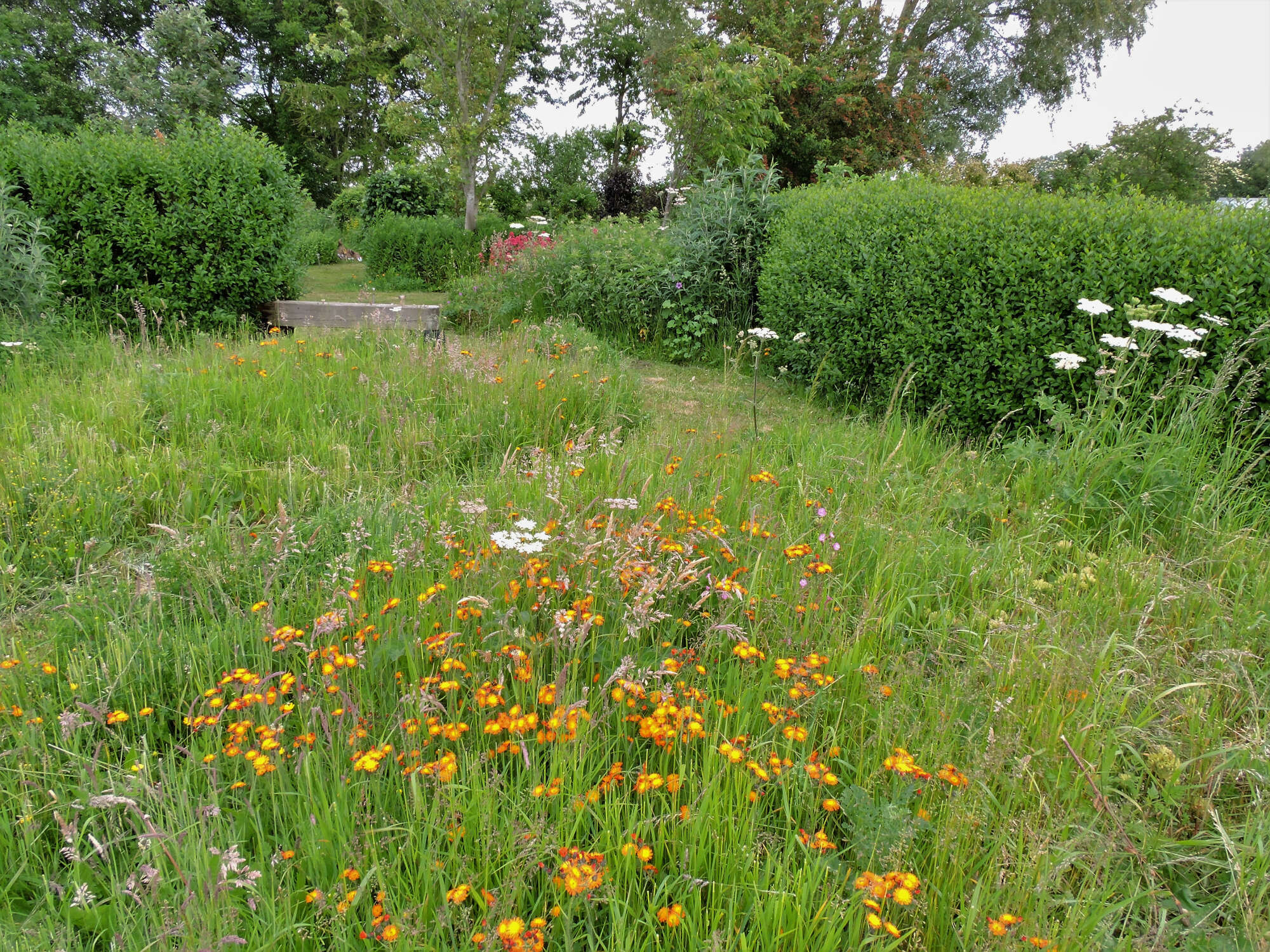 The meadow merges into the woodland.
The meadow merges into the woodland.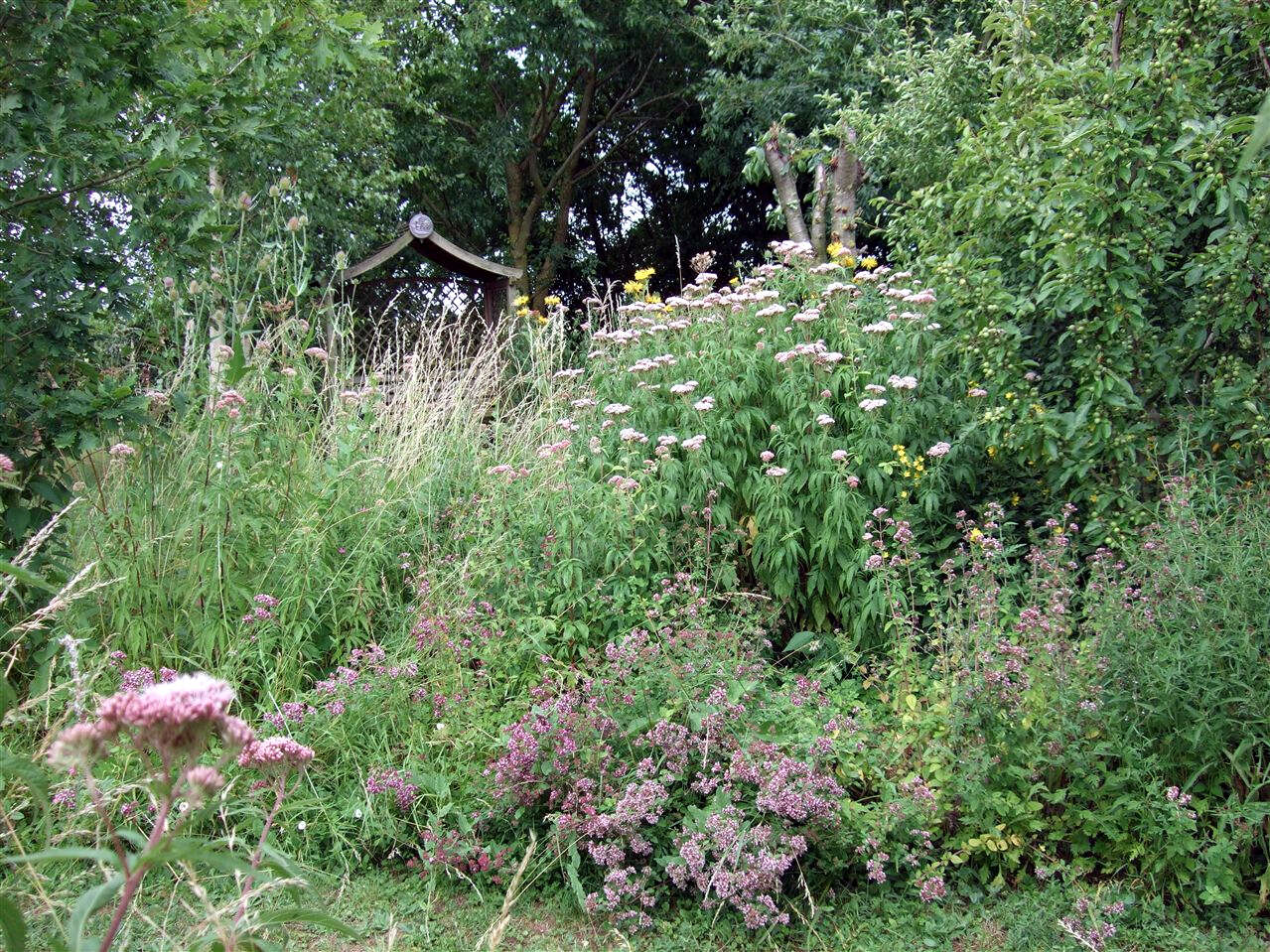 A predominantly elm-ash-oak backdrop to the main flowery glade of the woodland garden.
A predominantly elm-ash-oak backdrop to the main flowery glade of the woodland garden.
2018
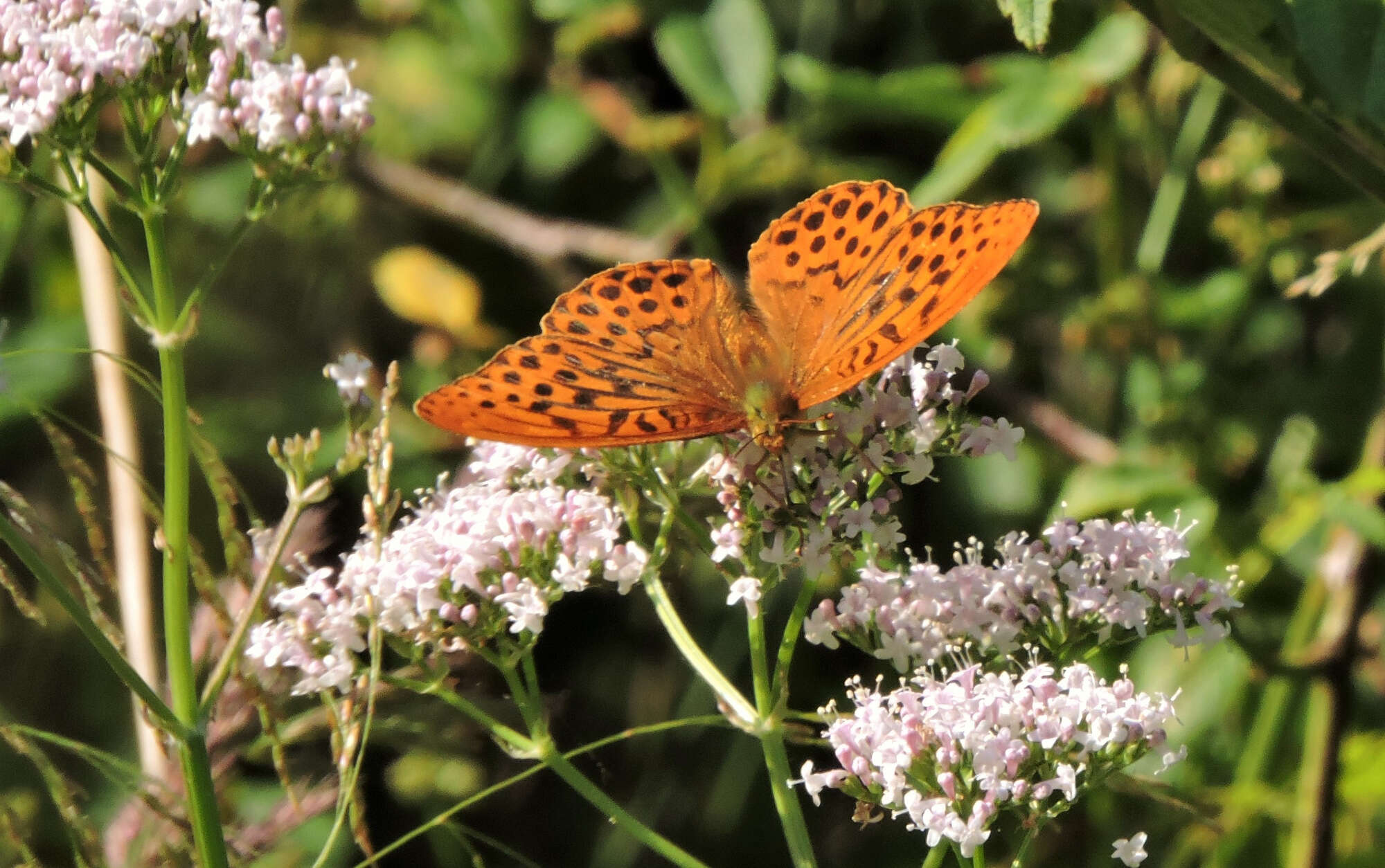 By 2018 the Silver-washed Fritillary was making major advances throughout the Lincolnshire woodlands - 3 were seen in our garden!
By 2018 the Silver-washed Fritillary was making major advances throughout the Lincolnshire woodlands - 3 were seen in our garden!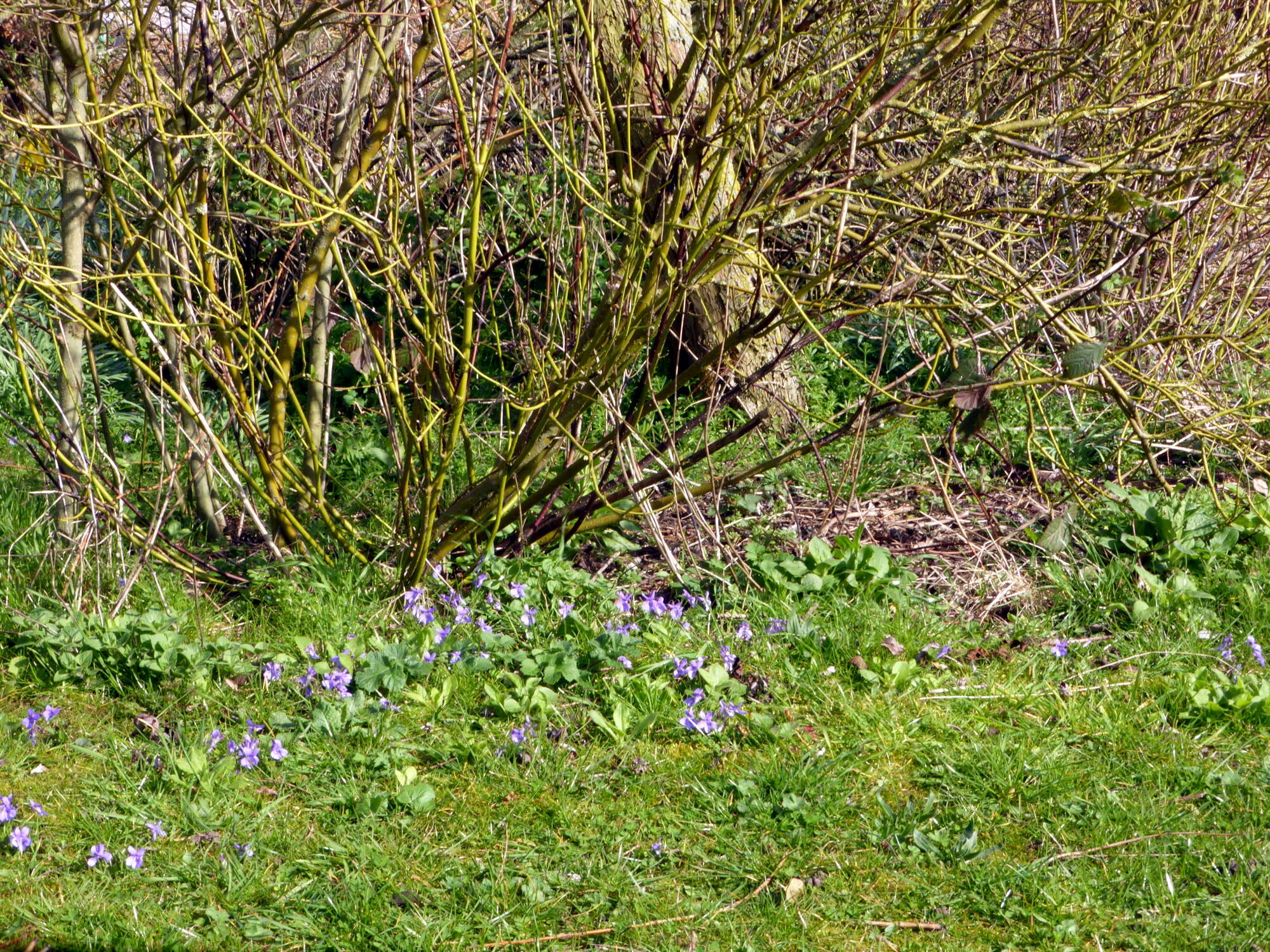 Violets, their larval foodplant, growing close to trees just as the females like them for egg-laying.
Violets, their larval foodplant, growing close to trees just as the females like them for egg-laying.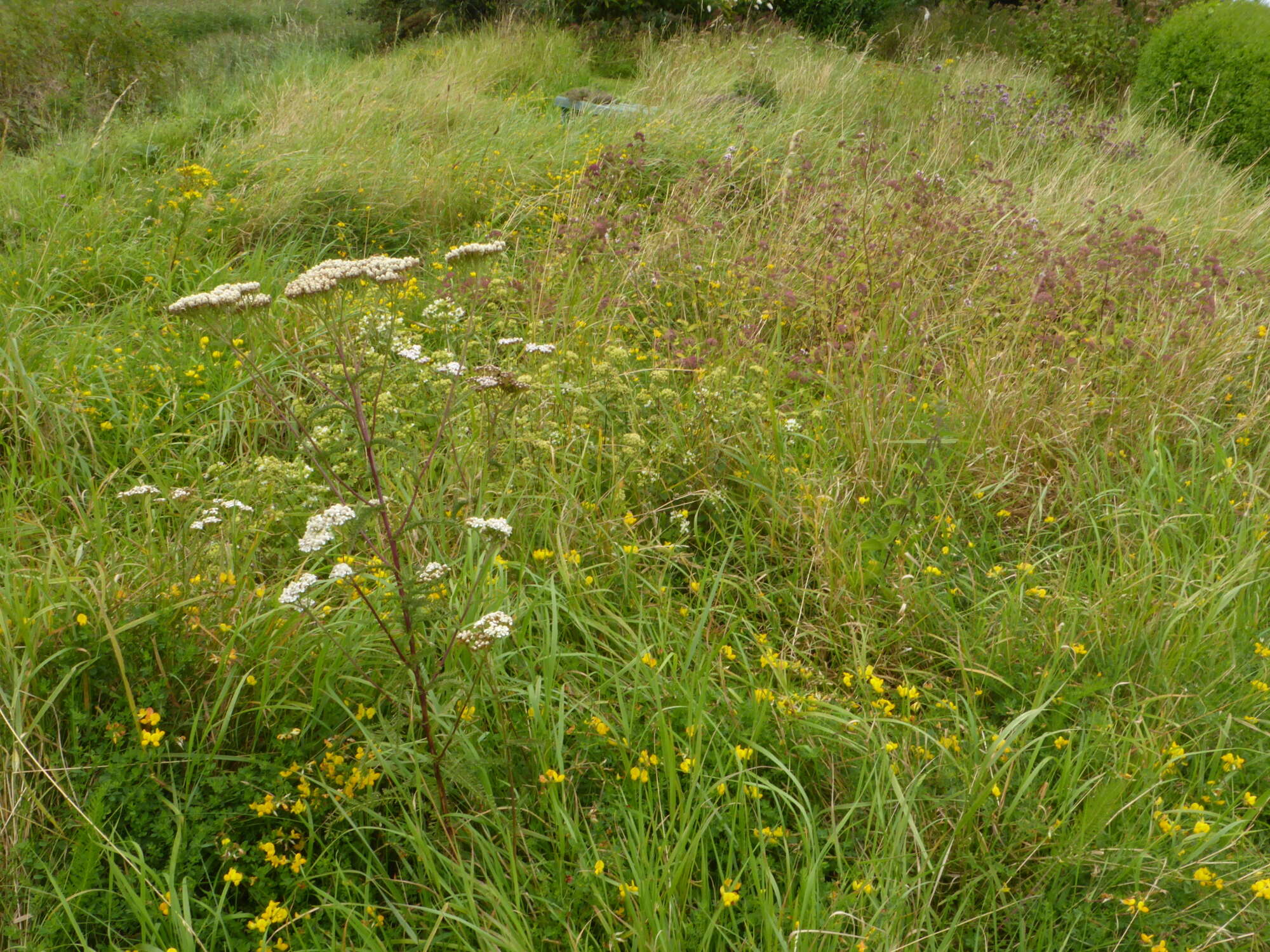 Proof that the meadow is correctly managed - an amazing Common Blue - Brown Argus boanaza....
Proof that the meadow is correctly managed - an amazing Common Blue - Brown Argus boanaza....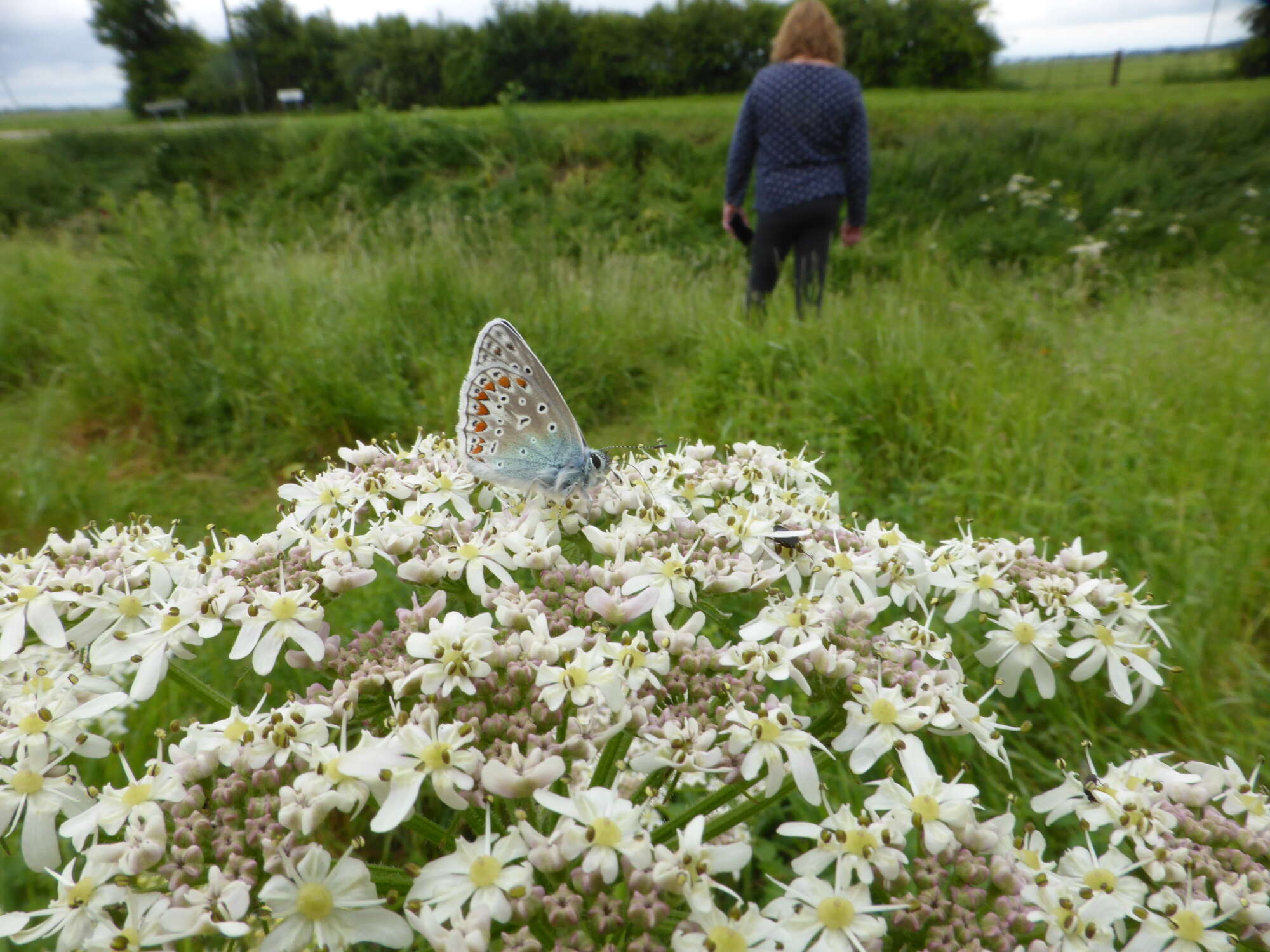 85 Common Blue and.....
85 Common Blue and.....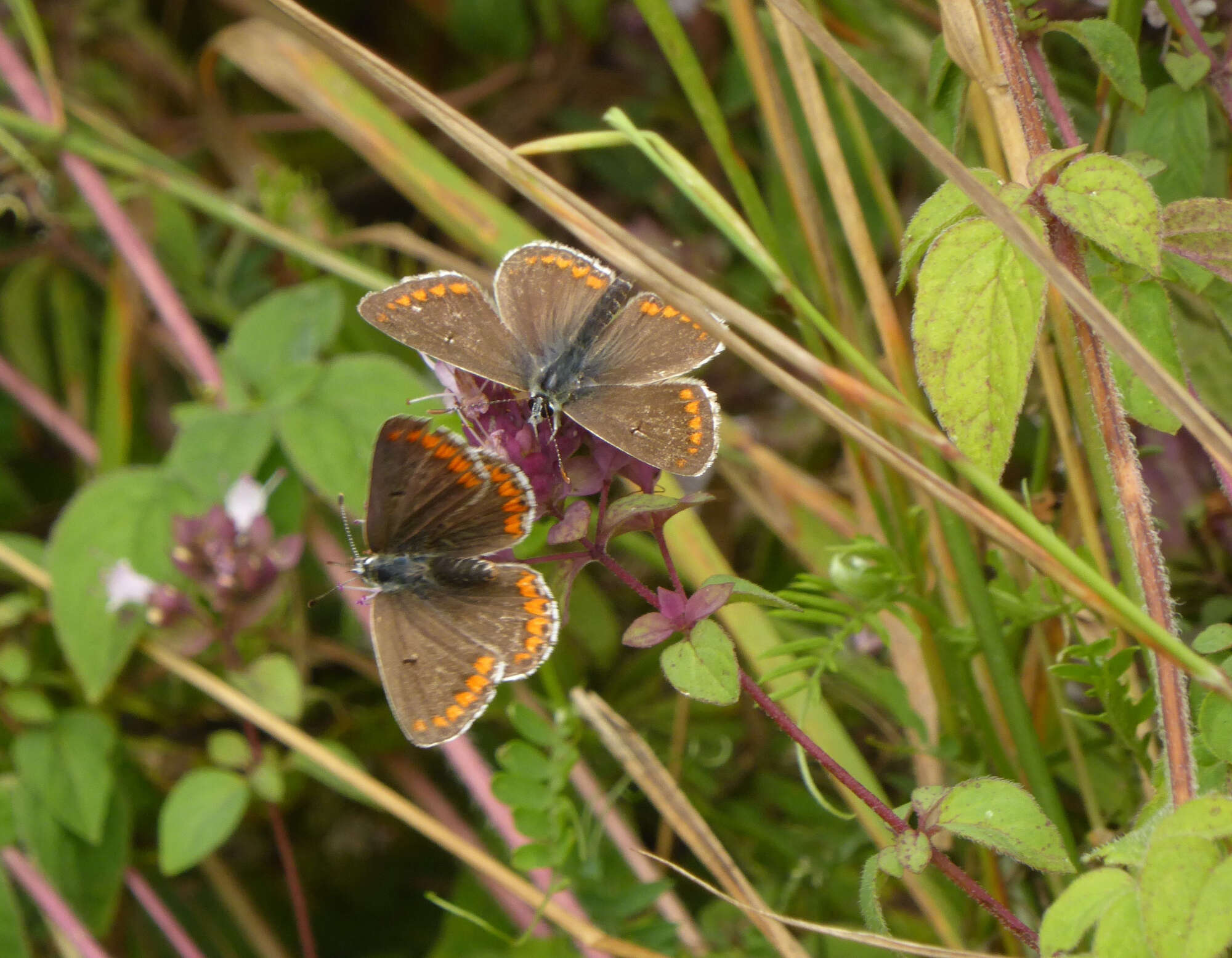 ... 58 Brown Argus counted on one day!
... 58 Brown Argus counted on one day!
2019
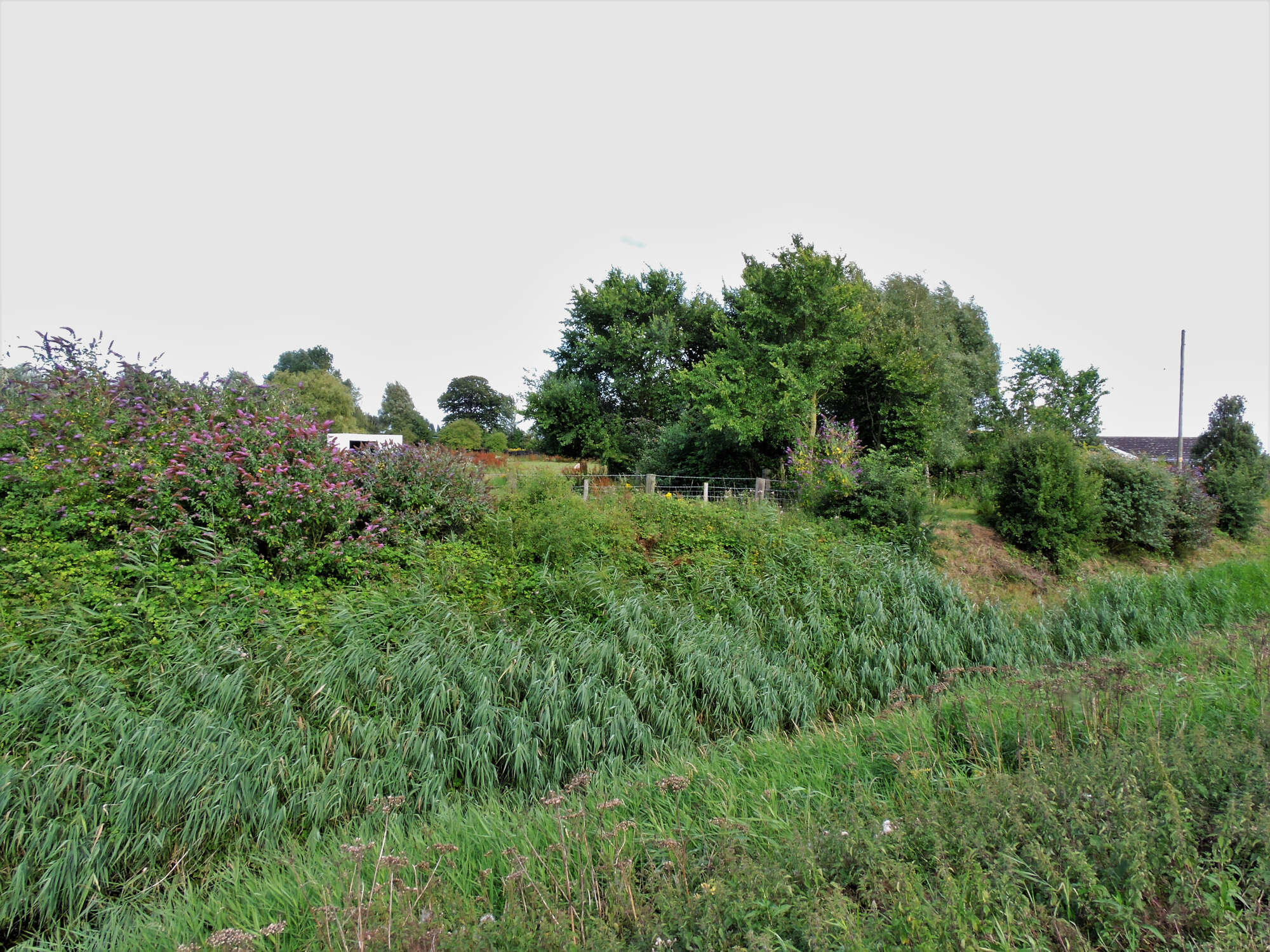 Our neighbouring field also has marginal buddleias, extending the habitiat. Trees at this end of our wood are elm, but still no sign of the elusive White-letter Hairstreak.
Our neighbouring field also has marginal buddleias, extending the habitiat. Trees at this end of our wood are elm, but still no sign of the elusive White-letter Hairstreak.
2020
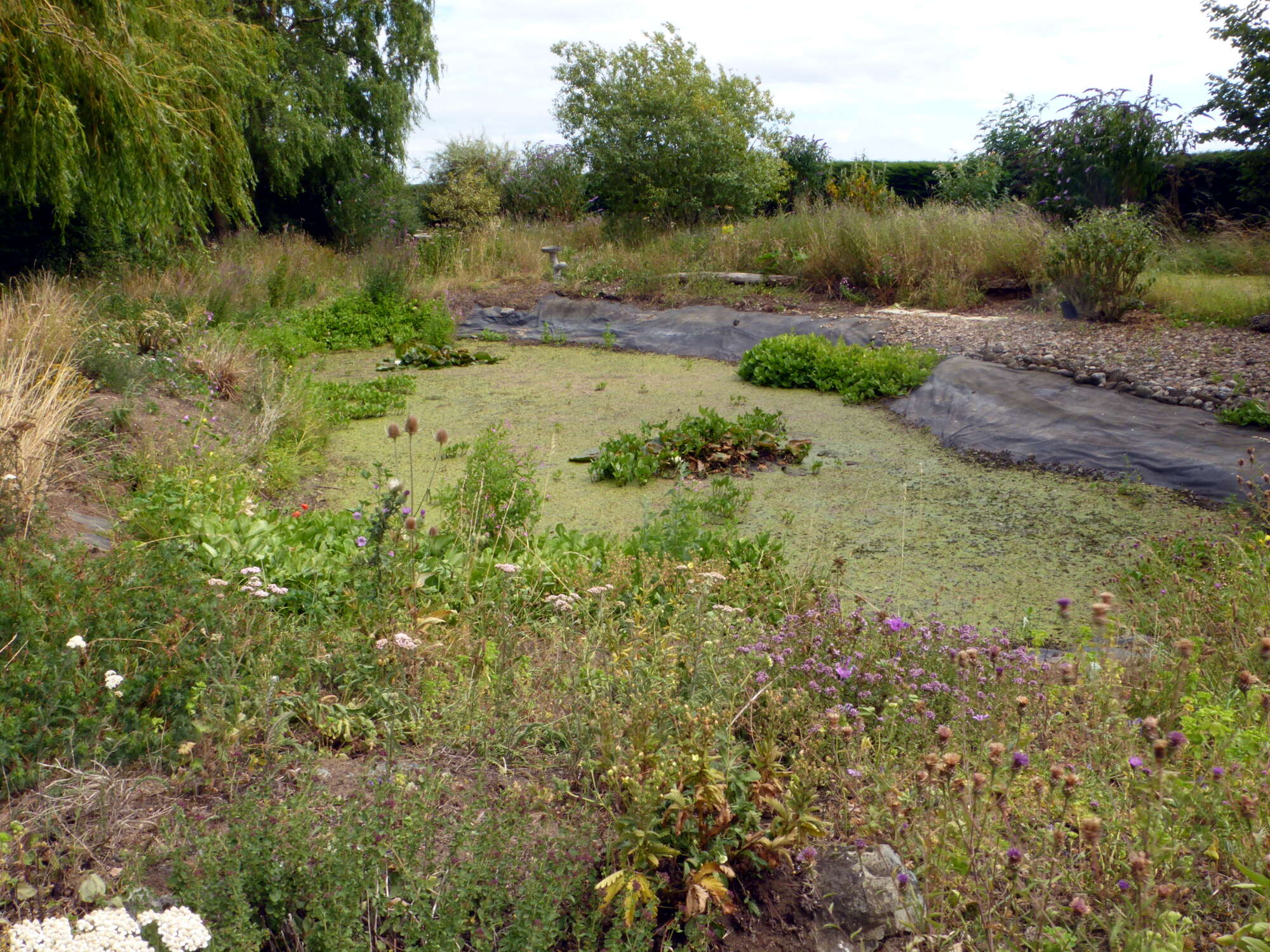 A major drying up of the pond during summer at least creates a marsh habitat, better for butterflies. This may have to be the way forward.
A major drying up of the pond during summer at least creates a marsh habitat, better for butterflies. This may have to be the way forward.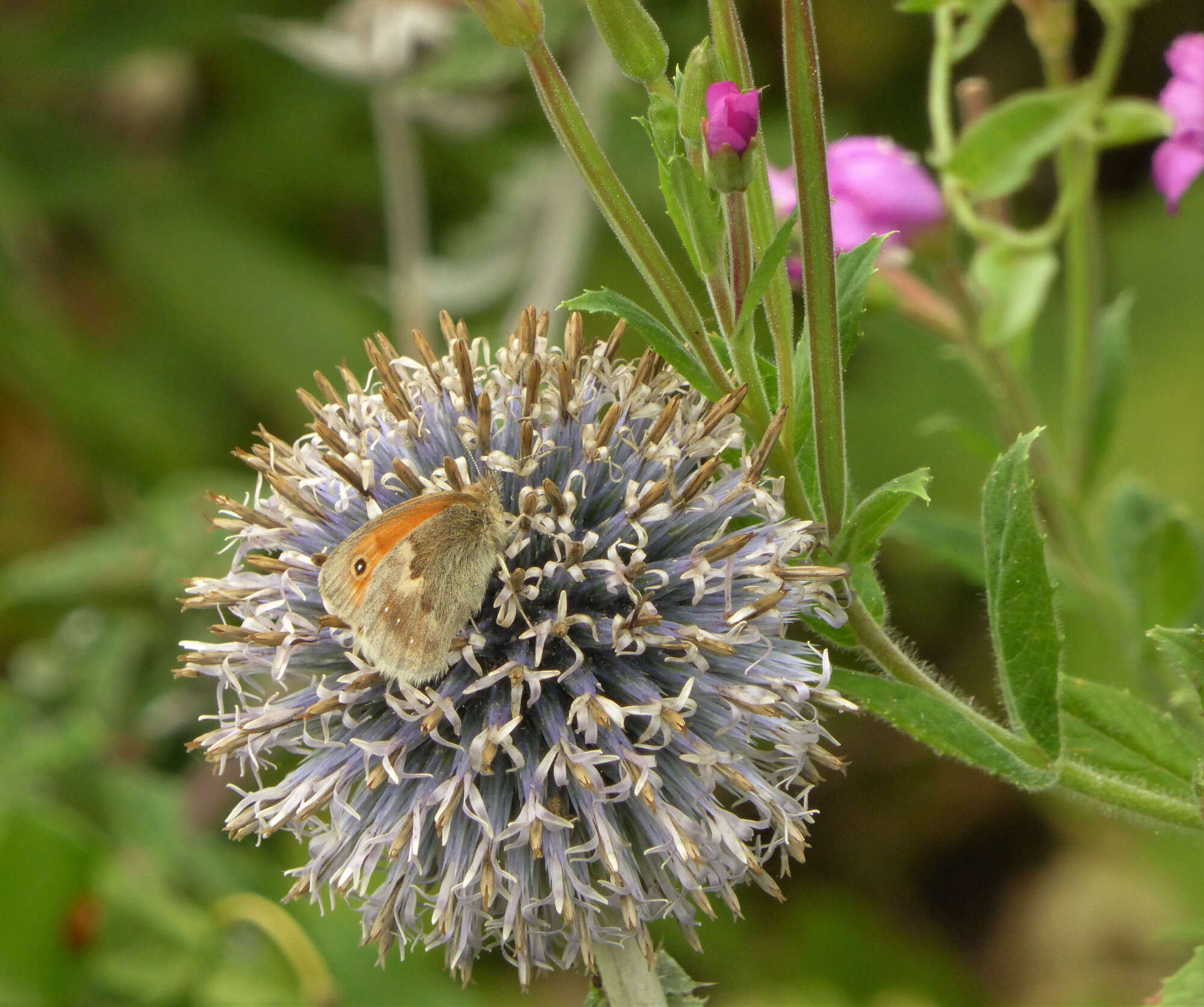 Very pleased to report that the Small Heath appears to be recolonising our land again.
Very pleased to report that the Small Heath appears to be recolonising our land again.
2021
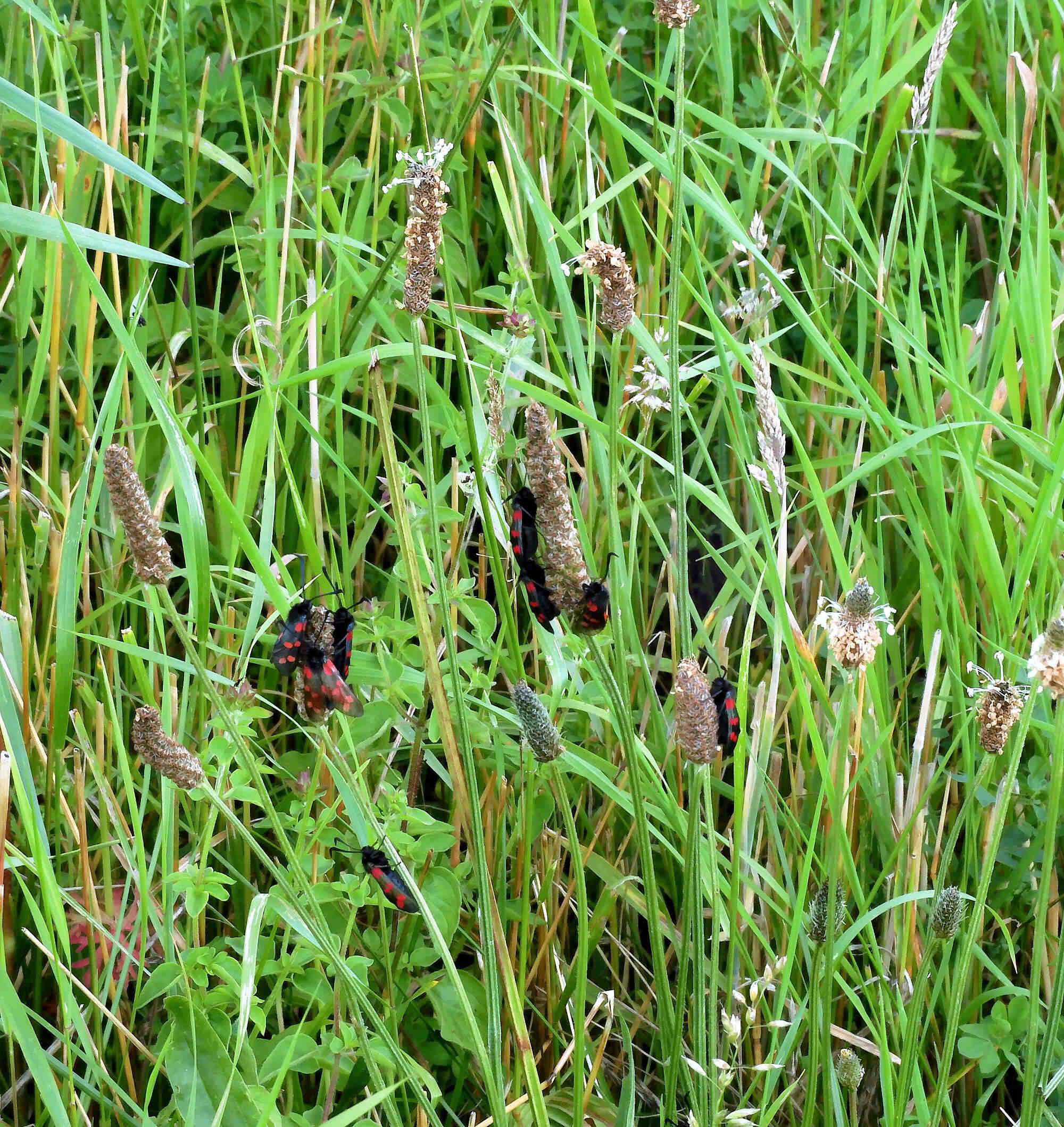 For 3 years running the Six-spot Burnet moth excelled, this year with a massive total just short of 200.
For 3 years running the Six-spot Burnet moth excelled, this year with a massive total just short of 200._there_would_be_little_left_for_the_Blues....jpg) I feared that with them using the same foodplant as the Common Blue (birds-foot trefoil) there would be little left for the Blues...
I feared that with them using the same foodplant as the Common Blue (birds-foot trefoil) there would be little left for the Blues...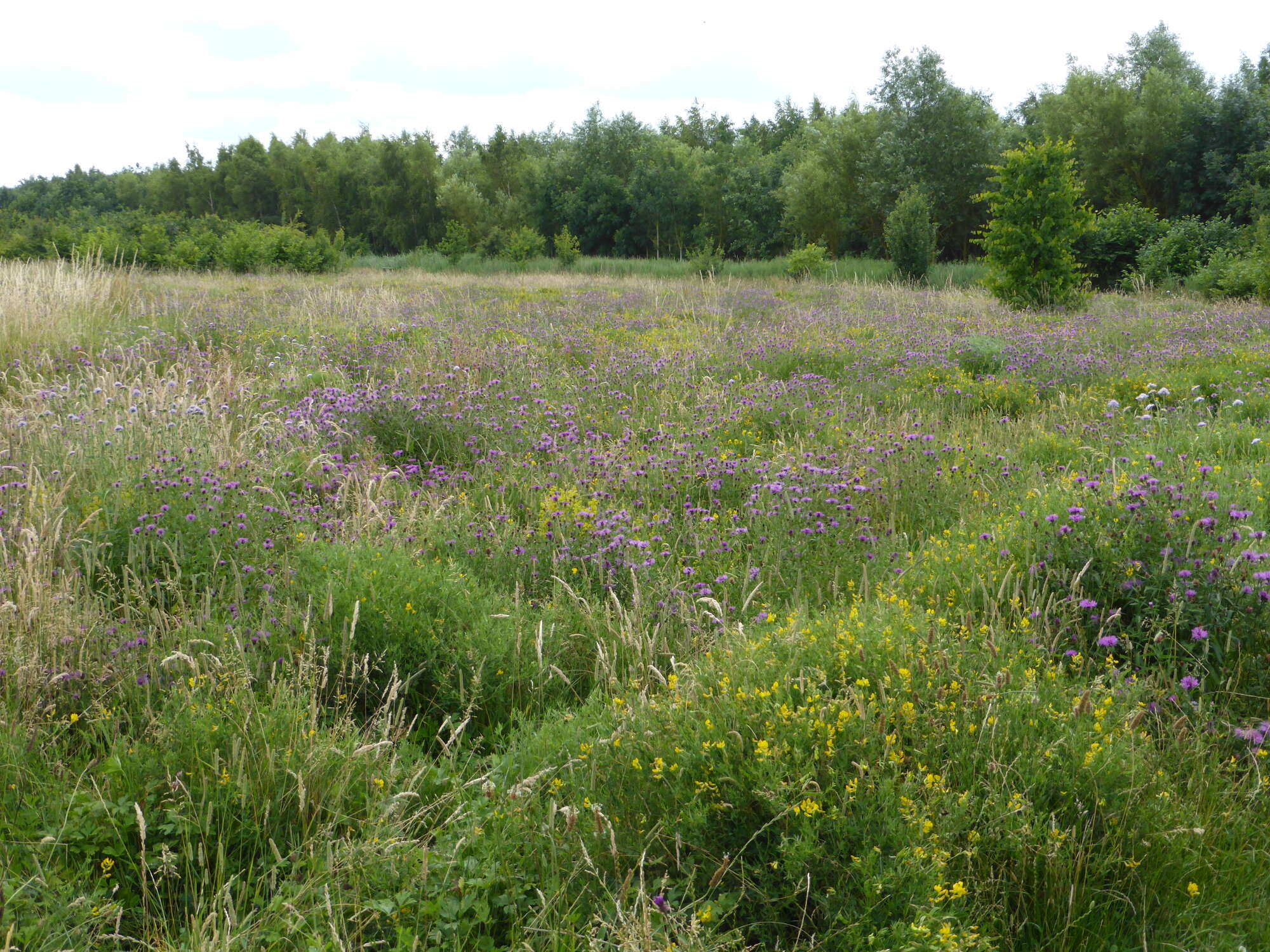 So we transferred no less than 50 pupae and 51 moths to a local large meadow. A sign of the times!
So we transferred no less than 50 pupae and 51 moths to a local large meadow. A sign of the times!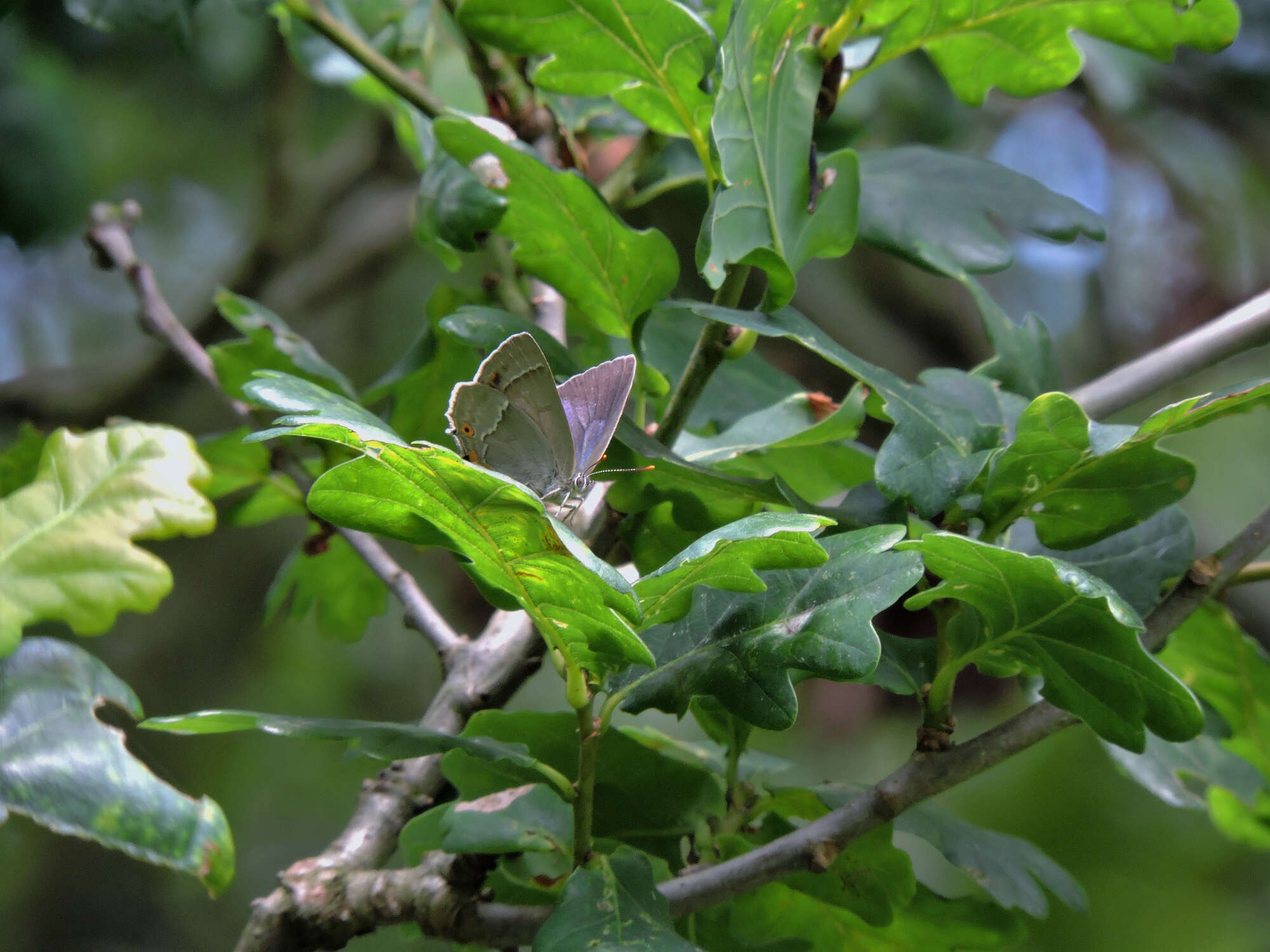 Our biggest success story to date was the unexpected arrival of the Purple Hairstreak .They colonised our oaks and we later found that they had laid eggs!
Our biggest success story to date was the unexpected arrival of the Purple Hairstreak .They colonised our oaks and we later found that they had laid eggs!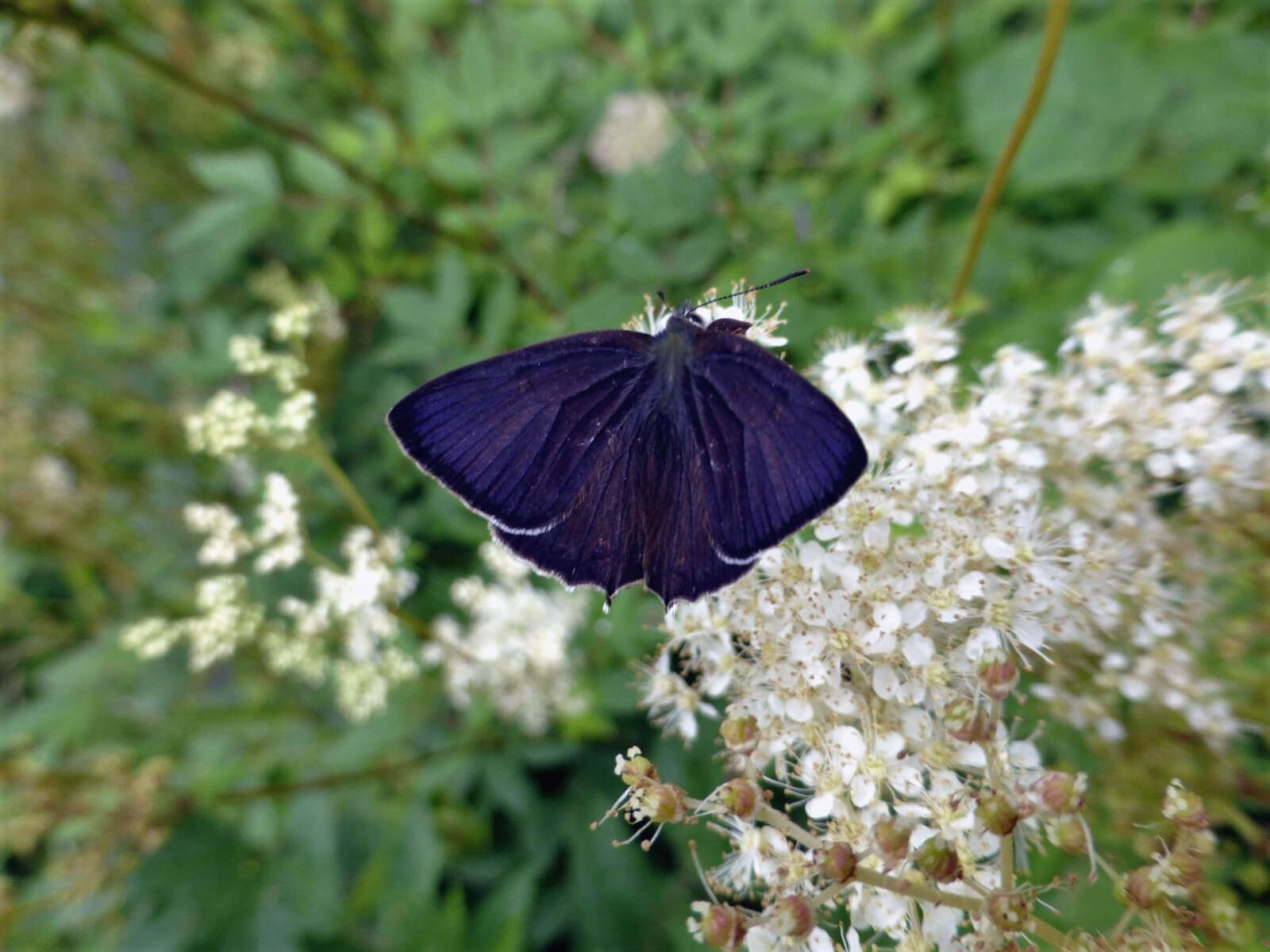 The male with its all over purple sheen.
The male with its all over purple sheen.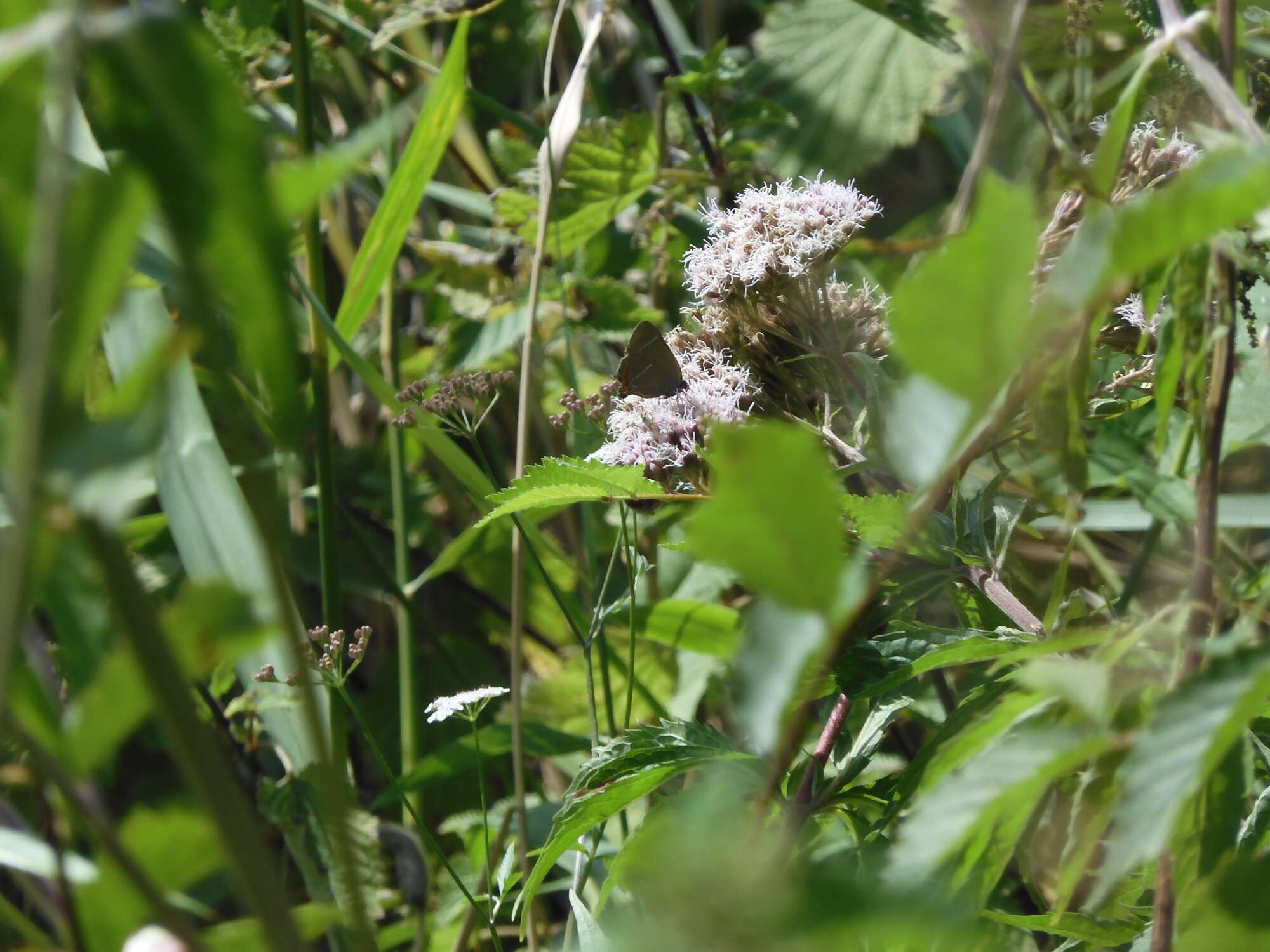 I am quite convinced that a few White-letter Hairstreaks were amongst them in the tree top activity. They are very elusive. Only time will tell...
I am quite convinced that a few White-letter Hairstreaks were amongst them in the tree top activity. They are very elusive. Only time will tell...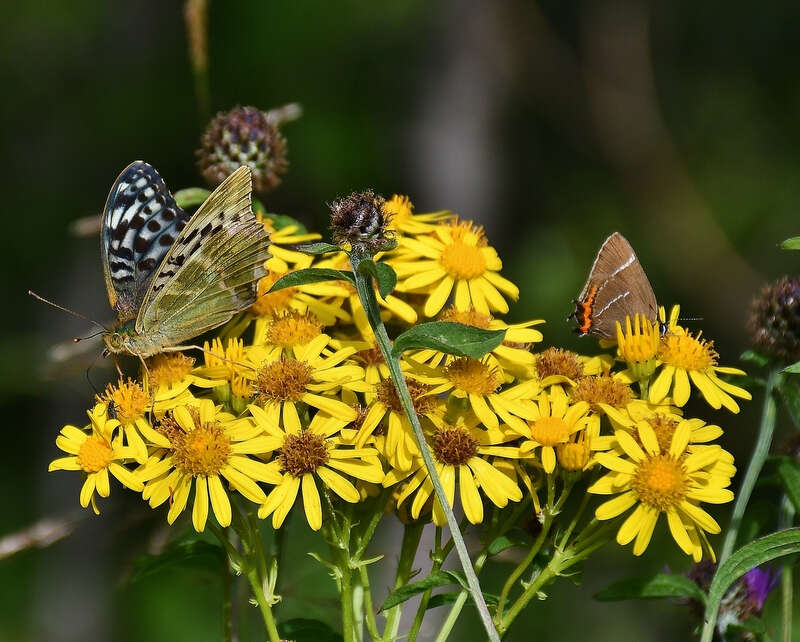 As well as the WLH, I also had a fleeting glance of what I believe to be the rare valezina form of the Silver Washed Fritillary, seen here together elsewhere.
As well as the WLH, I also had a fleeting glance of what I believe to be the rare valezina form of the Silver Washed Fritillary, seen here together elsewhere.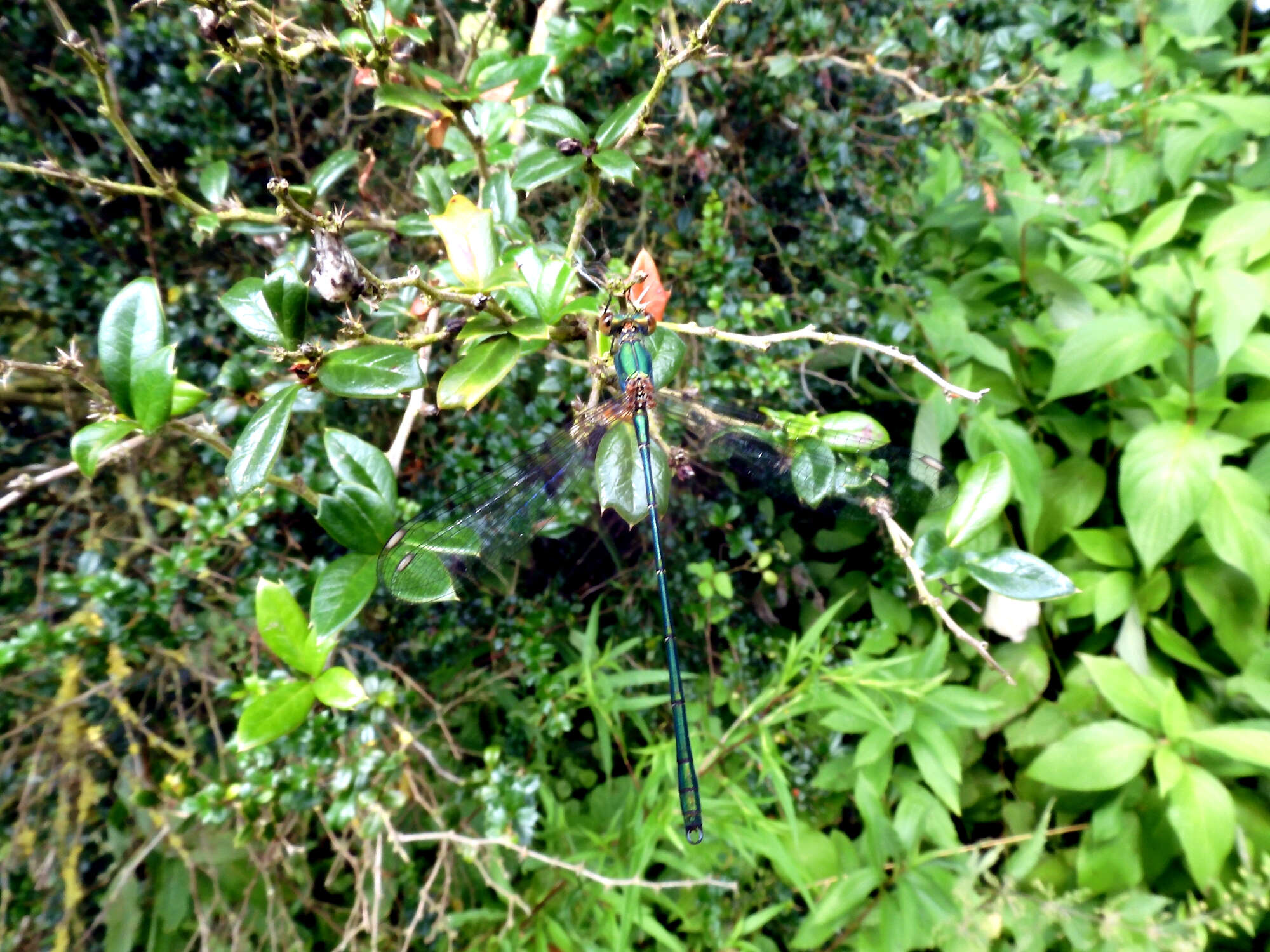 It wasn't just butterflies - the rare Willow Emerald damselfly also showed up in good numbers.
It wasn't just butterflies - the rare Willow Emerald damselfly also showed up in good numbers.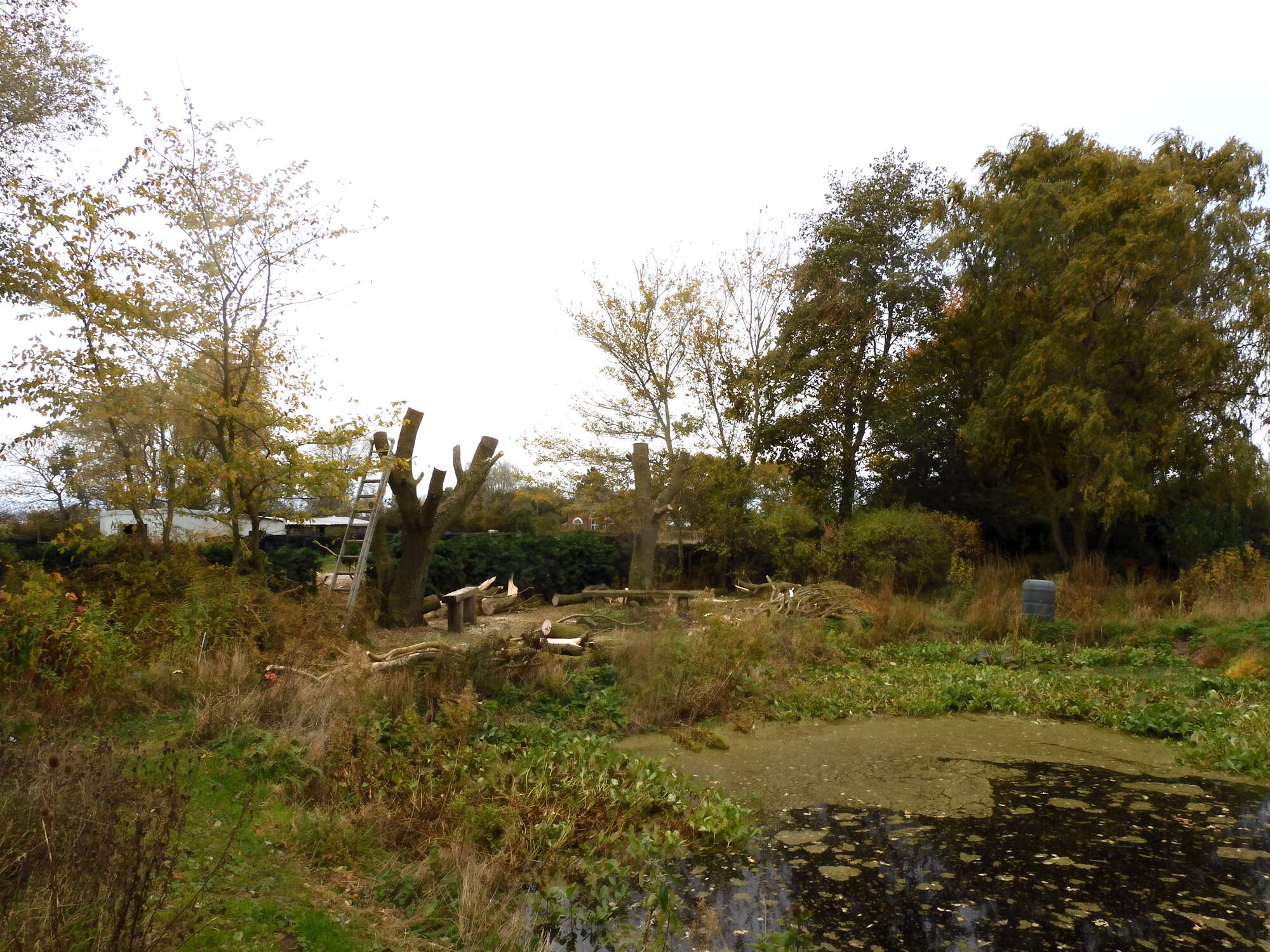 31-10-21. Both weeping willows destroyed by freak wind . It has however created a new open habitat. It must be viewed as evolution of the garden, actually better for butterflies.
31-10-21. Both weeping willows destroyed by freak wind . It has however created a new open habitat. It must be viewed as evolution of the garden, actually better for butterflies.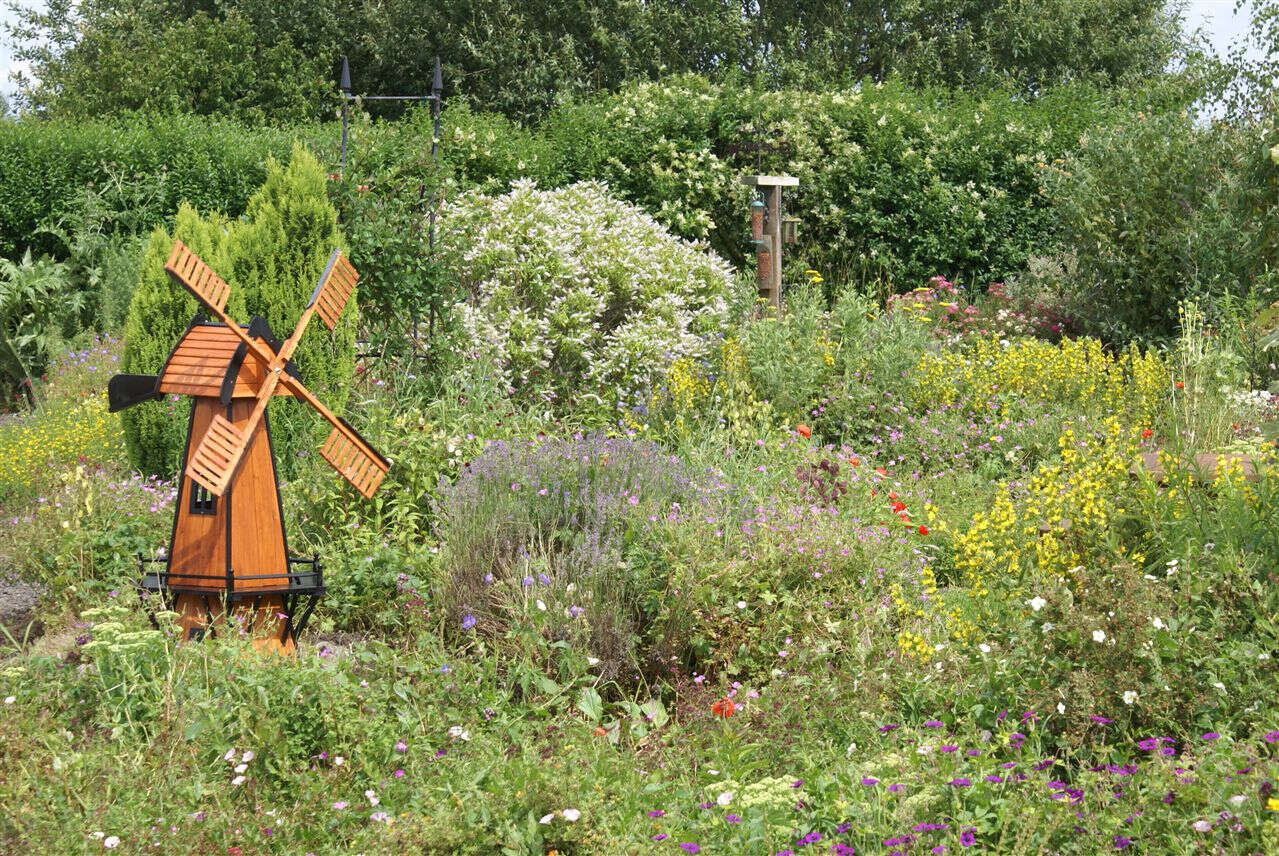 2021 was by far our best year to date. Hopefully our 25th anniversary year will push the boat out even further. Watch this space
2021 was by far our best year to date. Hopefully our 25th anniversary year will push the boat out even further. Watch this space
2022
The spring butterflies did very well, as one would expect following last year’s bumper numbers in general, with the Orange Tip having its second best ever year and the Holly Blue recording its highest ever first brood numbers.
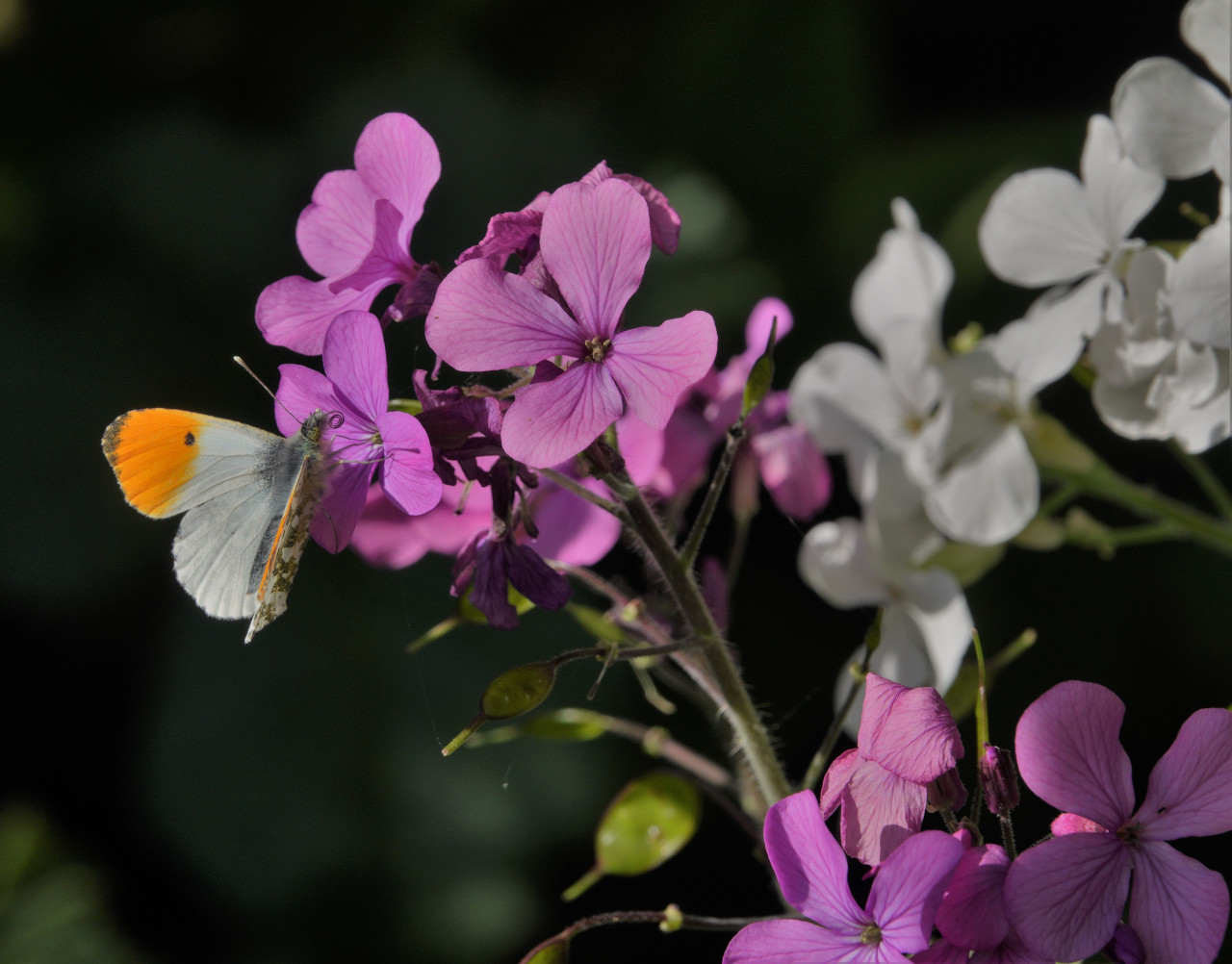 Orange Tip feeding on honsty. Note the proboscis unfolding like a watch spring.
Orange Tip feeding on honsty. Note the proboscis unfolding like a watch spring.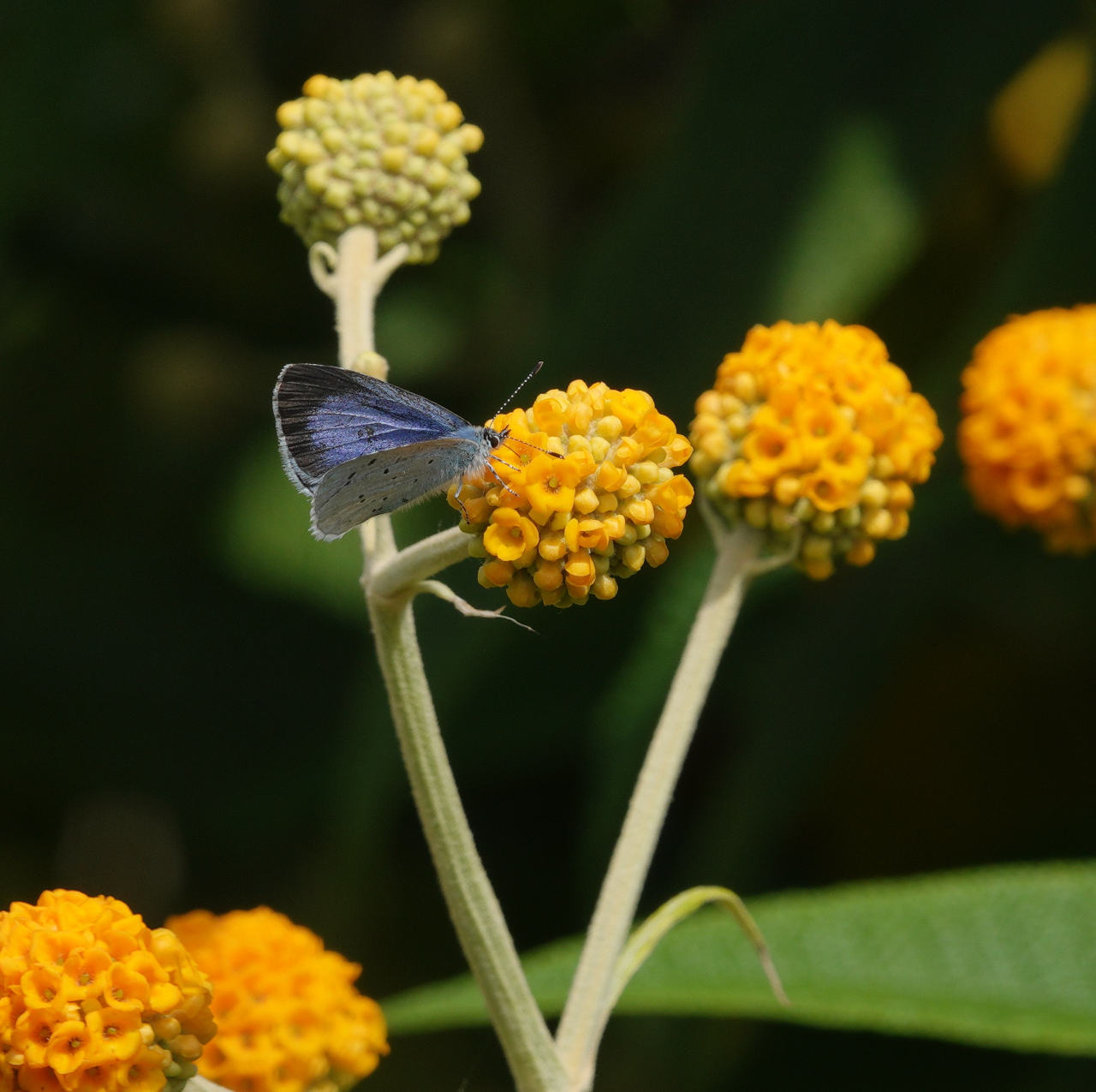 Female Holly Blue making a rare appearance on buddleia globosa.
Female Holly Blue making a rare appearance on buddleia globosa.
As June progressed into July though, it mostly went downhill. 2022 was indeed a year to remember, but mostly for the wrong reasons. There is heat and there is heat. And this was heat. The season was perhaps the most advanced I have ever known and that was before we succumbed to the excessive mid July temperatures, resulting in the third hottest and the driest July since 1935 despite only recording an average maximum temperature of 75ᵒF (24ᵒC). What it will really go down in the record books for is the unbearable hottest day ever recorded in the UK on the 19th July: 104.5ᵒF (40ᵒC). The highest temperatures were actually recorded at their extreme at nearby RAF Coningsby, and ironically back in 1997 it was on the 18th July that we moved in to Windmill Lodge. This short-lived ultra heatwave resulted in desert like conditions with precious little available nectar for the adult butterflies and the all-important larval foodplants were decimated.
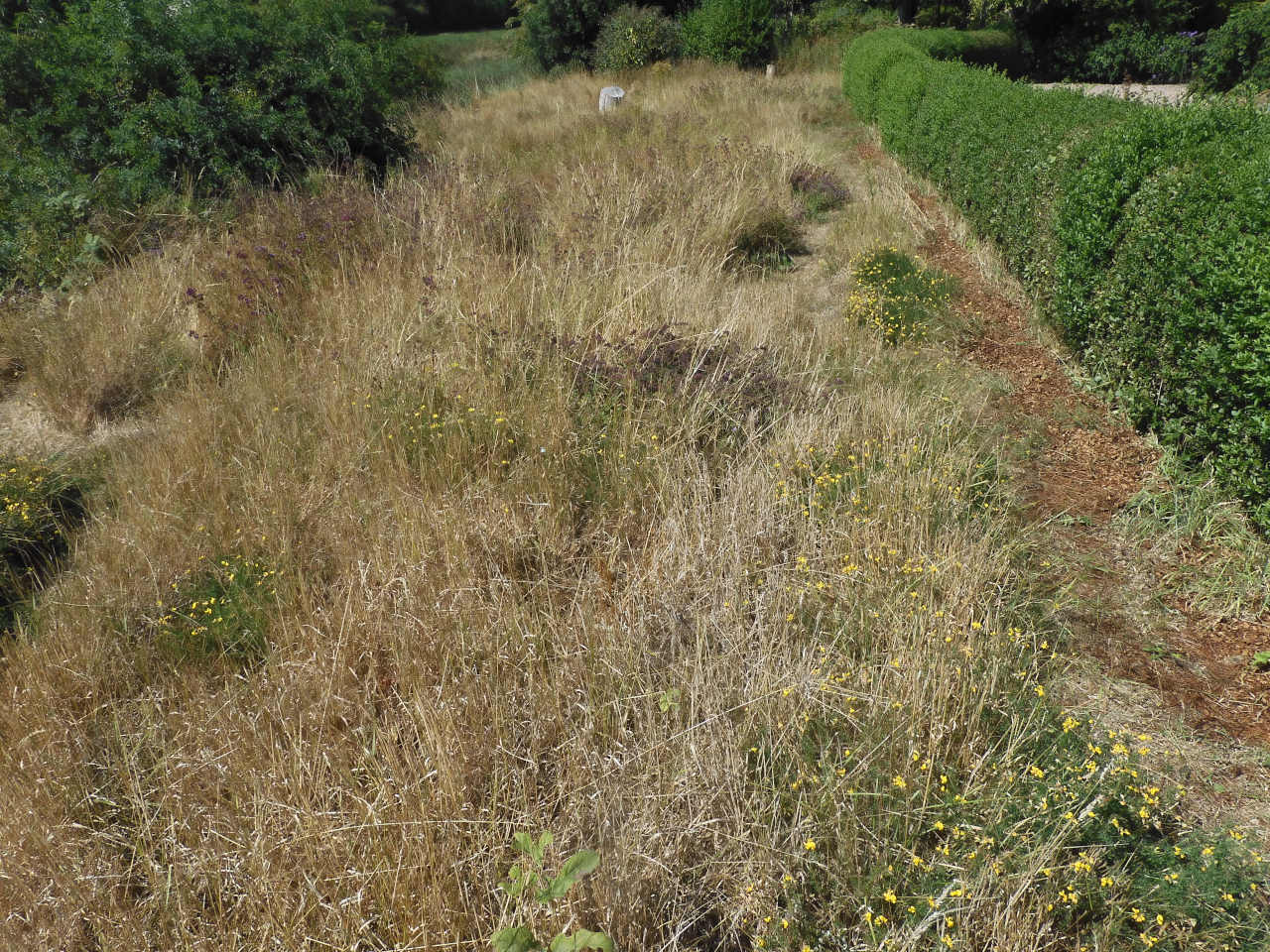 meadow in late July resembling a desert
meadow in late July resembling a desert
As with 1977, following the 1976 drought, entomologists are predicting a way below average butterfly season next year. In most habitats butterfly populations were knocked for six and presumably the incredibly low numbers of summer brood Small Tortoiseshell, Peacock, and Brimstone are down to these awful conditions at a crucial time of their development. Likewise, the second brood of the Holly Blue that did so well in the spring, never really got going. From mid July onwards the butterfly season started to grind to a premature halt, with the August countryside being more akin to October.
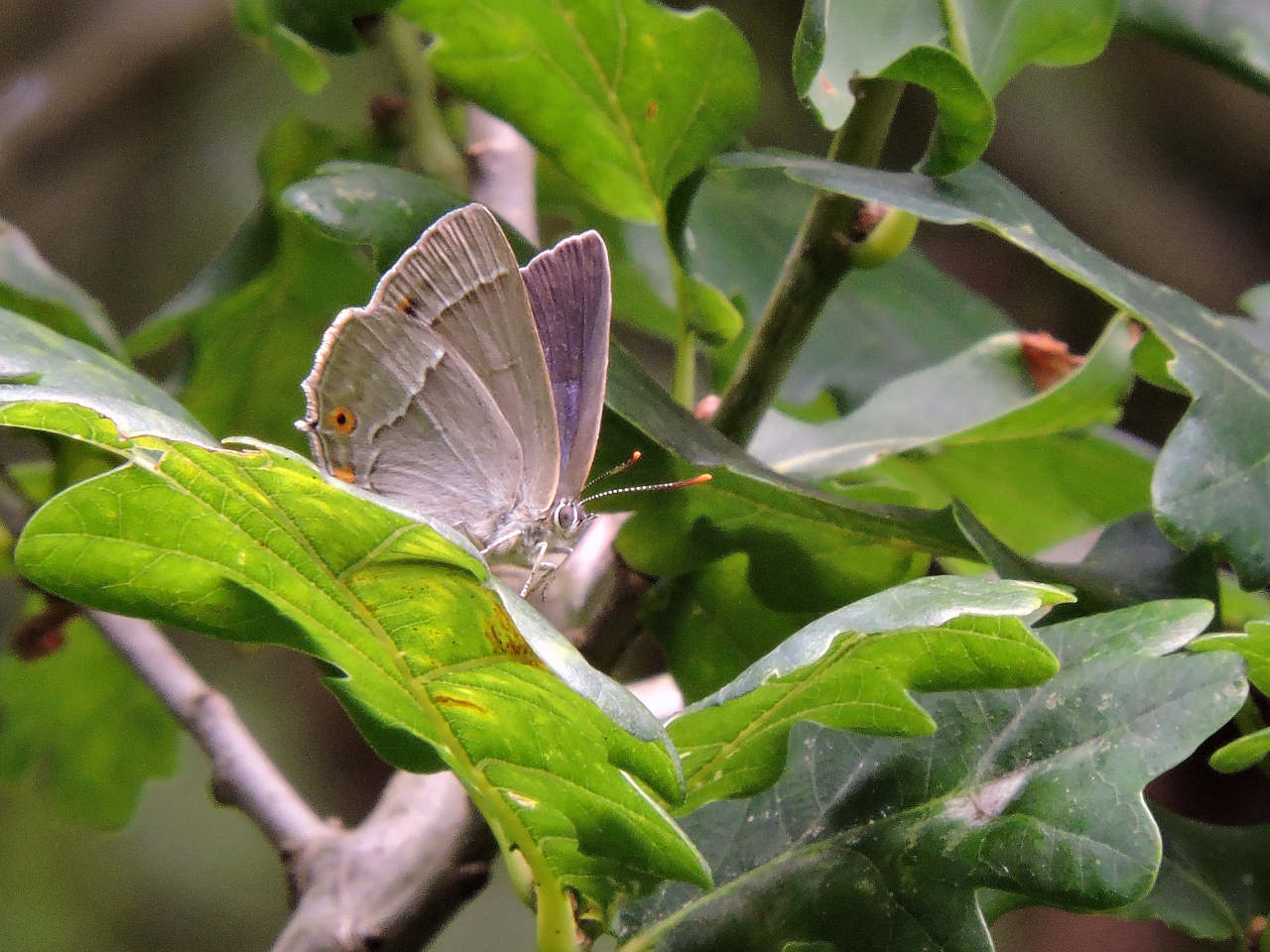 Purple Hairstreak in oak
Purple Hairstreak in oak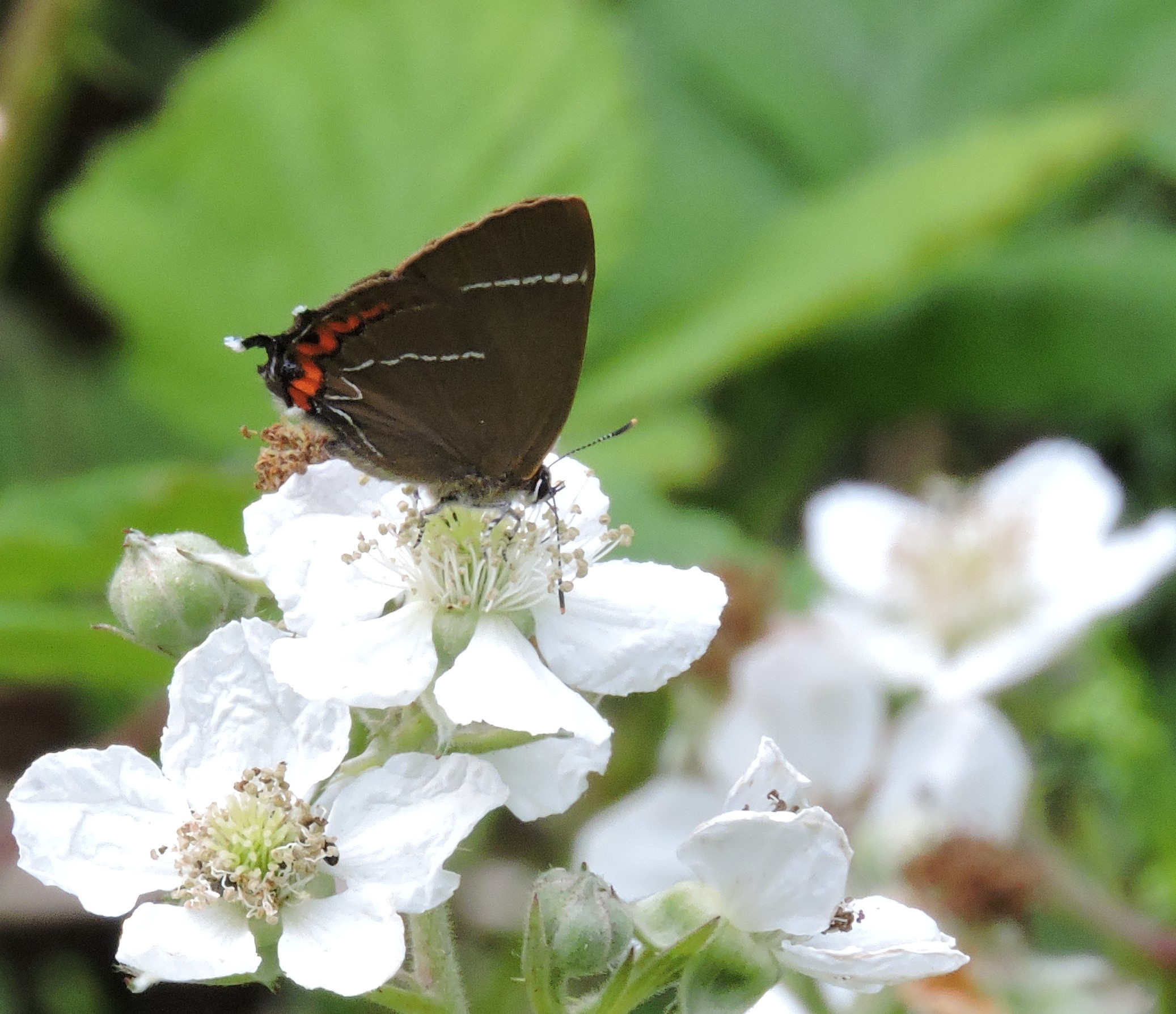 White-letter Hairstreak feeding on bramble
White-letter Hairstreak feeding on bramble
Following on from the unexpected arrival of the Purple Hairstreak last year, the White-letter Hairstreak has at long last followed suit. Let’s hope that both these Hairstreaks remain a very special part of our butterfly itinerary. This year has not been the best one to judge things by!
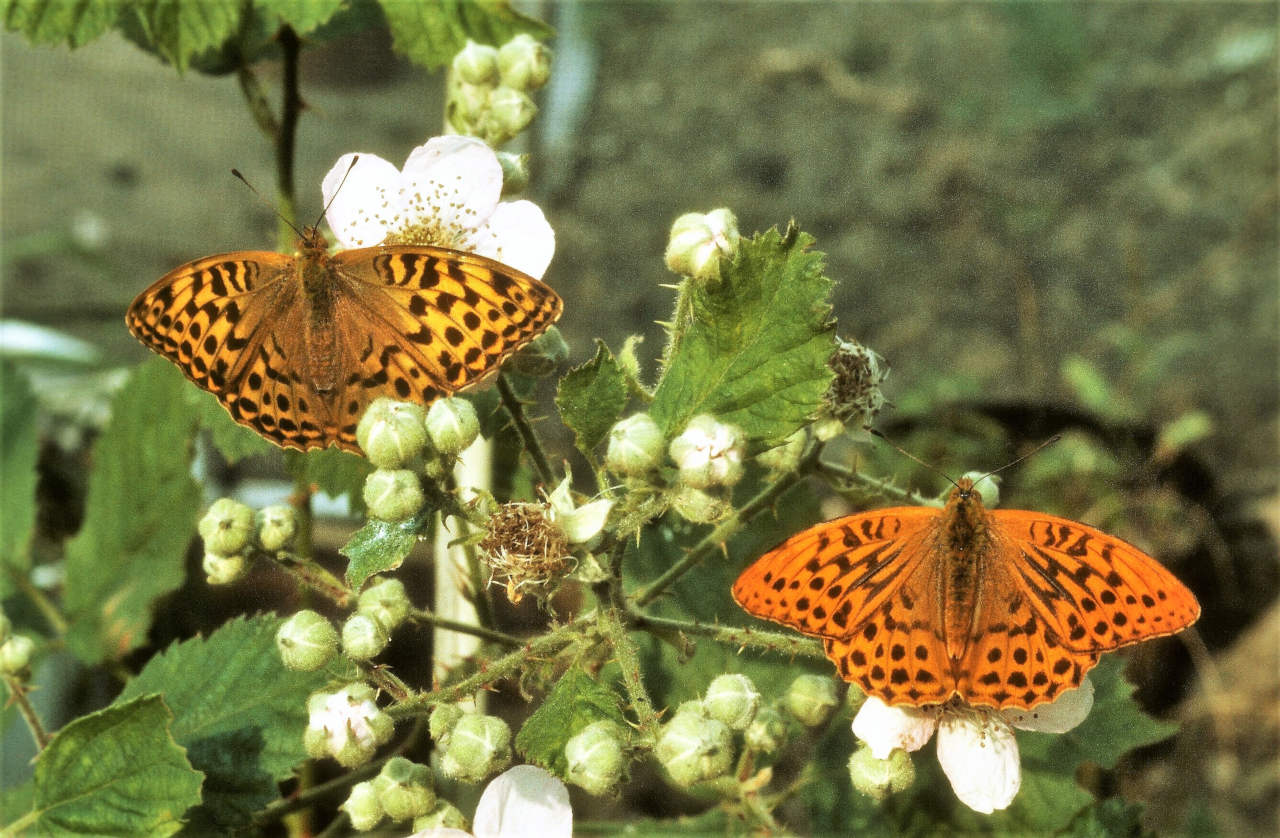 Silver-washed Fritillary, female on the left
Silver-washed Fritillary, female on the left
I witnessed a pristine female Silver-washed Fritillary busying herself in a non typical low level flight around the woodland garden, whereby I assumed she was seeking out violets growing near trees, so she could then lay her eggs on the said trees. I could not manage a photo but this was very encouraging to see and I am predicting that this species will be the next to become resident in our butterfly garden.
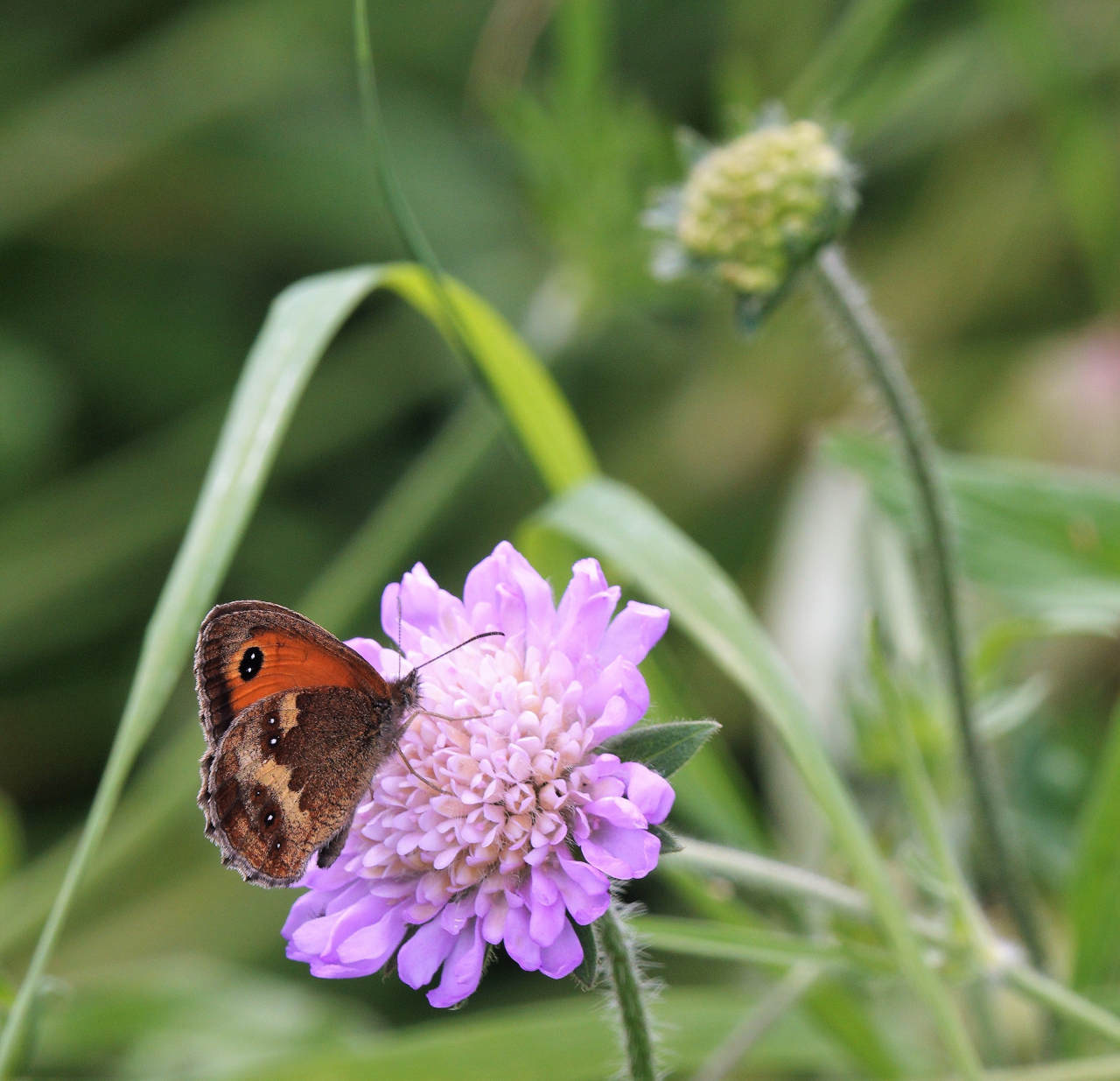 The Gatekeeper feeding on scabious, a classic nectar plant
The Gatekeeper feeding on scabious, a classic nectar plant
It’s not all bad news. Many species did well, albeit having their flight periods cut short, and for the second year running the Gatekeeper absolutely excelled.
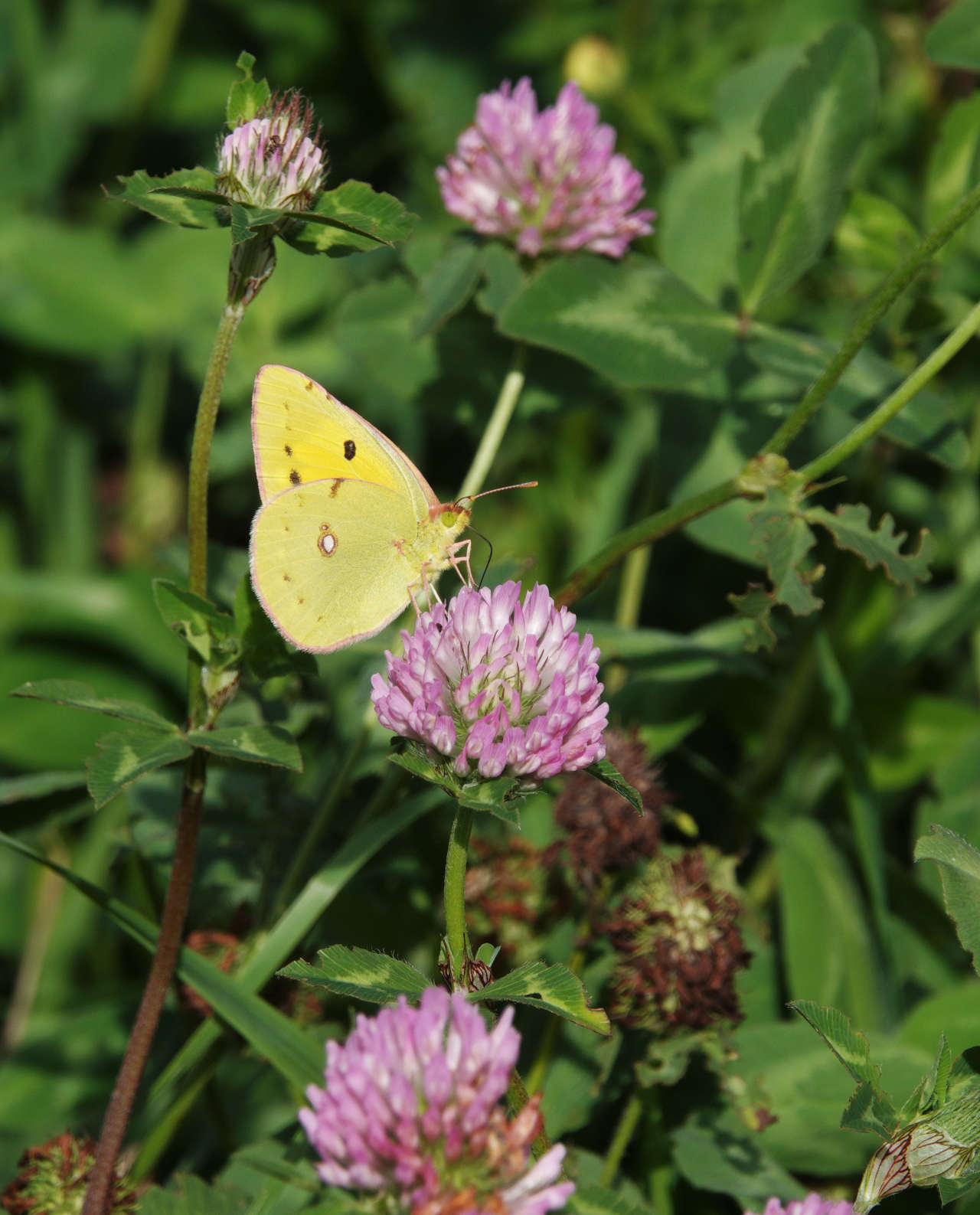 Masses of Clouded Yellows emerge in a nearby clover field during September.
Masses of Clouded Yellows emerge in a nearby clover field during September.
Although not actually seen in our garden as such, the phenomenal huge numbers of the migratory Clouded Yellow concentrated on a nearby clover field – including the rare helice form of the female – quite simply has to be our highlight of the year. What a way to celebrate our 25 years here! Full details of this amazing experience can be found in the September blogs on the news page.